
PHYSICAL
SCIENCES
TERM 3
RESOURCE
PACK
Gr10_Term3_ResourcePack.indb 1 2019/05/31 12:27:51 PM

Contents
Worksheets 3
Topic 17: Reactions of Aqueous Solutions 4
Topic 18: Quantitative Aspects of Chemical Change 10
Topic 19: Vectors and Scalars 21
Topic 20: 1-D Motion, Speed, Velocity and Acceleration 26
Topic 21: Instantaneous Speed and Velocity and Equations of Motion 30
Formal Experiment 55
Technical Instructions 57
Measuring Acceleration 60
Marking Guidelines 67
Assessments 69
Topic 17: Reactions of Aqueous Solutions 70
Topic 18: Quantitative Aspects of Chemical Change 74
Topic 19: Vectors and Scalars 79
Topic 20: 1-D Motion, Speed, Velocity and Acceleration 85
Topic 21: Instantaneous Speed and Velocity and Equations of Motion 92
Gr10_Term3_ResourcePack.indb 2 2019/05/31 12:27:51 PM

WORKSHEETS
Gr10_Term3_ResourcePack.indb 3 2019/05/31 12:27:51 PM

RESOURCE PACK
4 Grade 10 Physical Sciences
WORKSHEET
1. What is meant by the following terms?
1.1 Dissolving (3)
1.2 Hydration (3)
2. Write down balanced reaction equations for each of the following substances
dissolving in water:
2.1 Na
2
SO
4
(3)
2.2 A
2
(CO
3
)
3
(3)
2.3 Cu(NO
3
)
2
(3)
3. Describe the process by which ionic substances dissolve in water. (5)
4. 4.1 Describe a circuit which can be set up to determine whether solutions conduct
electricity. (5)
4.2 What must be present in a solution for it to be able to conduct electricity? (1)
5. Write down balanced full ionic equations to represent the following reactions:
5.1 Lead(II) nitrate reacts with potassium iodide. (4)
5.2 Copper(II) chloride reacts with dihydrogen sulde. (4)
6. 6.1 Describe a test that can be used to determine whether a solution possibly
contains sulfate ions. (4)
6.2 Write down a balanced reaction equation that occurs during the test, if the solution
contained potassium sulfate (K
2
SO
4
). (4)
7. 7.1 Describe a test that can be used to test for the presence of chloride ions in a
solution. (4)
7.2 Write down a balanced net ionic equation to represent the reaction, if the solution
contained magnesium chloride (MgC
2
). (3)
Gr10_Term3_ResourcePack.indb 4 2019/05/31 12:27:51 PM

Term 3 5
TOPIC 17: REACTIONS OF AQUEOUS SOLUTIONS
WORKSHEETS TOPIC 17
8. ree colourless solutions, A, B and C, contain potassium iodide, sodium carbonate
and magnesium sulfate respectively. When barium chloride is added to solution A,
the solution remains colourless. When barium chloride solution is added to B and
C, a white precipitate is formed in both cases. When some dilute nitric acid is added
to the precipitate in solution B, the precipitate dissolves.
Identify A, B and C. Give reasons for your choice. (5)
9. Why are precipitation reactions, gas forming reactions and acid base reactions
described as ion exchange reactions? (2)
10. Identify the reaction types represented in each of the following equations:
10.1 2KOH(aq) + H
2
SO
4
(aq) K
2
SO
4
(aq) + 2H
2
O(l)
10.2 2AgNO
3
(aq) + CaC
2
(aq) 2AgC(s) + Ca(NO
3
)
2
(aq)
10.3 2HNO
3
(aq) + Mg(OH)
2
(aq) Mg(NO
3
)
2
(aq) + 2H
2
O(l)
10.4 Na
2
CO
3
(aq) + 2HC(aq) 2NaC(aq) + H
2
O(l) + CO
2
(g) (8)
Gr10_Term3_ResourcePack.indb 5 2019/05/31 12:27:51 PM

RESOURCE PACK
6 Grade 10 Physical Sciences
CONSOLIDATION QUESTIONS
TOTAL: 73 MARKS
1. Write down balanced reaction equations for each of the following substances
dissolving in water. Include phase symbols.
1.1 Ammonium nitrate (4)
1.2 Aluminium hydrogen sulfate (4)
1.3 Iron(III) dichromate (4)
2. 2.1 What is an electrolyte? (3)
2.2 Give an explanation for the fact that a solution of potassium chloride can conduct
electricity. Make use of a balanced reaction equation in your explanation. (6)
3. 3.1 Give an explanation for the fact that even though sugar is soluble in water, a
sugar solution does not conduct electricity. (3)
3.2 How do the following factors aect the conductivity of a solution?
3.2.1 e concentration of ions in a solution. (2)
3.2.2 e type of substance in a solution. (2)
4. 4.1 Describe a test that can be carried out to determine whether a solution contains
iodide ions. (4)
4.2 Write down a balanced reaction equation for the test if the solution is sodium
iodide. (4)
5. Write down balanced full ionic equations for the reactions between:
5.1 potassium bromide and silver nitrate. (4)
5.2 barium chloride and potassium carbonate. (4)
5.3 barium chloride and calcium sulfate. (4)
6. Silver nitrate reacts with HBr to produce a precipitate.
6.1 Name and give the colour of the precipitate formed during this reaction. (2)
6.2 Write down a balanced equation for this reaction. (4)
6.3 Write down an equation for the net ionic reaction that occurs. (3)
7. Two test tubes each contain a solution of either potassium carbonate or sodium sulfate.
7.1 Describe in detail how you would distinguish between the two solutions. (4)
7.2 Write down the equations for the reactions that occur in the test tube containing
potassium carbonate during the tests which are carried out on it. (8)
7.3 Write down the equation for the reaction that occurs in the test tube containing
sodium sulfate during the test which is carried out on it. (4)
Gr10_Term3_ResourcePack.indb 6 2019/05/31 12:27:51 PM
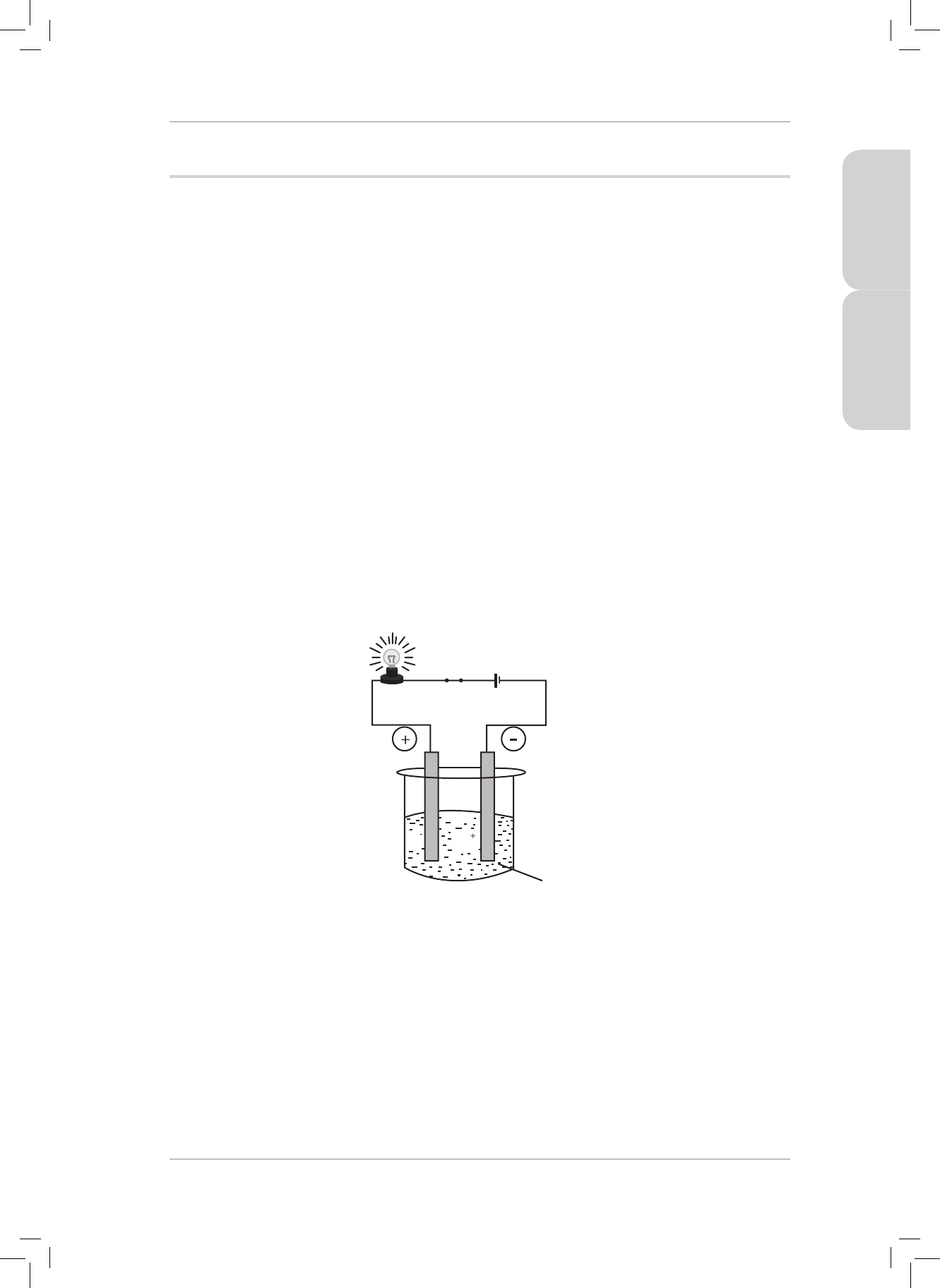
Term 3 7
TOPIC 17: REACTIONS OF AQUEOUS SOLUTIONS
WORKSHEETS TOPIC 17
MARKING GUIDELINES
1. 1.1 e process of dissolving occurs when solid crystals break up into their ions
or moleculesin water.
(3)
1.2 Hydration is the process in which ions become surrounded by water molecules
in aqueous solution. (3)
2. 2.1 Na
2
SO
4
(s) 2Na
+
(aq) + SO
4
2−
(aq) phases (3)
2.2 A
2
(CO
3
)
3
(s) 2A
3+
(aq) + 3CO
3
2−
(aq) phases (3)
2.3 Cu(NO
3
)
2
(s) Cu
2+
(aq) + 2NO
3
−
(aq) phases
(3)
3. When ionic compounds are placed in water, the positive ends of the water molecules
are attracted to the anions and the negative ends are attracted to the cations. e
combined attractions of the water molecules on the ions are suciently strong to
break the ionic bonds and to remove the ions from the lattice. (5)
4. 4.1 e circuit consists of a battery or cell connected in series with a switch
and a light bulb. Also in series are two carbon electrodes each of which is
connected to the opposite terminals of the battery. (5)
e illustration below is for clarity:
Anode Cathode
Sodium chloride
CI Na
S
4.2 For a solution to conduct electricity there must be ions present in the solution. (1)
5. 5.1 Pb
2+
(aq) + 2NO
3
−
(aq) + 2K
+
(aq) + 2I
−
(aq) PbI
2
(s) + 2K
+
(aq) + 2NO
3
−
(aq)
(4)
5.2 Cu
2+
(aq) + 2C
−
(aq) + 2H
+
(aq) + S
2−
(aq) CuS(s) + 2H
+
(aq) + 2C
−
(aq) (4)
Note that suldes of the transition metals are generally insoluble in water.
Gr10_Term3_ResourcePack.indb 7 2019/05/31 12:27:52 PM

RESOURCE PACK
8 Grade 10 Physical Sciences
6. 6.1 To test for the presence of sulfate ions in a solution, add a few drops of BaC
2
solution to the test solution. If a white precipitate forms, add a few drops
of dilute nitric acid. If the precipitate does not dissolve, the test solution
contains sulfate ions. (4)
6.2 K
2
SO
4
(aq) + BaC
2
(aq) 2KC(aq) + BaSO
4
(s) (4)
7. 7.1 To test for the presence of chloride ions in a solution, add a few drops of
AgNO
3
solution to the test solution. If a white precipitate forms, add a few
drops of dilute nitric acid. If the precipitate does not dissolve, the solution
contains chloride ions. (4)
7.2 2C
−
(aq) + 2Ag
+
(aq) 2AgC(s) (3)
Note that the other ions, Mg
2+
and NO
3
−
are also present but they are spectator ions.
8. e fact that barium chloride solution gives no precipitate indicates that solution A
must be potassium iodide. When barium chloride is added to potassium iodide,
no insoluble substance is formed, thus no precipitate.
e precipitate formed in B and C dissolves in nitric acid in B but not in C. this
indicates that B is sodium carbonate and C must be magnesium sulfate. (5)
9. ey are called ion exchange reactions because the cations exchange anions and
the reaction occurs as a result of this exchange. (2)
10. 10.1 Acid base reaction (A salt and water are formed.) (2)
10.2 A precipitation reaction (One of the products is a solid.) (2)
10.3 Acid base reaction (A salt and water are formed.) (2)
10.4 A gas forming reaction (One of the products is a gas.) (2)
Gr10_Term3_ResourcePack.indb 8 2019/05/31 12:27:52 PM

Term 3 9
TOPIC 17: REACTIONS OF AQUEOUS SOLUTIONS
WORKSHEETS TOPIC 17
CONSOLIDATION QUESTIONS
TOTAL: 73 MARKS
1. 1.1 NH
4
NO
3
(s) NH
4
+
(aq) + NO
3
−
(aq) phases (4)
1.2 A(HSO
4
)
3
(s) A
3+
(aq) + 3HSO
4
−
(aq) phases (4)
1.3 Fe
2
(Cr
2
O
7
)
3
(s) 2Fe
3+
(aq) + 3Cr
2
O
7
2−
(aq) phases (4)
2. 2.1 An electrolyte is a solution that contains ions and can conduct electricity. (3)
2.2 Potassium chloride dissolves in water by dissociating as shown in the equation below:
KC(s) K
+
(aq) + C
−
(aq)
e solution thus contains positive and negative ions. e positive ions move to
the negative electrode and the negative ions move to the positive electrode. is
completes the circuit OR is constitutes a ow of charge through the circuit. (6)
3. 3.1 Sugar dissolves in water but does not give rise to ions during the solution
process. ere are no free charges that can move to produce a current. (3)
3.2 3.2.1 e higher the concentration of ions in a solution, the greater the current
through the solution.
3.2.2 e type of substance aects the current in that some ionic substances
dissolve to a greater extent than others, thereby releasing more ions in
solution, and making them better conductors. Other substances, such as
sugar, do not release ions in solution and therefore do not conduct current.
(4)
4. 4.1 Add a few drops of silver nitrate solution to the test solution. If a yellow
precipitate forms, add a few drops of dilute nitric acid. If the precipitate
does not dissolve, the test solution contains iodide ions. (4)
4.2 NaI(aq) + AgNO
3
(aq) AgI(s) + NaNO
3
(aq) (4)
5. 5.1 K
+
(aq) + Br
−
(aq) + Ag
+
(aq) + NO
3
−
(aq) AgBr(s) + K
+
(aq) + NO
3
−
(aq) (4)
5.2 Ba
2+
(aq) + 2C
−
(aq) + 2K
+
(aq) + CO
3
2−
(aq) BaCO
3
(s) + 2K
+
(aq) + 2C
−
(aq)
(4)
6. 6.1 A light yellow precipitate of silver bromide is formed. (2)
6.2 AgNO
3
(aq) + HBr(aq) AgBr(s) + HNO
3
(aq) (4)
6.3 Ag
+
(aq) + Br
−
(aq) AgBr(s) (3)
7. 7.1 Add a few drops of barium chloride solution to each test tube. In both test
tubes a white precipitate will appear. Now add a few drops of dilute nitric
acid to each test tube. e test tube in which the precipitate dissolves is the
potassium carbonate solution. (4)
7.2 BaC
2
(aq) + K
2
CO
3
(aq) BaCO
3
(s) + 2KC(aq)
BaCO
3
(s) + 2HNO
3
(aq) Ba(NO
3
)
2
(aq) + CO
2
(g) + H
2
O(l) (8)
7.3 BaC
2
(aq) + Na
2
SO
4
(aq) BaSO
4
(s) + 2NaC(aq) (4)
Gr10_Term3_ResourcePack.indb 9 2019/05/31 12:27:52 PM

RESOURCE PACK
10 Grade 10 Physical Sciences
Chemical Change
WORKSHEET
1. What is meant by each of the following terms?
1.1 Molar mass (2)
1.2 Relative formula (or molecular mass) (3)
1.3 A mole (3)
2. 2.1 What is the SI unit for amount of substance? (1)
2.2 Calculate the relative molecular mass of:
2.2.1 H
2
CO
3
(2)
2.2.2 CC
4
(2)
3. 3.1 Calculate the relative formula mass of the following substances:
3.1.1 CaSO
4
(2)
3.1.2 KMnO
4
(2)
3.2 Calculate the molar masses of the following substances:
3.2.1 K
2
Cr
2
O
7
(3)
3.2.2 H
3
PO
4
(3)
4. Calculate the following quantities:
4.1 e number of moles in 200 g of water. (3)
4.2 e mass of 3,60 moles of NO
2
gas. (3)
4.3 e number of moles of molecules in 8,96 dm
3
of nitrogen gas at STP. (3)
5. 10 g of a pure sample of a specic compound is found to contain 4,0 g of carbon,
0,67 g of hydrogen and 5,33 g of oxygen. Determine the empirical formula of the
compound. (5)
6. Calculate the percentage of water of crystallisation in Na
2
CO
3
10H
2
O. (4)
7. Sulfur(IV) oxide reacts with oxygen gas according to the following balanced
reaction equation:
2SO
2
(g) + O
2
(g) 2SO
3
(g)
6 moles of SO
2
react with oxygen in a closed container. Calculate:
7.1 the number of moles of SO
3
(g) that form when all the SO
2
(g) reacts. (2)
7.2 the total volume of gas in the container when the reaction is complete. (4)
Gr10_Term3_ResourcePack.indb 10 2019/05/31 12:27:52 PM

Term 3 11
TOPIC 18: QUANTITATIVE ASPECTS OF CHEMICALCHANGE
WORKSHEETS TOPIC 18
8. Aluminium burns in chlorine according to the following balanced reaction equation:
2A(s) + 3C
2
(g) 2AC
3
(s)
Calculate the volume (at STP) of C
2
(g) required to react completely with 30 g of
aluminium metal according to the equation given. (5)
9. Nitrogen monoxide and carbon monoxide react according to the following balanced
reaction equation:
2NO(g) + 2CO(g) N
2
(g) + 2CO
2
(g)
50 g of NO(g) react completely. Calculate:
9.1 the mass of carbon dioxide which is produced. (4)
9.2 the volume of nitrogen gas produced at STP. (4)
10. Tin(IV) oxide reacts with hydrogen gas according to the following balanced reaction
equation:
SnO
2
(s) + 2H
2
(g) Sn(s) + 2H
2
O(g)
Calculate the mass of Sn(s) produced when 4,48 dm
3
of hydrogen gas reacts
completely at STP. (5)
Gr10_Term3_ResourcePack.indb 11 2019/05/31 12:27:52 PM

RESOURCE PACK
12 Grade 10 Physical Sciences
CONSOLIDATION QUESTIONS
TOTAL: 69 MARKS
1. 1.1 Dene the term “molar volume”. (2)
1.2 Calculate the number of moles in 2,24 dm
3
of neon gas at STP. (3)
1.3 Calculate the volume occupied by 5,6 g of nitrogen gas at STP. (5)
2. A solution is made up by dissolving 12,5 g of magnesium uoride in sucient water
to make up 0,5 dm
3
of solution. Calculate the concentration of the solution. (4)
3. It is necessary to make up a solution of oxalic acid (COOH)
2
in the laboratory. e
concentration of the solution must be 0,1 moldm
−3
. e container available for
making up the solution has a volume of 0,25 dm
3
. Calculate the mass of oxalic acid
required for the solution. (5)
4. Determine the percentage composition by mass of KMnO
4
. (4)
5. 5.1 What is meant by the term “empirical formula”? (3)
5.2 A sample of a compound is found to contain 6 g of carbon, 0,5 g of hydrogen and
17,75 g of chlorine. Determine the empirical formula of the compound. (5)
6. Determine the empirical formula of compound which has the following percentage
composition by mass:
Cr = 35,37%
K = 26,53%
O = 38,10% (5)
7. 7.1 Calculate the number of moles of oxygen atoms in 196 g of H
2
SO
4
. (4)
7.2 Calculate the mass of 8,4 mol of NH
3
. (3)
8. Urea is a fertiliser made by the reaction of ammonia with carbon dioxide according
to the following balanced reaction equation:
2NH
3
(g) + CO
2
(g) (NH
2
)
2
CO(s) + H
2
O(g)
800 g of CO
2
(g) reacts completely with ammonia. Calculate:
8.1 the mass of urea, (NH
2
)
2
CO, that is produced. (5)
8.2 the volume of H
2
O(g) produced at STP. (3)
Gr10_Term3_ResourcePack.indb 12 2019/05/31 12:27:52 PM

Term 3 13
TOPIC 18: QUANTITATIVE ASPECTS OF CHEMICALCHANGE
WORKSHEETS TOPIC 18
9. e balanced chemical equation for the reaction that occurs when hydrogen gas and
oxygen gas react is:
2H
2
(g) + O
2(
g) 2H
2
O(g)
9.1 How many moles of oxygen gas react with 0,5 mol of hydrogen gas? (1)
9.2 24 g of oxygen gas react completely, calculate the mass of water vapour that is
formed. (5)
9.3 If 50 dm
3
of oxygen gas react completely. Calculate the volume of water vapour
produced in this reaction at STP. (5)
10. e balanced reaction equation represents the reaction that occurs when methane
gas burns in air:
CH
4
(g) + 2O
2
(g) CO
2
(g) + 2H
2
O(g)
10.1 What is the SI unit for amount of matter? (1)
10.2 How many moles of methane react with oxygen to produce 6 moles of water? (1)
10.3 Calculate the mass of carbon dioxide produced if 48 g of oxygen gas react
completely with methane. (5)
Gr10_Term3_ResourcePack.indb 13 2019/05/31 12:27:52 PM

RESOURCE PACK
14 Grade 10 Physical Sciences
MARKING GUIDELINES
1. 1.1 Molar mass is the mass of one mole of any substance, expressed in grams. (2)
1.2 Relative formula or molecular mass is the sum of the relative atomic masses of
each of the atoms making up a formula unit or a molecule. (3)
1.3 One mole is the amount of substance that contains as many elementary
particles as there are atoms in 12 g of carbon-12. (3)
2. 2.1 e SI unit for amount of substance is the mole. (1)
2.2 2.2.1 M
r
(H
2
CO
3
) = (2 × 1) + 12 + (3 × 16)
= 62 (N.B. no units) (2)
2.2.2 M
r
(CC
4
) = 12 + (4 × 35,5)
= 154 (No units) (2)
3. 3.1 3.1.1 M
r
(CaSO
4
) = 40 + 32 + (4 × 16)
= 136 (No units) (2)
3.1.2 M
r
(KMnO
4
) = 39 + 55 + (4 × 16)
= 158 (No units) (2)
3.2 3.2.1 M(K
2
Cr
2
O
7
) = (2 × 39) + (2 × 52) + (7 × 16)
= 294 gmol
−1
(3)
3.2.2 M(H
3
PO
4
) = (3 × 1) + 31 + (4 × 16)
= 98 gmol
−1
(3)
4. 4.1
,
HOn
M
m
18
200
11 11 molofmolecules
2
{
{
=
=
=
^h
(3)
4.2
,
,
n
M
m
mnM
36 46
165 6
g
#
#
{
{
{
=
=
=
=
M(NO
2
) = 14 + (2 × 16)
= 46 gmol
−1
(3)
4.3
,
,
,
n
V
V
22 4
896
04
mol
m
{{
{
=
=
=
Gr10_Term3_ResourcePack.indb 14 2019/05/31 12:27:55 PM

Term 3 15
TOPIC 18: QUANTITATIVE ASPECTS OF CHEMICALCHANGE
WORKSHEETS TOPIC 18
5. First calculate the number of moles of each element:
,n
M
m
12
4
033
C
{
===
,
,n
M
m
1
067
067
H
{
== =
,
,n
M
m
16
533
033
O
{
== =
Dividing by 0,33 gives a ratio of C:H:O = 1: 2: 1
Empirical formula is CH
2
O (5)
6. First calculate the molar mass of the compound:
.
.
Na CO HO
gmol
M 10 22312316 10 21 16
286
23 2
1
###
{
=+++ +
=
-
^^^hhh
6
6
@
@
Now calculate the molar mass of the water:
.
,%
HO
gmol
M 10 21 16
180
286
180
62 94
%water
2
1
#
{
{
{
=+
=
=
=
-
^
^
h
h
(4)
7. 7.1 According to the balanced equation 1 mol SO
2
produces 1 mol SO
3
So, 6 mol SO
2
produces 6 mol SO
3
. (2)
7.2 When the reaction is complete only SO
3
is present in the container, i.e. 6 mol SO
3
.
,
,
n
V
V
VnV
6224
134 4 dm
m
m
3
#
#
{
{{
{
=
=
=
=
(4)
8. First calculate the number of moles of aluminium:
,
n
M
m
27
30
111 mol
{
{
=
=
=
According to the equation, 2 mol A reacts with 3 mol C
2
So, 1,11 mol A reacts with 1,11 × 3/2 mol C
2
= 1,67 mol C
2
()
,
,
mnM
16771
118 57
C
gofC
2
2
#
#
,
,
{
{
=
=
=
(5)
Gr10_Term3_ResourcePack.indb 15 2019/05/31 12:28:00 PM

RESOURCE PACK
16 Grade 10 Physical Sciences
9. 9.1 First convert the NO to moles:
,
n
M
m
30
50
167
mol
{
{
=
=
=
From the equation we see that 1 mol NO produces 1 mol CO
2
So, 1,67 mol NO produces 1,67 mol CO
2
,
,
COmnM
16744
73 48
g
2
#
#
{
{
=
=
=
^h
(4)
9.2 We now look at the mole ratio of NO to N
2
:
2 mol NO produces 1 mol N
2
1,67 mol NO produces 0,835 mol N
2
,,
,
N
dm
n
V
V
vnV
0 835 22 4
18 70
m
m
2
3
#
#
{
{
=
=
=
=
^h
(4)
10. Begin by converting the volume to moles:
,
,
,mol
n
V
V
22 4
448
02
m
{
{
=
=
=
2 mol H
2
produces 1 mol Sn
0,2 mol H
2
produces 0,1 mol Sn
()
,,
,
Sn
g
mnM
01 118 7
11 87
#
#
{
{
=
=
=
(5)
Gr10_Term3_ResourcePack.indb 16 2019/05/31 12:28:02 PM

Term 3 17
TOPIC 18: QUANTITATIVE ASPECTS OF CHEMICALCHANGE
WORKSHEETS TOPIC 18
CONSOLIDATION EXERCISE
TOTAL: 69 MARKS
1. 1.1 Molar volume is the volume occupied by one mole of any gas at STP. (2)
1.2
,
,
,mol
n
V
V
22 4
224
01
m
{
{
{
=
=
=
(3)
1.3 First calculate the number of moles of nitrogen gas:
,
,mol
n
M
m
28
56
02
{{
{
=
=
=
Now calculate the volume of the gas:
,,
,
VnV
02 22 4
448 mol
m
#
#
{
{
=
=
=
(5)
2. First calculate the number of moles of magnesium uoride:
,
,mol
n
M
n
62
12 5
02
{
{
=
=
=
M(MgF
2
) = 24 + (2 × 19)
= 62 gmol
−1
Now calculate the concentration:
.
,
,
,mol
c
V
n
05
02
04 dm
3
{
{
=
=
=
-
(4)
3. First calculate the number of moles of oxalic acid required:
,,
,
ncV
01 025
0 025 mol
#
#
{
{
=
=
=
Now calculate the mass of oxalic acid:
,
,
mnM
0 025 90
225
g
#
#
{
{
{
=
=
=
M(COOH)
2
= 2(12 + 6 + 16 + 1))
= 90 gmol
−1
(5)
Gr10_Term3_ResourcePack.indb 17 2019/05/31 12:28:06 PM

RESOURCE PACK
18 Grade 10 Physical Sciences
4. First determine the molar mass:
M(KMnO
4
) = 39 + 55 + (4 × 16)
= 158 gmol
−1
%,
%K
158
39
100 24 68
#
==
%,
%Mn
158
55
100 34 81
#
==
%,
%O
158
64
100 40 50
#
==
(4)
5. 5.1 e empirical formula is the lowest whole number ratio in which atoms
combine to form a compound. (3)
5.2 First determine the number of moles of each element present:
,n
M
m
12
6
05
C
==
=
,
,n
M
m
1
15
15
H
==
=
,
,
,n
M
m
35 5
17 75
05
Cl
== =
Mole ratio C: H: C = 0,5: 1,5 : 0,5 (divide through by 0,5)
Whole number ratio is 1: 3: 1
Empirical formula is CH
3
C (5)
6. Assuming there is a 100 g sample, then we have 35,37 g of Cr, 26,53 g of K and
38,10g of O.
Now calculate the number of moles of each:
,
,n
M
m
52
35 37
068
Cr
==
=
,
,n
M
m
39
26 53
068
K
==
=
,
,n
M
m
16
38 10
238
O
==
=
Mole ratio = 0,68: 0,68: 2,38 (divide through by 0,68)
Mole ratio = 1: 1: 3,5 and we still don’t have a whole number ratio. In this case, to
make it a whole number ratio, we can multiply everything by 2, so we will have a
ratio of 2: 2: 7
Empirical formula is K
2
Cr
2
O
7
Remind learners of the need to write the elements in order from le to right across the
Periodic Table. (5)
Gr10_Term3_ResourcePack.indb 18 2019/05/31 12:28:08 PM

Term 3 19
TOPIC 18: QUANTITATIVE ASPECTS OF CHEMICALCHANGE
WORKSHEETS TOPIC 18
7. 7.1 First calculate the molar mass of H
2
SO
4
:
M(H
2
SO
4
) = (2 × 1) + 32 + (4 × 16)
= 98 gmol
−1
Now calculate the number of moles of H
2
SO
4
:
HSO
mol
n
M
m
98
196
2
24
{
{
=
=
=
^h
Each molecule of H
2
SO
4
contains 4 oxygen atoms, so each mole of H
2
SO
4
molecules
contains 4 mol of oxygen atoms. So 2 mol H
2
SO
4
contains 8 mol of oxygen atoms.
(4)
7.2 M(NH
3
) = 14 +(3 x 1)
= 17 gmol
−1
,
,
mnM
84 17
142 8 g
#
#
{
{
=
=
=
(3)
8. 8.1 First calculate the number of moles of CO
2
used:
,mol
n
M
m
44
800
18 18
{
{
=
=
=
1 mol CO
2
produces 1 mol urea
18,18 mol CO
2
produces 18,18 mol urea
,
,
mnM
18 18 60
1 090 8
g
#
#
{
{
=
=
=
M(NH
2
)
2
CO = 2(14 + 2) + 12 + 16
= 60 gmol
−1
(5)
8.2 1 mol CO
2
produces 1 mol H
2
O
18,18 mol CO
2
produces 18,18 mol H
2
O
,,
,
VnV
18 18 22 4
407 23 dm
m
3
#
#
{
{
=
=
=
(3)
Gr10_Term3_ResourcePack.indb 19 2019/05/31 12:28:10 PM

RESOURCE PACK
20 Grade 10 Physical Sciences
9. 9.1 0,25 mol (1)
9.2 First calculate the number of moles of oxygen gas:
,
n
M
m
32
24
075 mol
{
{
=
=
=
1 mol O
2
produces 2 mol water
0,75 mol O
2
produces 1,5 mol water
,
g
mnM
15 18
27
#
#
{
{
=
=
=
(5)
9.3 First calculate the number of moles of oxygen gas:
,
,
n
V
V
22 4
50
232 mol
m
{
{
=
=
=
2,32 mol O
2
produces 4,64 mol water
,,
,dm
VnV
464224
103 94
m
3
#
#
{
{
=
=
=
(5)
10. 10.1 e SI unit for the amount of matter is the mole. (1)
10.2 3 moles of methane (1)
10.3 First calculate the number of moles of oxygen gas:
,
n
M
m
32
48
15
mol
{
{
=
=
=
2 mol O
2
produce 1 mol CO
2
1,5 mol O
2
produce 0,75 mol CO
2
OR 0,75 mol O
2
produces 1,5 mol water
,
g
mnM
07544
33
#
#
{
{
=
=
=
(5)
Gr10_Term3_ResourcePack.indb 20 2019/05/31 12:28:14 PM

Term 3 21
TOPIC 19: VECTORS AND SCALARS
WORKSHEETS TOPIC 19
WORKSHEET
1. ere are two types of physical quantities that we measure in physics: vectors and
scalars.
1.1 Clearly distinguish between a vector and a scalar quantity. (3)
1.2 Explain why force is a vector quantity. (1)
1.3 Classify the following quantities as vectors or scalars.
1.3.1 volume
1.3.2 mass
1.3.3 time
1.3.4 change of position
1.3.5 direction
1.3.6 weight (6)
2. John pushes a crate forwards by exerting a horizontal force of 90 N on it. A
frictional force of 36 N (between its surface and the oor) acts on the crate
horizontally in the opposite direction.
2.1 Using a dot to represent the crate, draw a scale diagram of the two horizontal forces
acting on the crate. (Show the scale which you use.) (4)
2.2 Determine the resultant force acting on the crate. (4)
3. A plane ies 500 km east in a straight line from town A to town B. e plane lands
at town B, and then it ies 1000 km west in a straight line from town B to town C.
e displacement of the plane is a measure of its change in position. Displacement is
a vector quantity.
3.1 Dene “a vector quantity”. (2)
3.2 Using a scale diagram determine the resultant displacement of the plane from town
A to town C. (4)
Gr10_Term3_ResourcePack.indb 21 2019/05/31 12:28:14 PM

RESOURCE PACK
22 Grade 10 Physical Sciences
4. An ant walks to and fro over the kitchen table picking up grains of sugar on its way.
e points (A, B, C, D and E) to which it travelled are shown in the scale diagram
below.
D
A
B
C
E
N
S
Scale: 1 cm: 2 cm
4.1 Draw displacement vectors from each point to the other, following the sequence of
from A to B, from B to C, etc. (2)
4.2 Determine the magnitude of each of the four displacements: AB, BC, CD and DE.
(4)
4.3 Determine the direction in which the ant travelled during each displacement giving
the angle measured in bearings relative to the N-S line passing through A. (4)
4.4 Calculate the total distance (path length) that the ant travelled. (2)
4.5 Determine the resultant displacement of the ant. (4)
5. Direction can be specied in terms of cardinal points, or in terms of bearings.
5.1 Convert these directions specied in terms of cardinal points into bearings.
a) North (N)
b) West (W)
c) North-west (NW)
d) 40° north of east
e) 10° west of north (5)
5.2 Convert these directions specied in terms of bearing to directions specied in
terms of the cardinal points.
a) 045°
b) 030°
c) −045°
d) 180°
e) 135° (5)
Gr10_Term3_ResourcePack.indb 22 2019/05/31 12:28:14 PM

Term 3 23
TOPIC 19: VECTORS AND SCALARS
WORKSHEETS TOPIC 19
ENRICHMENT:
6. Two tractors pull a vehicle out of the mud. Tractor A pulls with a force of 1000N
at 30° to the le of the road, and Tractor B pulls with a force of 1000 N in the
direction of the road, as shown in the diagram below.
Tractor A
Vehicle
Tractor BRoad
1 000 N
1 000 N
30°
6.1 Determine the magnitude of the resultant force on the vehicle. (5)
6.2 Determine the angle at which the vehicle moves relative to the road. (2)
Gr10_Term3_ResourcePack.indb 23 2019/05/31 12:28:15 PM

RESOURCE PACK
24 Grade 10 Physical Sciences
CONSOLIDATION EXERCISE
TOTAL: 40 MARKS
1. 1.1 Dene “a vector quantity”. (2)
1.2 Which of the following quantities are vector quantities?
a) speed
b) friction
c) velocity
d) displacement
e) distance (3)
1.3 Draw a scale vector diagram of 3 N + 4 N with a resultant force of 7 N. (4)
1.4 Explain why 3 N + 4 N does not always mean a resultant force of 7 N. (3)
2. A boy walks from one corner to the opposite corner on a soccer eld by rst
walking 50 m north and then 100 m west.
2.1 Dene “displacement”. (2)
2.2 Determine the distance that the boy walked. (2)
2.3 Use a scale diagram to determine the boy’s displacement. (5)
2.4 Explain how his displacement can be zero even though his distance is not zero. (3)
3. A girl paddles her canoe against the current in a river. e current ows at 0,6 ms
−1
downstream, and the girl paddles her canoe at 1,2 ms
−1
upstream.
3.1 Draw a scale vector diagram showing the velocity of the current, and the velocity of
the canoe. (5)
3.2 Determine the resultant velocity of the canoe. Show your method clearly. (3)
3.3 How far upstream does the canoe move in 5 minutes? (3)
3.4 Aer 5 minutes the girl turns her canoe around, and paddles downstream at
1,2ms
−1
.
3.4.1 Determine the magnitude of the resultant velocity of the canoe while it moves
downstream. (2)
3.4.2 How much further does she travel in 5 minutes while paddling downstream?
(3)
Gr10_Term3_ResourcePack.indb 24 2019/05/31 12:28:15 PM
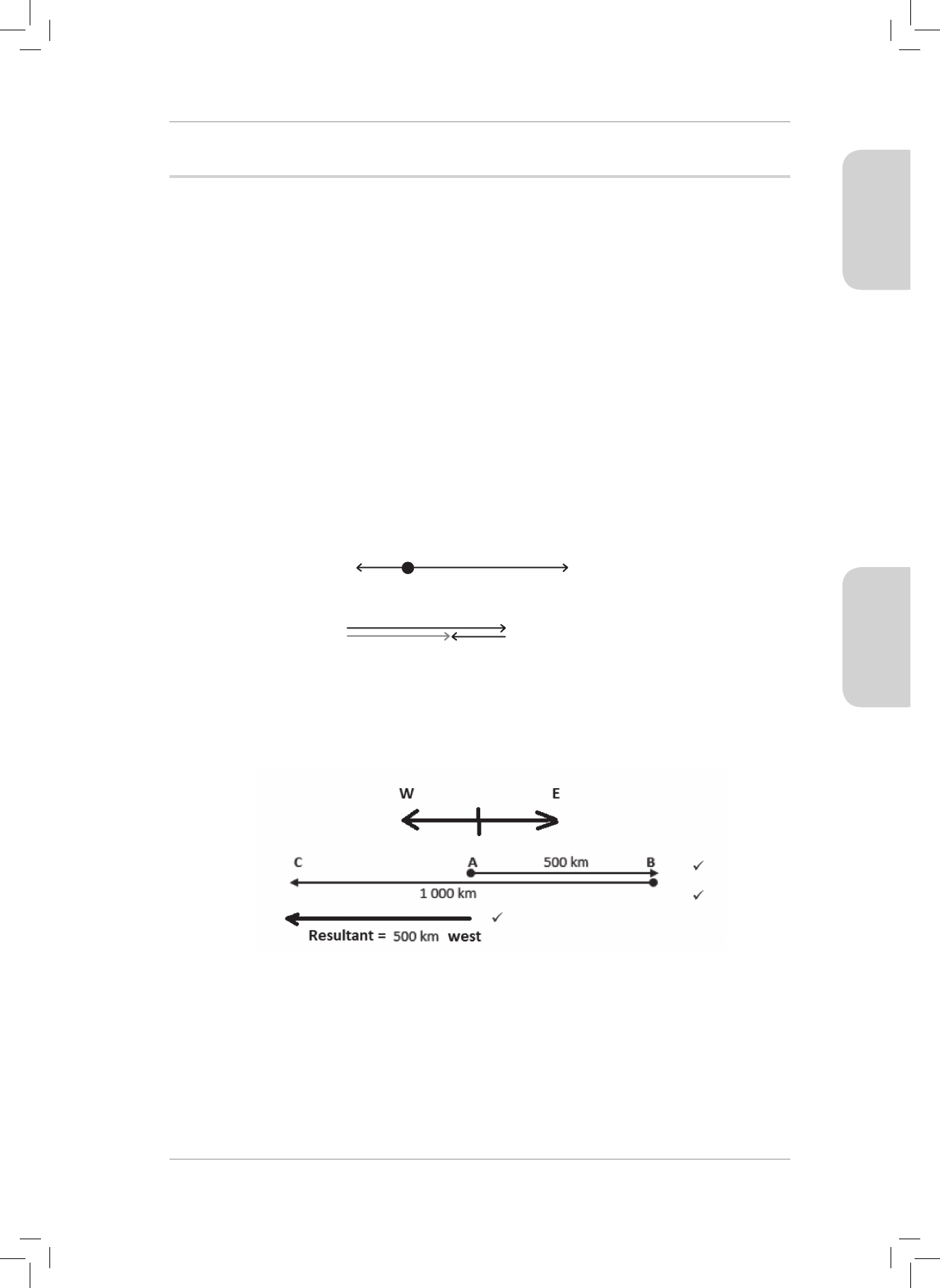
Term 3 25
TOPIC 19: VECTORS AND SCALARS
WORKSHEETS
Correct directions
90 N
54 N-36 N(method of adding vectors)
MARKING GUIDELINES
WORKSHEET
1. 1.1 A vector quantity has magnitude and direction, and a scalar quantity only
has direction. (3)
1.2 Force has magnitude and direction. (1)
1.3 a) scalar
b) scalar
c) scalar
d) vector
e) scalar
f) vector (6)
2. 2.1 Scale: 1 cm : 20 N [Learners may use a di erent scale.
e length of their vectors must represent 90 and 36 N]
(4)
2.2
54 N forward
(4)
3. 3.1 A vector quantity is a quantity which has magnitude and direction. (2)
3.2 Scale: 1 cm : 200 km [Learners can use a di erent scale.]
500 km west of A or on bearing of 180° (6)
Gr10_Term3_ResourcePack.indb 25 2019/05/31 12:28:15 PM
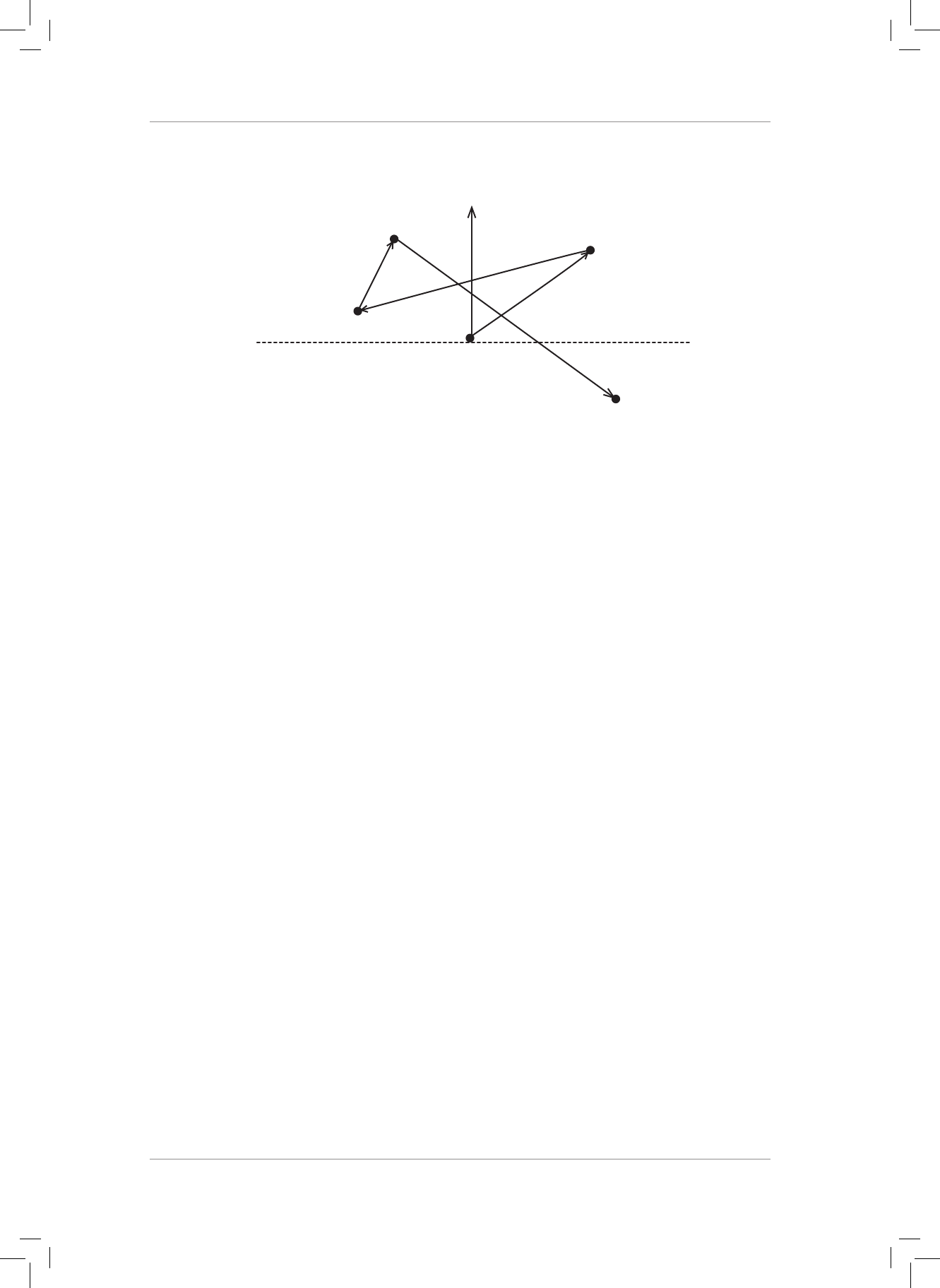
RESOURCE PACK
26 Grade 10 Physical Sciences
4. Scale: 1 cm : 2 cm
A
D
E
B
C
N (000°)
4.1 arrows joining A to B, B to C, C to D and D to E with arrows all in the correct
direction. (2)
4.2 Measure the length of each arrow (from centre of dot to centre of dot in this case)
in cm
Multiply each measurement by 2 (scale 1:2)
Due to typesetting the lengths may vary. e teacher needs to measure these
lengths and provide the denitive answer.
As typed in the original document:
AB = 4,25 cm ÑAB = 8,5 cm
BC = 6,82 cm ÑBC = 13,6 cm
CD = 2,44 cm ÑCD = 4 9 cm
DE = 8,00 cm ÑDE = 16,0 cm (4)
4.3 Pay attention to the direction of the vector relative to the horizontal line through A.
e.g. BC is directed at 15° below the line AB so the angle is 270° − 15° = 255°.
AB = 53°
BC = 255°
CD = 27°
DE = 126° (4)
4.4 Distance = 8,5 + 13,6 + 4,9 + 16,0 (method, c.o.e from 4.2)
= 43,0 cm (accuracy; SI units) (2)
Gr10_Term3_ResourcePack.indb 26 2019/05/31 12:28:15 PM
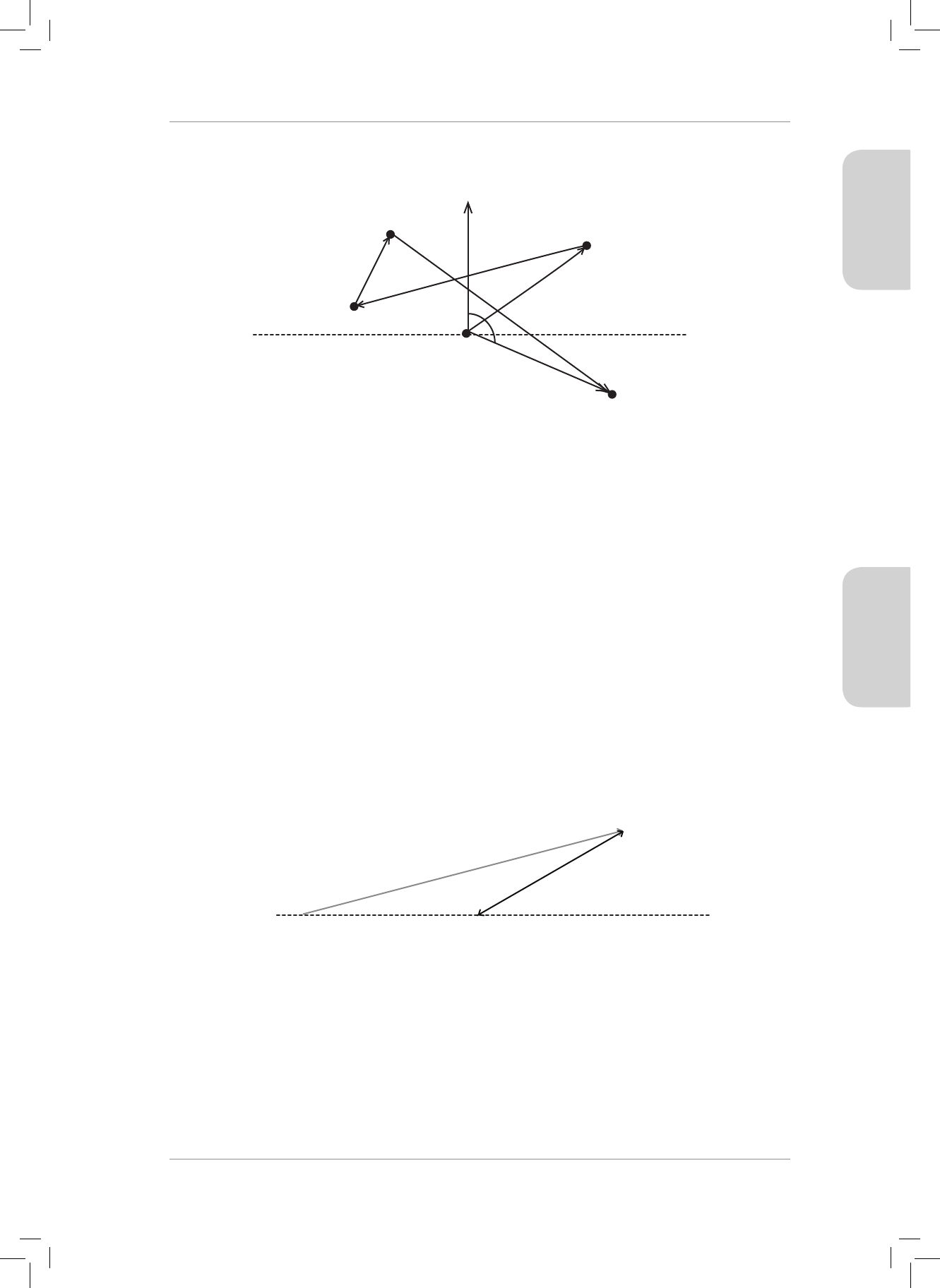
Term 3 27
TOPIC 19: VECTORS AND SCALARS
WORKSHEETS TOPIC 19
4.5 9,2 cm @ 112°
Scale: 1 cm : 2 cm
A
D
E
B
N (000°)
(4)
5. 5.1 a. 000°
b. 270°
c. 335°
d. 050°
e. 350° OR −010° (5)
5.2 a. NE OR 45° east of north (or north of east)
b. 30° east of north OR 60° north of east
c. NW OR 45° west of north (or north of west)
d. S
e. SE OR 45° east of south (or south of east) (5)
ENRICHMENT
6. 6.1 Draw a scale diagram placing vectors tail to head e.g. as in the example below.
Resultant force
1 908 N
Tractor A
Tractor B 1 000 N
Road
1 000 N
15˚
30˚
6.2 Measure the angle using a protractor:
15 ° (2)
Gr10_Term3_ResourcePack.indb 27 2019/05/31 12:28:16 PM

RESOURCE PACK
28 Grade 10 Physical Sciences
CONSOLIDATION EXERCISE
TOTAL: 40 MARKS
1. 1.1 A vector quantity is a physical quantity that has magnitude and direction. (2)
1.2 b. friction c. velocity d. displacement (3)
1.3 Scale: 1 cm : 1 N [Learners can use a dierent scale]
3 N4 N
7 N
(4)
1.4 If they act in the opposite direction the resultant force is 1 N.
4 N
1 N
3 N
(3)
OR
If the vectors are not acting in the same direction, the resultant force will not be
7N.
e.g.
4 N
5 N
3 N
2. A boy walks from one corner to the opposite corner on a soccer eld by rst
walking 50 m north and then 100 m west.
2.1 Displacement is change in position. (2)
2.2 Distance = 50 + 100 (method)
= 150 m (accuracy; SI units) (2)
2.3* Scale: 1 cm : 20 m
63˚
112 m 100 m
50 m
Answer: 112 m at 63° to 50 m displacement. (5)
Gr10_Term3_ResourcePack.indb 28 2019/05/31 12:28:16 PM

Term 3 29
TOPIC 19: VECTORS AND SCALARS
WORKSHEETS TOPIC 19
0,6 m
.
s
−1
(current)
+0,6 m
.
s
−1
(current)
0,6 m
.
s
−1
upstream
1,2 m
.
s
−1
(canoe)
−1,2 m
.
s
−1
(canoe)
0,6
m
.
s
−1
upstream
2.4 If the boy returns to his original position his displacement is zero. He could
have walked away from his original position during this time, so his distance (path
length) will not be zero. (3)
3. 3.1 Scale: 1 cm : 0,25 ms
−1
(5)
3.2 Alternative 1
Scale: 1 cm : 0,25 ms
−1
Alternative 2
Resultant velocity = 1,2 (upstream) + 0,6 (downstream)
= 1,2 − 0,6
= 0,6 ms
−1
upstream (3)
3.3 Distance = speed × time (method)
= 0,6 × (5 × 60) (converting minutes to seconds)
= 180 m (accuracy; SI units) (3)
3.4 3.4.1 Resultant velocity = 1,2 + 0,6 (method OR graphical method)
= 1,8 ms
−1
(accuracy; SI units) (2)
3.4.2 Distance = speed × time
= 1,8 × (5 × 60) (substitutions; c.o.e)
= 540 m (accuracy; SI units)
Extra distance = 540 – 180
= 360 m (accuracy; SI units) (3)
Gr10_Term3_ResourcePack.indb 29 2019/05/31 12:28:17 PM

RESOURCE PACK
30 Grade 10 Physical Sciences
and Acceleration
WORKSHEET
1. Lindiwe walks to school every morning as shown in the diagram below.
Lindiwe’s home
Lindiwe’s route
to school
BridgeRailway line
School
gate
School
grounds
N
1 cm on the diagram represents 20 m.
1.1 Clearly distinguish between distance and displacement. (3)
1.2 Determine the distance that Lindiwe walks every morning from home to the school
gates. (3)
1.3 What is her displacement at the school gate? (3)
1.4 What is her displacement when she gets home? (1)
2. Determine the distance and displacement of each of the following journeys. If
necessary use a scale diagram to help you work out the displacement and/or distance.
2.1 Cindy walks 700 m in a straight line on a bearing of 210°. (3)
2.2* Simphiwe walks 50 m due north then turns around and walks 150 m due south. (3)
2.3 James runs four times round a circular athletics track with a circumference of
440m and stops when he gets to the starting line again. (3)
Gr10_Term3_ResourcePack.indb 30 2019/05/31 12:28:17 PM

Term 3 31
TOPIC 20: 1-D MOTION, SPEED, VELOCITY AND ACCELERATION
WORKSHEETS TOPIC 20
3. Determine the average speed and the average velocity of each of the following
journeys (in ms
−1
).
3.1 Lerato walks for 35 minutes for 2,5 km along the road from home to school. e
school is located 1 km south east from her home. (5)
3.2 It takes omas 4 minutes to run around a rectangular sports eld with length of
200 m and width of 100 m, and return to his starting position. (5)
4. If you drive your car at an average speed of 105 kmh
−1
, how far (in km) will you go
in 3 hours 30 minutes? (4)
5. A bullet travels at 800 ms
−1
. How long will it take for the bullet to travel 1 km? (4)
6. Charles rides his bicycle 7 km north at an average speed of 21 kmh
−1
. He stops for
lunch for 20 minutes, then rides 5 km south for 15 minutes.
6.1 Calculate how long (in minutes) it took Charles to ride the 7 km. (4)
6.2 Calculate his average speed (in kmh
−1
) for the whole journey. (4)
6.3 Calculate his displacement (in km) at the end of the journey. (4)
6.4 Calculate his average velocity (in km) for the whole journey. (4)
7. You drive your car for 2 hours at an average speed of 45 kmh
−1
, then for 2 hours at
an average speed of 80 kmh
−1
. What is the average speed for the whole journey? (5)
Gr10_Term3_ResourcePack.indb 31 2019/05/31 12:28:17 PM
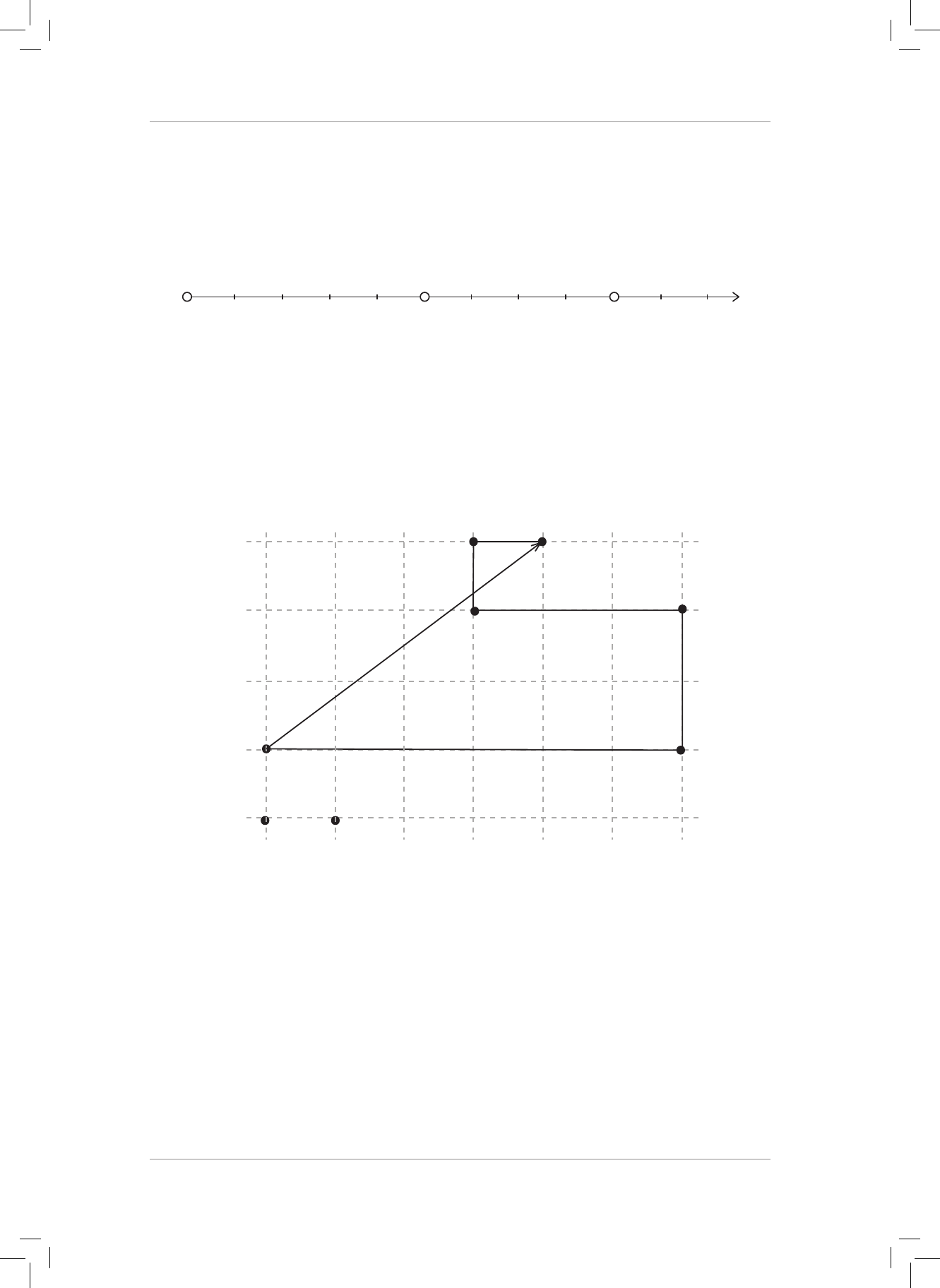
RESOURCE PACK
32 Grade 10 Physical Sciences
CONSOLIDATION EXERCISE
TOTAL: 48 MARKS
1. An object moves from point A to point B to point C, then back to point B and then
to point C in 20 minutes, travelling along the line shown in the diagram below.
AB
5km 6km3km 4km1km0km 2km 7km 8km 9km 10km 11km
C
1.1. Calculate the total distance moved by the object in 20 minutes. (2)
1.2. Calculate the displacement of the object in 20 minutes. (3)
1.3. Calculate the average speed of the object in 20 minutes, in kmh
−1
. (3)
1.4. Calculate the average velocity of the object in 20 minutes, in kmh
−1
. (4)
2. An object moves from A to B to C to D to E to F in 30 seconds, as shown in the
diagram below.
A
1 m
D
C
B
EF
5 m
36,9°
2.1. Calculate the distance moved in 30 s. (2)
2.2. e vector drawn from A to F shows the object’s displacement in 30 s. With
reference to the denition of displacement, explain why this vector gives the
object’s displacement, and write down the magnitude and direction of its
displacement. (4)
2.3. Calculate the average speed of the object in 30 s. (3)
2.4 Calculate the magnitude of its average velocity in 30 s. (3)
Gr10_Term3_ResourcePack.indb 32 2019/05/31 12:28:17 PM

Term 3 33
TOPIC 20: 1-D MOTION, SPEED, VELOCITY AND ACCELERATION
WORKSHEETS TOPIC 20
3. A rocket accelerates upwards from rest to 270 ms
−1
in 10 s reaching a height of
1,35km above its original position.
3.1 Calculate the acceleration of the rocket. (5)
3.2 Calculate the average speed of the rocket during these 10 s. (3)
3.3 e rocket continues to rise at its maximum speed for another 10 s. How high is it
above its original position aer 20 s? (4)
4. A car slows down from 36 kmh
−1
to stop in 25 s.
4.1 Dene “acceleration”. (2)
4.2 Convert 36 kmh
−1
to ms
−1
. (3)
4.3 Calculate the acceleration of the car during these 25 s. (4)
4.4 Does a negative acceleration always imply that an object is slowing down? Briey
justify your answer. (3)
Gr10_Term3_ResourcePack.indb 33 2019/05/31 12:28:17 PM

RESOURCE PACK
34 Grade 10 Physical Sciences
MARKING GUIDELINES
WORKSHEET
1. 1.1. Distance is the total path travelled. Displacement is the change in position.
Distance is a scalar quantity whereas displacement is a vector quantity. (3)
1.2. Lindwe’s distance:
From the map: Distance = 3,3 + 5,3 + 3,3 + 0,8 (accuracy)
= 12,4 cm (method: adding cm)
Converting to Distance walked = 12,4 × 20 = 248 m (conversion; SI units) (3)
1.3. Displacement = 6,7 × 20 (method)
= 134 m South (conversion)
(direction) (3)
1.4. 0 m (zero) (1)
[ere is no change in position when she gets back to her starting point.]
2. 2.1. Cindy: Distance = 700 m (accuracy; SI units)
Displacement = 700 m on a bearing of 210° (accuracy; SI units)
(direction) (3)
2.2. Simphiwe: Distance = 50 + 150 = 200 m (accuracy; SI units)
Displacement = 50 – 150 (method)
= − 100
= 100 m south (accuracy; SI units; direction) (3)
2.3. James: Distance = 4 × 440 (method)
= 1760 m (accuracy; SI units)
Displacement = 0 m (3)
3. 3.1. Distance = 2500 m Time: 35 × 60 = 2100 s (conversions)
Average speed =
time
distance
=
2 100
2 500
(substitutions)
= 1,19 ms
−1
(accuracy; SI units)
Average velocity =
time
displacement
=
2 100
1 000
(substitutions)
= 0,48 ms
−1
south east (accuracy; SI units)
(direction) (5)
Gr10_Term3_ResourcePack.indb 34 2019/05/31 12:28:19 PM

Term 3 35
TOPIC 20: 1-D MOTION, SPEED, VELOCITY AND ACCELERATION
WORKSHEETS TOPIC 20
3.2. omas: Distance = 200 + 100 + 200 + 100 = 600 m (method)
Time = 4 × 60 = 240 s (conversion)
Average speed =
time
distance
=
240
600
(substitutions)
= 2,5 ms
−1
(accuracy; SI units)
Displacement = 0 m
Average velocity = 0 ms
−1
(5)
4. Time = 3 hours 30 minutes = 3,5 hours (conversion)
Distance = average speed × time (method)
= 105 × 3,5 (substitutions)
= 367,5 km (accuracy; SI units) (4)
5. Distance = 1 km = 1000 km (conversion)
Time =
average speed
distance
(method)
=
800
1000
(substitutions)
= 1,25 s (accuracy; SI units) (4)
6. 6.1. Time =
average speed
distance
(method)
=
21
7
(substitutions)
= 0,33 × 60 (conversion hours to minutes)
= 20 minutes (accuracy; SI units) (4)
6.2. Total distance = 7 + 5 = 12 km
Total time = 20 + 20 + 15 (accuracy)
=
60
55
hours (conversion minutes to hours)
Average speed =
time
distance
=
60
55
12
ak
(substitutions)
= 13,09 kmh
−1
(accuracy; SI units) (4)
Gr10_Term3_ResourcePack.indb 35 2019/05/31 12:28:22 PM
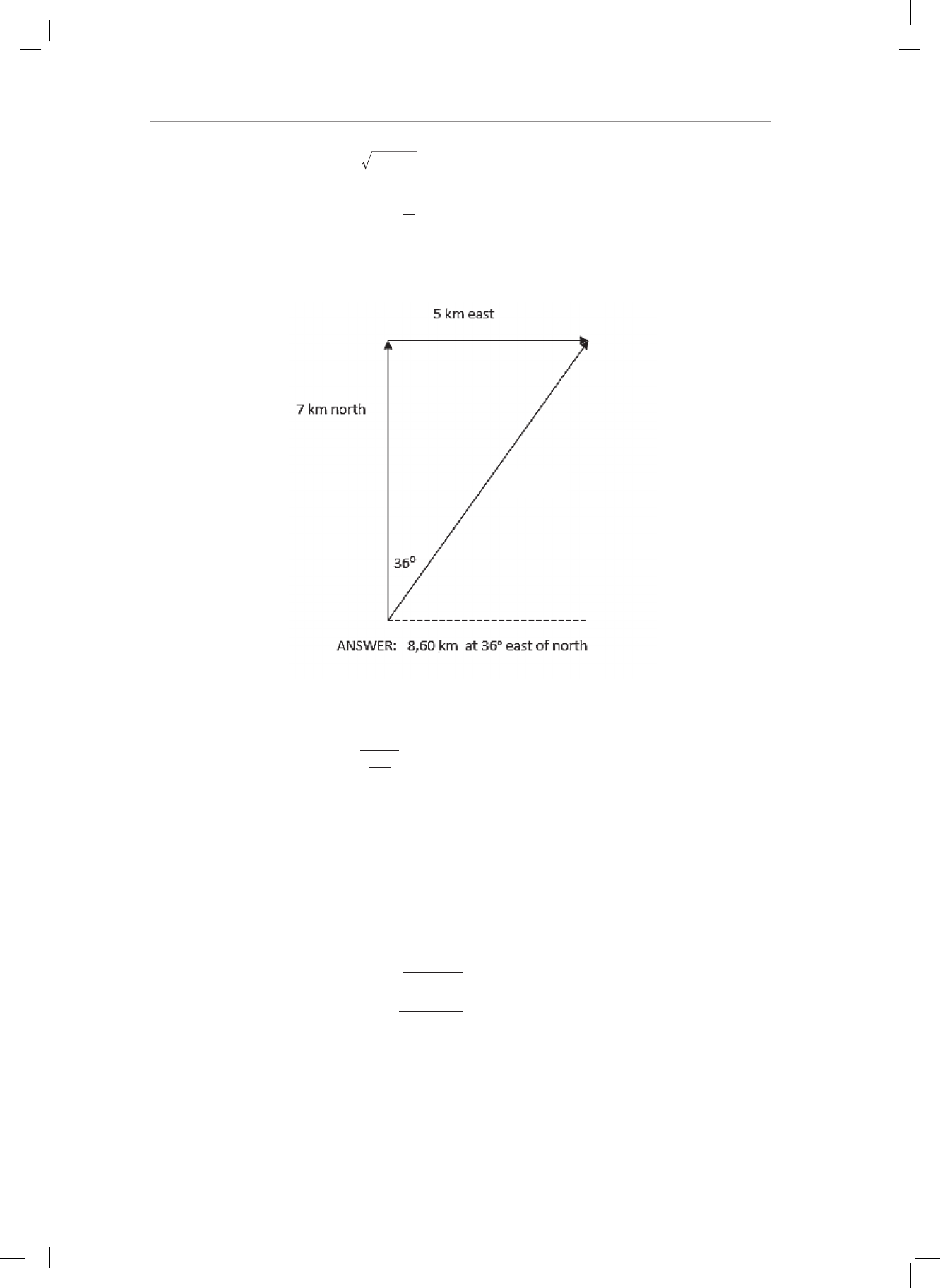
RESOURCE PACK
36 Grade 10 Physical Sciences
*6.3. Displacement =
75
22
+
(method)
= 8,60 km (accuracy)
Direction = tan
−1
7
5
ak
(method)
= 35,54° east of north (or bearing of 035,54°) (accuracy) (4)
OR USING A SCALE DIAGRAM:
Scale: 1 cm : 1 km
6.4. Average velocity =
time
displacement
=
,
60
55
860
ak
(substitutions; c.o.e from 6.3)
= 9,38 kmh
−1
(accuracy; SI units)
35,54° east of north (or bearing of 035,54°)
(accuracy; c.o.e) (4)
7. Distance in rst 2 h = 45 × 2 = 90 km
Distance in second 2 h = 80 × 2 = 160 km
Average speed =
time
distance
=
4
160 90
+
method: adding distances)
(substitutions)
= 62,5 kmh
−1
(accuracy; SI units) (5)
8,60 km
Gr10_Term3_ResourcePack.indb 36 2019/05/31 12:28:24 PM

Term 3 37
TOPIC 20: 1-D MOTION, SPEED, VELOCITY AND ACCELERATION
WORKSHEETS TOPIC 20
CONSOLIDATION EXERCISE
TOTAL 48 MARKS
1. 1.1. Distance = 5 + 4 + 4 + 4 (method: adding distances)
= 17 km (accuracy; SI units) (2)
1.2. Displacement = 5 + 4 + (-4) + 4 (method)
= 9 km (accuracy; SI units) (3)
1.3 Average speed =
time
distance
(method)
=
60
20
17
ak
(substitutions)
= 51 kmh
−1
(accuracy; Si units) (3)
1.4. Average velocity =
time
displacement
(method)
=
60
20
9
ak
(substitutions)
= 27 kmh
−1
forward (accuracy; Si units)
(direction) (4)
2. 2.1. Distance = 6 + 2 + 3 + 1 + 1 (method)
= 13 m (accuracy; SI units) (2)
*2.2. Displacement is dened as the change in the position of the object relative to its
starting position. e line from A to F give us the change in position (the object’s
displacement).
Magnitude of displacement on the diagram = 5 cm
Angle between AF and the horizontal = 37°
Displacement = 5 m at 37° to the horizontal (AB). (4)
2.3. Average speed =
time
distance
(method)
=
30
13
(substitutions)
= 0,43 ms
−1
(accuracy; SI units) (3)
2.4. Average velocity =
time
displacement
(method)
=
30
5
(substitutions)
= 0,17 ms
−1
(accuracy; SI units) (4)
Gr10_Term3_ResourcePack.indb 37 2019/05/31 12:28:27 PM

RESOURCE PACK
38 Grade 10 Physical Sciences
3. 3.1.
a
t
vv
fi
T
=
-
(method)
=
10
270 0
-
(substitutions)
= 27 ms
−2
upward (accuracy; SI units)
(direction) (4)
3.2. Average speed =
time
distance
(method)
=
10
1350
(substitutions)
= 135 ms
−1
(accuracy; SI units) (3)
3.3. Further distance = speed × time (method)
= 270 × 10 (substitutions)
= 2700 m
Height = 1,350 + 2,700 (method)
= 4050 m (or 4,05 km) (accuracy; SI units) (4)
4. 4.1. Acceleration is the rate of change of velocity. (2)
4.2. 36,36 km.h
−1
=
,
60 60
36 36 1000
#
#
(method)
= 10,1 ms
−1
(accuracy) (2)
4.3.
a
t
vv
fi
T
=
-
(method)
=
,
25
0101
-
(substitutions)
= -0,40 ms
−2
(accuracy)
= 0,40 ms
−2
in the opposite direction (SI units; direction) (4)
4.4. No. If the object stops, (nal velocity = 0 ms
−1
) or the velocity is less than
the nal velocity and still positive, a negative acceleration tells us that the object
is slowing down. In all other cases the object is speeding up in the opposite
direction. (3)
Gr10_Term3_ResourcePack.indb 38 2019/05/31 12:28:28 PM

Term 3 39
TOPIC 21: GRAPHS AND EQUATIONS OF MOTION
WORKSHEETS TOPIC 21
TOPIC 21: INSTANTANEOUS SPEED AND VELOCITY AND
EQUATIONS OF MOTION
WORKSHEET
1. A boy takes 10 minutes to run around the perimeter of the school playing elds, as
shown in the diagram below. He runs at a steady (constant) speed from A through
B, C and D and back to A again.
AB
CD
150 m
150
m
300 m
300 m
335,4 m
27°
For the circuit from A through B, C and D, and back to A, ….
1.1 calculate his average speed. (4)
1.2 determine his displacement. (2)
1.3 calculate his average velocity. (2)
For the part of the circuit from A through B to C, …
*1.4 write down his displacement (with reference to the line AB) (2)
*1.5 calculate his average velocity from A to C. (3)
[13]
2. A racing car accelerates uniformly from 0 to 100 kmh
−1
in 7,5 s.
2.1 Dene the term “acceleration”. (2)
2.2 Convert 100 kmh
−1
to ms
−1
. (2)
2.3 Calculate the magnitude of the car’s acceleration. (3)
2.4 How far does the car travel during this time? Show your calculation. (3)
2.5 e driver applies the brakes and brings the car to a stop from 100 kmh
−1
in 10 s.
Calculate the car’s acceleration during these 10 s. (4)
[14]
Gr10_Term3_ResourcePack.indb 39 2019/05/31 12:28:29 PM
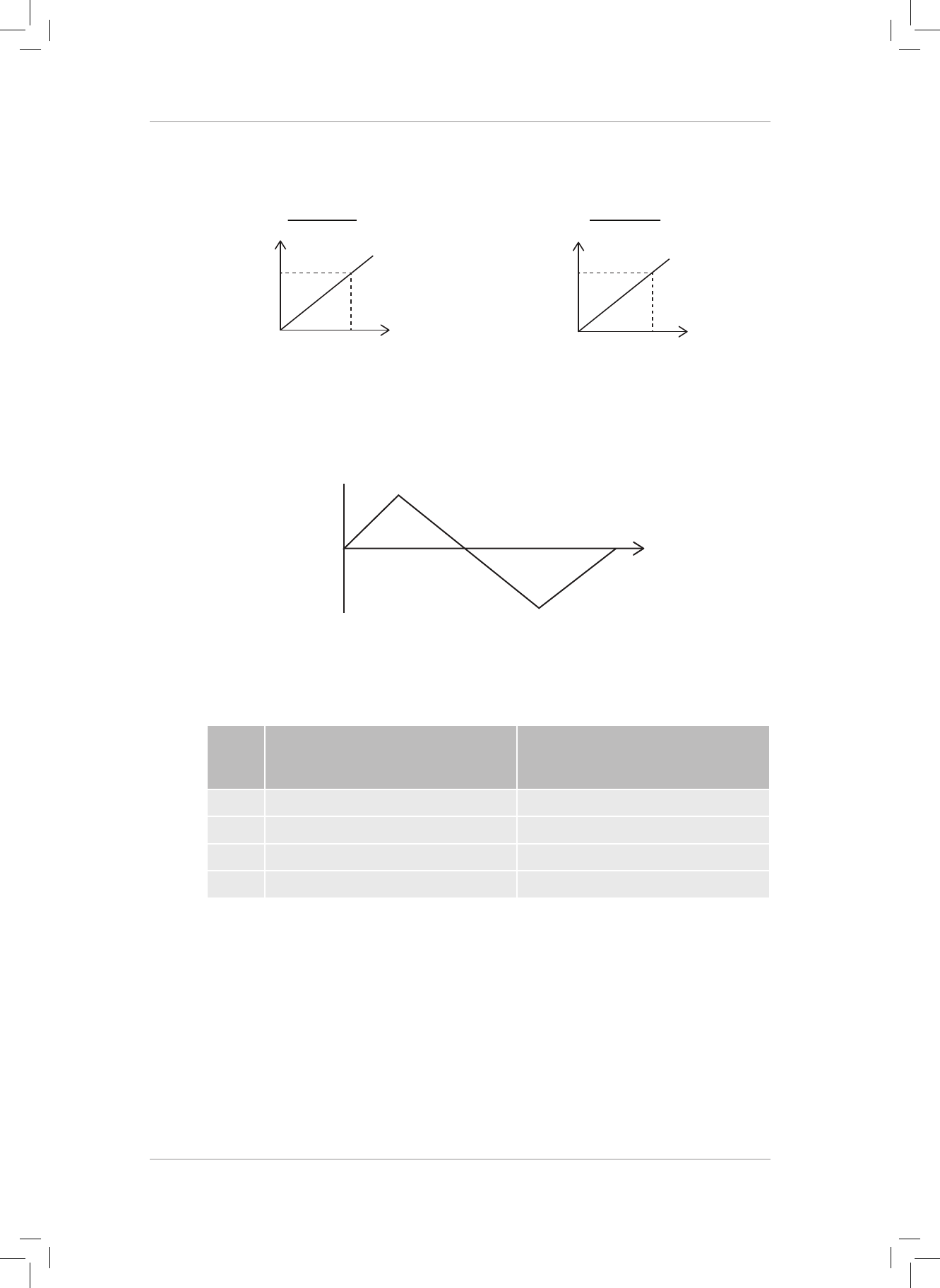
RESOURCE PACK
40 Grade 10 Physical Sciences
3. e two graphs, shown below, are plotted for two dierent vehicles (Vehicle A and
Vehicle B). Study these two graphs and answer the questions which follow.
Vehicle A
200
200t (s)
x (m)
20
20
Vehicle B
v (m
.
s
-1
)
20
0t
(s)
3.1 Describe how the motion of Vehicle A diers from that of Vehicle B. (2)
3.2 How do the displacements of the two vehicles dier aer 20 seconds? Which
vehicle has travelled further? Justify your answer with reference to the graphs. (4)
3.3. Study the following velocity-time graph of a toy car moving along a straight track.
V
A
B
CD
t (s)
(m.s
-1
)
Describe the motion of the car in terms of the magnitude of its velocity, and its
direction of travel. Take the positive direction to represent “forward”. Copy the
table below and write in your answers for each stage of the car’s journey.
VELOCITY IS INCREASING/
DECREASING
DIRECTION OF MOTION IS
TOWARDS/ AWAY FROM THE
OBSERVER
A
B
C
D
(8)
[14]
Gr10_Term3_ResourcePack.indb 40 2019/05/31 12:28:29 PM
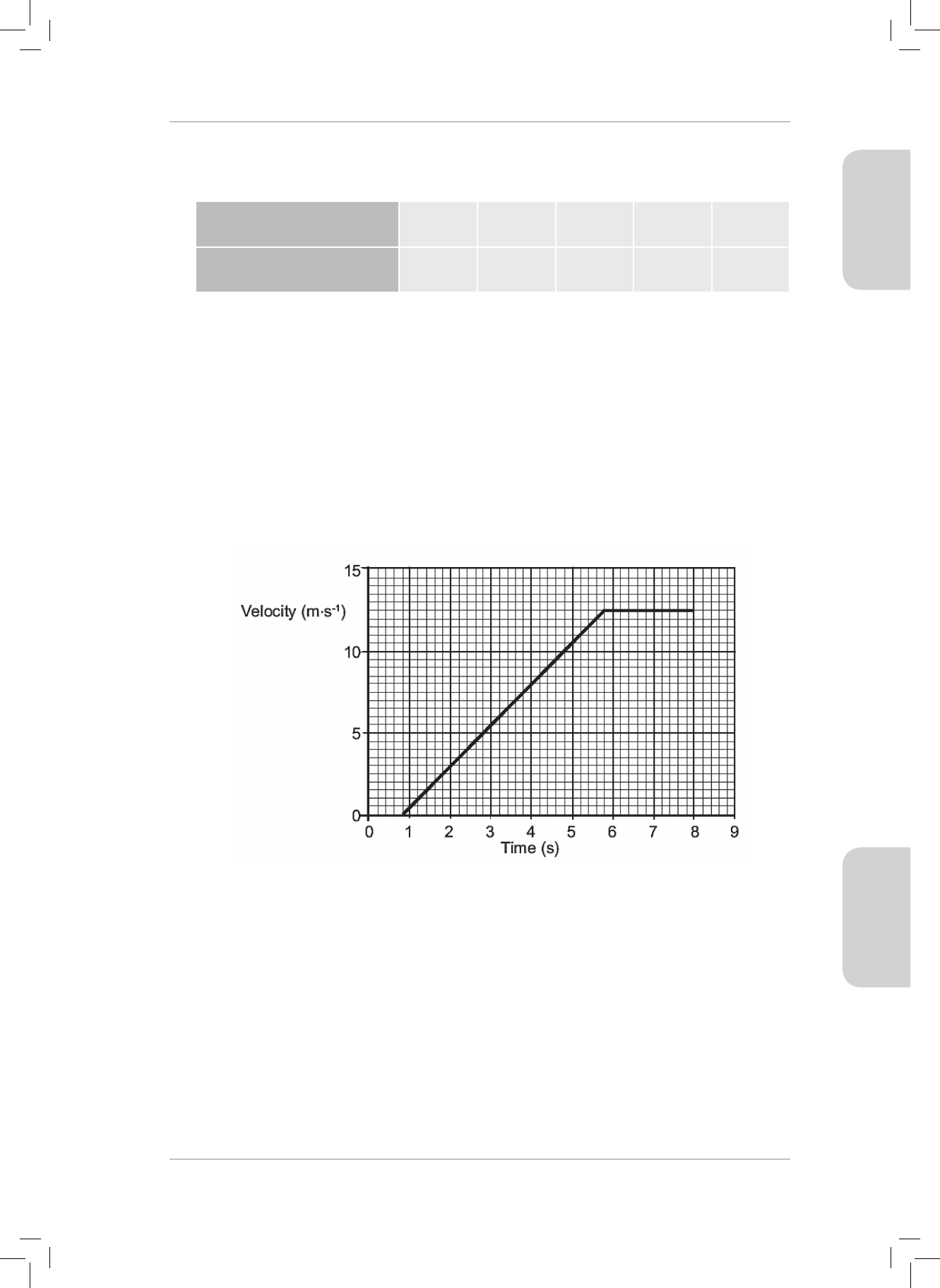
Term 3 41
TOPIC 21: GRAPHS AND EQUATIONS OF MOTION
WORKSHEETS TOPIC 21
4. A car accelerates uniformly from a stop street along a straight road, covering the
following distances in 10 s as shown in the table below.
ELAPSED TIME (t) IN
SECONDS
2 4 6 8 10
DISTANCE FROM STARTING
POSITION (m)
10 18 24 28 30
4.1
Plot a displacement – time graph of the car’s motion (on a piece of graph paper). (6)
4.2 4.2.1 Describe the shape of the graph. (1)
4.2.2 Describe the motion of the car. (2)
4.3 Use the graph to determine the magnitude of the average velocity of the car. (3)
4.4 Use the graph to determine the magnitude of the instantaneous velocity of the car
at 3 s. (3)
[15]
5. A driver stops his car at the trac light when it turns red. e graph of the car’s
velocity against time shows its motion for 8 s from the time the trac light turns green.
5.1 e short time interval between the trac light turning green (for GO) and the
driver responding to the signal, is known as “the driver’s reaction time”.
5.1.1 How long does the driver take to respond when the trac light changing to
green? (1)
5.1.2 Give TWO factors that can aect the reaction time of a driver. (2)
5.2 Determine the maximum speed of the car. (1)
5.3 Use the graph to calculate the average acceleration of the car. (4)
5.4 Use the graph to determine the displacement of the car over these 8 s. (4)
5.5 Calculate the average velocity of the car over 8 s. (3)
[15]
Gr10_Term3_ResourcePack.indb 41 2019/05/31 12:28:29 PM

RESOURCE PACK
42 Grade 10 Physical Sciences
6. A driver speeds through an urban area at 25 ms
−1
. A trac cop gives chase as the
driver passes her. She accelerates from rest to a maximum speed of 30 ms
−1
for 40 s,
and then she draws level with the speeding driver t seconds later.
Using this data, determine how long it takes the trac cop from the moment she
gives chase to the time she draws level with the speeding car. [8]
Gr10_Term3_ResourcePack.indb 42 2019/05/31 12:28:29 PM
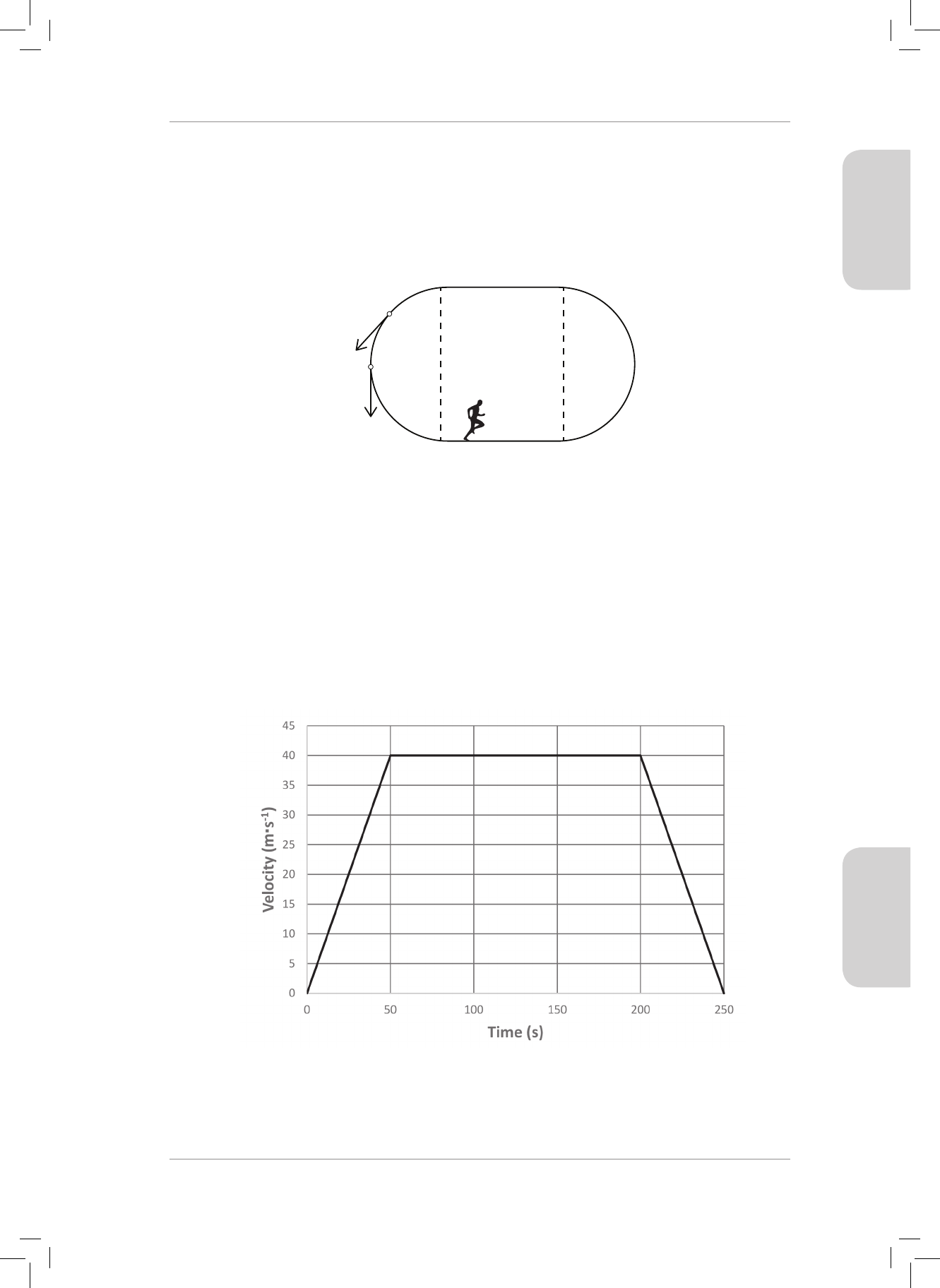
Term 3 43
TOPIC 21: GRAPHS AND EQUATIONS OF MOTION
WORKSHEETS TOPIC 21
CONSOLIDATION EXERCISE
TOTAL: 63 MARKS
1. An athlete starts his 200 m race on an oval track at A. He completes the rst 100 m
(marked B) in 11,0 s and eventually nishes the race in a total time of 23,5 s.
A
C
D
B
start
finish
1.1 Calculate the average speed of the athlete over the rst 100 m of the race. (3)
1.2 Distinguish between instantaneous velocity and average velocity. (2)
1.3 At C and at D the athlete runs at a constant speed of 9,1 ms
−1
.
a) What is the magnitude of his instantaneous velocity at C? (1)
b) Explain why his instantaneous velocity at C diers from that at D. (1)
1.4 Calculate his average velocity over the last 100 m of the race. (4)
[11]
2. A graph showing the velocity of a train is plotted against time is shown below.
2.1 What is the maximum speed of the train? (1)
Gr10_Term3_ResourcePack.indb 43 2019/05/31 12:28:29 PM

RESOURCE PACK
44 Grade 10 Physical Sciences
2.2 Describe the motion of the train between points A and B. (1)
2.3 Describe the motion of the train between points B and C. (1)
2.4 How far did the train travel between A and C? (5)
2.5 Determine the acceleration of the train when its brakes were applied. (4)
[12]
3. Ayabonga and Bongi are racing their remote-controlled model cars along a straight
at road. e table below gives details of the two cars’ motion.
TIME (s)
AYABONGA
CAR’S DISTANCE (m)
BONGI
CAR’S DISTANCE (m)
1 4 0,8
2 8 3,2
3 12 7,2
4 16 12,8
5 20 20,0
3.1
On the same piece of graph paper, plot the graphs of Distance against Time for
each of the cars. Label each graph with the name of the person whose car it is. (8)
3.2 Describe the motion of Ayabonga’s car. (1)
3.3 Describe the motion of Bongi’s car. (1)
3.4 Which car, Ayabonga’s or Bongi’s, will be ahead at 6 s? Show your calculations. (4)
[12]
4. A stone is dropped vertically from a height of 2 m onto the ground. e graph
shows the height of the stone above the ground at dierent times during its fall until
it hits the ground aer 0,64 s.
Gr10_Term3_ResourcePack.indb 44 2019/05/31 12:28:29 PM

Term 3 45
TOPIC 21: GRAPHS AND EQUATIONS OF MOTION
WORKSHEETS TOPIC 21
Height against time for
a falling stone
2,0
1,5
1,0
0,5
0,0
Height (m)
Time (s)
0,0 0,2 0,4 0,6 0,8
4.1 Calculate the average velocity of the stone during its fall of 0,64 s. (4)
4.2 Calculate the average speed of the stone from 0,4 to 0,64 s. (4)
4.3 Explain how the shape of the graph tells us that the stone accelerated uniformly as
it fell to the ground. (2)
4.4 Use the values for speed and velocity calculated in 4.1 and 4.2 to determine the
magnitude of the acceleration of the stone. NB: e magnitude of the average
velocity (or speed) is equal to the instantaneous velocity (or speed) at halfway
through the time. (3)
[13]
5. A taxi-driver drives his taxi at 25 ms
−1
in an 80 kmh
−1
trac zone. He suddenly
notices a trac ocer operating a speed trap in the road 24 m ahead of him. He
applies brakes and decelerates constantly at 1,8 ms
−2
.
5.1 Calculate the speed of the taxi when it passes the trac ocer. (4)
5.2 Determine whether the taxi was breaking the speed limit when it passes the trac
ocer. Show your calculation. (2)
[6]
6. A cyclist accelerates uniformly from rest on a straight, horizontal road at point A
and reaches point Y, covering the last 10 m of his ride in 2 s.
6.1 Calculate the magnitude of his average velocity over the last 2 s. (2)
6.2 What is his instantaneous velocity 1s before reaching point Y? (1)
6.3 Calculate his constant acceleration over this last 1 s if he reaches a velocity of
9ms
−1
at point Y. (4)
[7]
Gr10_Term3_ResourcePack.indb 45 2019/05/31 12:28:30 PM

RESOURCE PACK
46 Grade 10 Physical Sciences
MARKING GUIDELINES
WORKSHEET
1. 1.1 (method)
,
10 60
300 150 300 150
15
averagespeed
time
distance
m·s
1
#
{
=
=
+++
=
-
(calculating distance)
(converting minutes to seconds)
(accuracy; SI units) (4)
1.2 Displacement = 0 m (No change in position) (2)
1.3
averagevelocity
time
displacement
=
(method)
= 0 ms
−1
(accuracy; SI units) (2)
1.4 Displacement = 335,4 m at 27° below the line AB (2)
1.5
averagevelocity
time
displacement
=
(method)
,
600
335 4
=
(substitutions)
= 0,56 ms
−1
at 27° (accuracy; SI units) (3)
[16]
2. 2.1 Acceleration is the rate of change of velocity. (2)
2.2 100 kmh
−1
=
60 60
100 1 000
#
#
(method)
= 27,78 ms
−1
(accuracy; ignore SI units) (2)
2.3
a
t
vv
fi
T
=
-
(method)
,
,
75
27 78 0
=
-
(substitutions)
= 3,70 ms
−2
(accuracy; SI units) (3)
2.4 ALTERNATIVE 1
xv
ta
t
2
1
i
2
TT T
=+
(method)
=
,,
0
2
1
37 75
2
#
+
^^hh
(substitutions; c.o.e)
= 104,06 m (accuracy; SI units)
ALTERNATIVE 2
vv ax2
fi
22
T
=+
(method)
,,x27 78 0237
2
2
T
=+
^^hh
(substitutions; c.o.e)
xT
= 104,06 m (accuracy; SI units)
Gr10_Term3_ResourcePack.indb 46 2019/05/31 12:28:33 PM

Term 3 47
TOPIC 21: GRAPHS AND EQUATIONS OF MOTION
WORKSHEETS TOPIC 21
ALTERNATIVE 3
x
vv
t
2
fi
TT
=
+
ak
(method)
,
,
2
27 78 0
75
=
+
a
^
k
h
(substitutions)
= 104,06 m (accuracy; SI units) (3)
2.5
a
t
vv
fi
T
=
-
(method)
,
10
02778
=
-
(substitutions)
= −2,78 ms
−2
(accuracy; SI units)
2,78 ms
−2
in the opposite direction (backwards) (4)
[14]
3. 3.1 Vehicle A travels at constant (uniform velocity) and Vehicle B travels at
constant (uniform) acceleration. (2)
3.2 Vehicle A: Aer 20 s it has travelled 200 m.
Vehicle B: Displacement = area under the graph = ½ (20)×20 = 200 m
Both have travelled the same distance. (4)
3.3.
v
A
B
CD
t (s)
(m
.
s
-1
)
VELOCITY IS INCREASING/
DECREASING
DIRECTION OF MOTION IS
TOWARDS/ AWAY FROM THE
OBSERVER
A
Increasing Away
B
Decreasing Away
C
Increasing Towards
D
Decreasing Towards
(8)
[14]
V
(m.s
-1)
Gr10_Term3_ResourcePack.indb 47 2019/05/31 12:28:34 PM
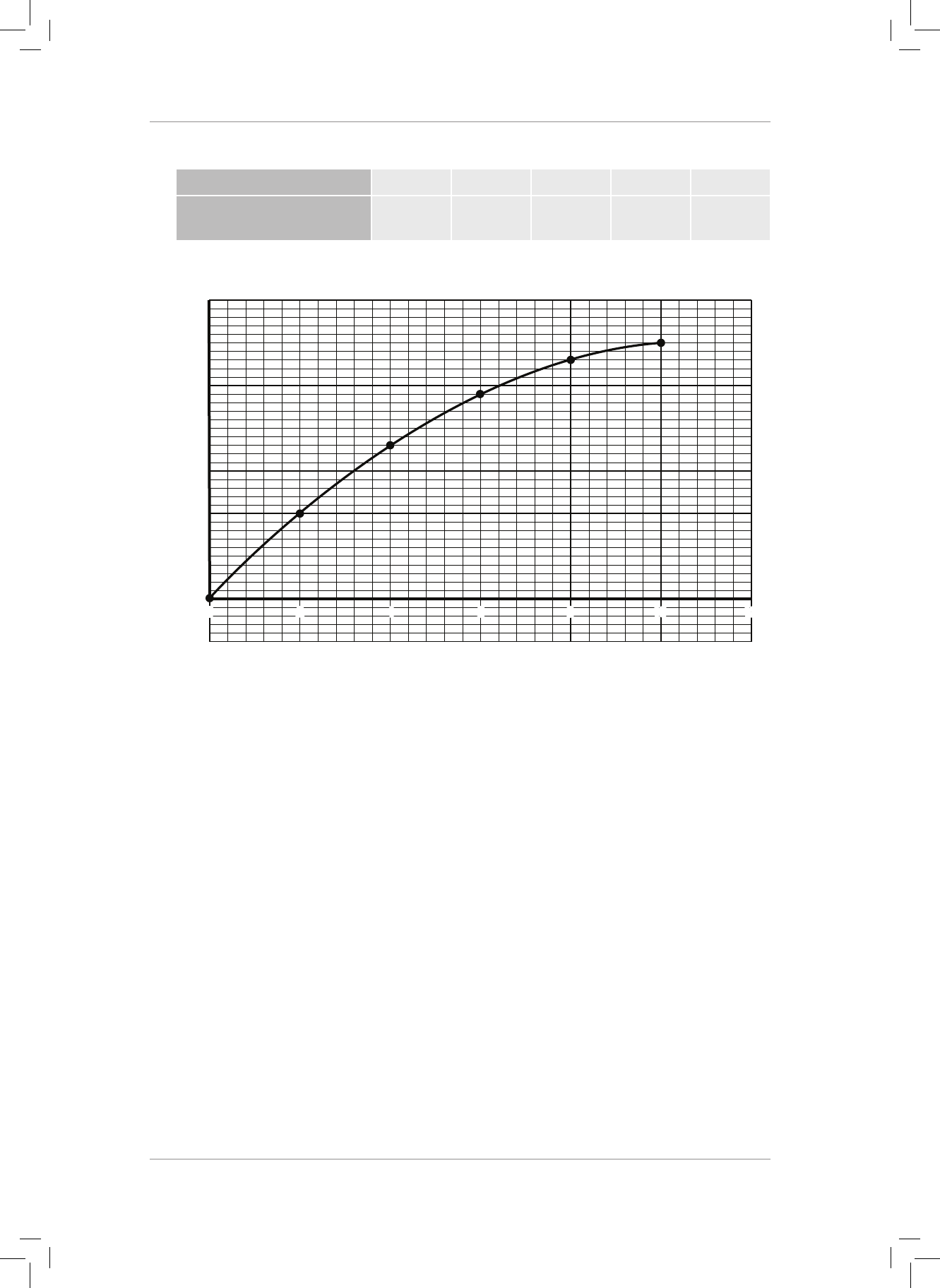
RESOURCE PACK
48 Grade 10 Physical Sciences
4.
Elapsed time (t) in seconds 2 4 6 8 10
Displacement from
starting position (m)
10 18 24 28 30
4.1
Displacement - time graph
Time (s)
Displacement (m)
35
30
25
20
15
10
5
0
0 24681
01
2
Appropriate title for graph
Vertical axis: scale, titles, SI units
Horizontal axis: scale, title, SI units – Time must be plotted on the x-axis
Points plotted correctly
Smooth line of best t
Line of best t passes through the origin (6)
4.2 4.2.1 A parabola curving downward (a smooth curve with a steadily decreasing
slope.) (1)
4.2.2 e car is slowing down at a constant (uniform) rate (OR uniform
deceleration OR uniform negative acceleration). (2)
Gr10_Term3_ResourcePack.indb 48 2019/05/31 12:28:34 PM

Term 3 49
TOPIC 21: GRAPHS AND EQUATIONS OF MOTION
WORKSHEETS TOPIC 21
Displacement - time graph
Time (s)
Displacement (m)
35
30
25
20
15
10
5
0
024681
01
2
4.3
averagevelocitygradientoflineshown on graph
10 0
30 0
3 m·s
1
==
-
-
=
-
4.4
Displacement - time graph
Time (s)
Displacement (m)
35
30
25
20
15
10
5
0
024681
01
2
Method of taking the gradient at 3,0 s clearly shown on the graph
Gradient =
,,
,,
68 08
29 060
-
-
(as shown on the graph)
= 3,83 ms
−1
(accuracy; SI units) (3)
[15]
Gr10_Term3_ResourcePack.indb 49 2019/05/31 12:28:35 PM

RESOURCE PACK
50 Grade 10 Physical Sciences
5. 5.1 5.2.1 0,8 s (1)
5.2.2 e driver’s concentration (due to ill health, older age, being distracted by
cell phone message or call, aected by alcohol or medication or taking illegal
drugs)
e driver’s reexes (the time taken for his mind to respond to seeing the
trac light go green) (due to ill health, older age, inexperienced driver who
has recently passes the driver’s test, alcohol or medication or taking illegal
drugs). (2)
5.2 12,5 ms
−1
(accuracy; SI units) (1)
5.3
( )gradient of thegrapha
t
v
T
T
=
(method)
,,
,
58
08
12 50
=
-
-
(substitutions)
= 2,5 ms
−2
(accuracy; SI units) (4)
5.4 Displacement = area under the graph (method)
= (½ (5,8 – 0,8) × 12,5) + (12,5 × (8 – 5,8)) (substitutions)
= 58,75 m (accuracy; SI units) (4)
5.5 average velocity =
time
displacement
(method)
,
8
58 75
=
(substitutions)
= 7,34 ms
−1
(accuracy; SI units) (3)
[15]
6. Traccop
Distance covered = ½ (0+30) × 40 + 30t (method)
= 600 + 30t
Driver of speeding car
Distance covered = 25 × 40 + 25t (method)
= 1000 + 25t
ey both covered the same distance during this time.
600 + 30t = 1000 + 25t (showing the distances are equal)
5t = 400
t = 80 s (solving for t)
Total time = 40 + 80 (adding 40 to t)
= 120 s (accuracy; SI units) [8]
Gr10_Term3_ResourcePack.indb 50 2019/05/31 12:28:36 PM

Term 3 51
TOPIC 21: GRAPHS AND EQUATIONS OF MOTION
WORKSHEETS TOPIC 21
CONSOLIDATION EXERCISE
TOTAL: 63 MARKS
1. 1.1
average speed
time
distance
=
(method)
,23 5
200
=
(substitutions)
,851
=
ms
−1
(accuracy; SI units) (3)
1.2 e instantaneous velocity is the rate of change of position over a very short
time interval, whereas the average velocity is the rate of change of position
(displacement) over the total time taken. (2)
1.3 At C and at D the athlete runs at a constant speed of 9,1 ms
−1
.
1.3.1 9,1 ms
−1
(1)
1.3.2 e magnitude of the instantaneous velocity is 9,1 ms
−1
, but the direction of
the instantaneous velocity diers (as shown by the arrows in the diagram),
(1)
1.4
averagevelocity
time
displacement
=
(method)
,23 511
100
=
-
^h
(substitutions)
,80
=
ms
−1
to the right (accuracy; SI units) (4)
[11]
2. 2.1 40 ms
−1
(accuracy; SI units) (1)
2.2 Uniform (constant) velocity (1)
2.3 Uniform (negative) acceleration OR uniform deceleration (2)
2.4 Distance = area under the graph from 50 s to 250 s (method)
= (200 – 50) × 40 + ½ × (250 – 200) × 40 (substitutions)
= 7000 m (accuracy; SI units) (4)
2.5
( )gradient of thegrapha
t
v
T
T
=
(method)
250 200
040
=
-
-
(substitutions)
= -0,8 ms
−2
(accuracy; SI units)
= 0,8 ms
−2
in the opposite direction to its motion (4)
[12]
Gr10_Term3_ResourcePack.indb 51 2019/05/31 12:28:39 PM
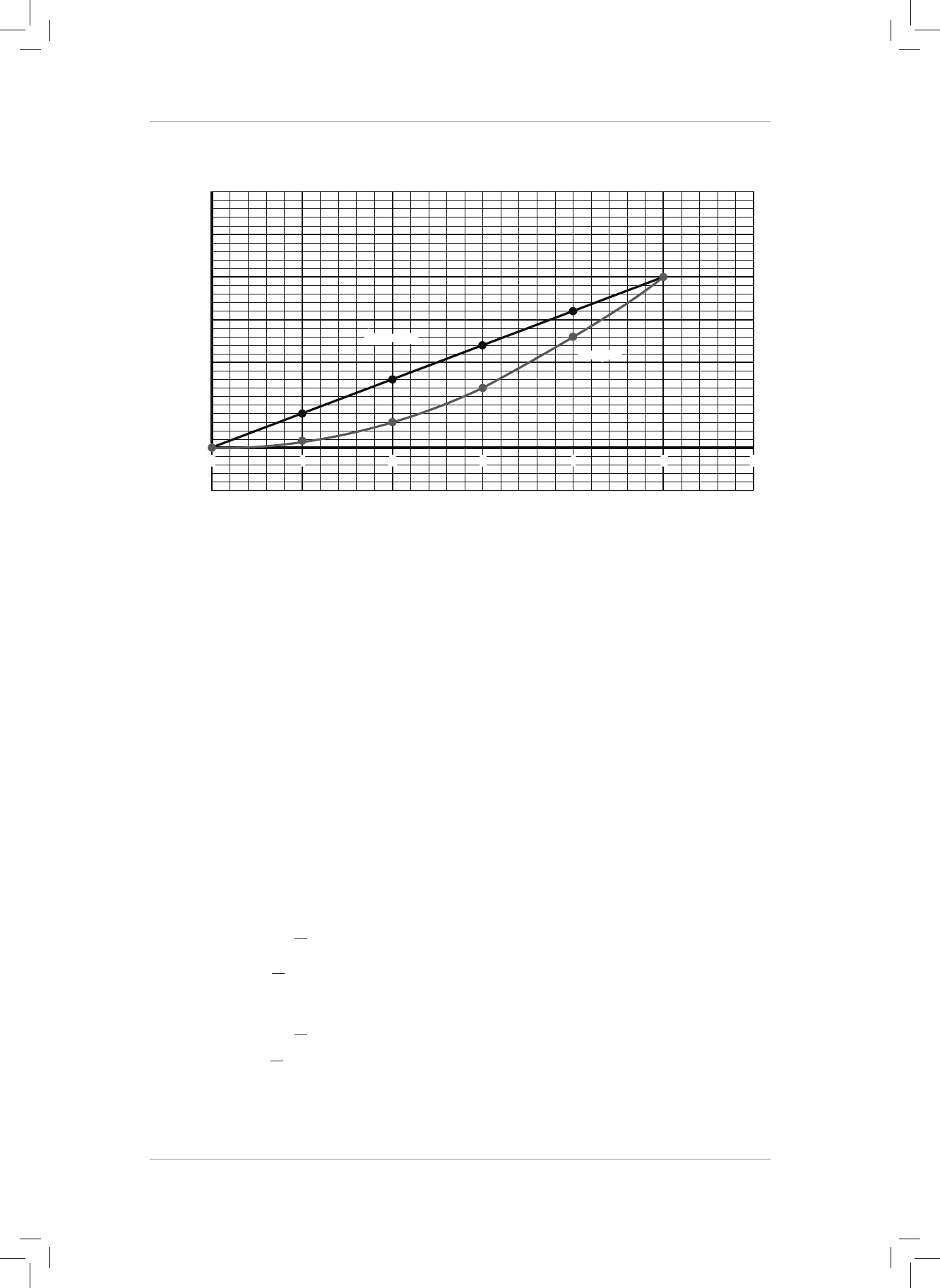
RESOURCE PACK
52 Grade 10 Physical Sciences
3. 3.1
Distance against time for two model cars
Time (s)
Distance (m)
25
20
15
10
5
0
0123456
Bongani
Ayabonga
Appropriate title for the graph
Choice of axes (Time on the horizontal axis)
Scale; axis title; SI units on vertical axis
Scale; axis title; SI units on horizontal axis
Correct plotting of points (Ayabonga)
Correct plotting of points (Bongi)
Straight-line graph (Ayabonga)
Smooth curve (parabola) (Bongi) (8)
3.2 Ayabonga’s car: Uniform (constant) velocity (1)
3.3 Bongi’s car: Uniform acceleration (1)
3.4 At 6 s, Ayabonga’s car will have travelled 24 m (Either extend the graph OR
work out that the distance increases by 4 m every second, therefore it has travelled
another 4 m)
Bongi’s car is accelerating so if you extend the curve it goes up much further than the
graph paper (shown above). erefore, Bongi’s car will have travelled further.
[Possible calculation for Bongi’s car]
xv
ta
t
2
1
i
2
TT T
=+
()
a20 0
2
1
5
2
=+
a
=
1,6 ms
−2
xv
ta
t
2
1
i
2
TT T
=+
(,)( )0
2
1
16 66
2
=+
= 28,8 m (4)
[14]
Gr10_Term3_ResourcePack.indb 52 2019/05/31 12:28:40 PM

Term 3 53
TOPIC 21: GRAPHS AND EQUATIONS OF MOTION
WORKSHEETS TOPIC 21
4. 4.1
averagevelocity
time
displacement
=
(method)
,064
2
=
(substitutions)
,(,)3 125 313
=
ms
−1
(accuracy; SI units)
downwards (direction) (4)
4.2
tan
averagespeed
time
disce
=
(method)
,,
,
064040
12
=
-
^h
(substitutions)
,50
=
ms
−1
(accuracy; SI units) (4)
4.3 e graph is shaped as parabola with the slope of the graph increasing with
time (2)
4.4 At
,:ss
2
1
06
43
2
#
=
v
i
= 3,13 ms
−1
(accuracy; c.o.e)
At
,(,,),:s040
2
1
064040 052
+-=
v
f
= 5,0 ms
−1
.
,,
,,
,ms
a
t
v
052032
500313
938
2
{
{
D
D
=
=
-
-
=
-
(substitutions; c.o.e)
(accuracy; c.o.e) (3)
[13]
5. 5.1
vv ax2
fi
22
T
=+
= (method)
= (25)2 + 2 (-1,8)(24) (substitutions)
= 538,60
,v 538 60
f
=
= 23,21 ms
−1
(accuracy; SI units) (4)
5.2 23,21 ms
−1
=
,
1 000
23 21 60 60
##
= 83,56 km.h
−1
(method)
Yes.
OR 80 km.h
−1
=
60 60
80 1 000
#
#
= = 22,22 ms
−1
(method)
Yes. (2)
[6]
6. 6.1
averagevelocity
time
displacement
=
2
10
=
(substitutions)
= 5 ms
−1
(accuracy; SI units) (2)
6.2 5 ms
−1
forward (1)
6.3 In the last 1 s of his ride, his speed increases from 5 ms
−1
to 9 ms
1
.
a
t
v
T
T
=
1
95
=
-
(substitutions; c.o.e.)
= 4,0 ms
−2
forward (accuracy; SI units) (direction) (4)
Gr10_Term3_ResourcePack.indb 53 2019/05/31 12:28:43 PM

Gr10_Term3_ResourcePack.indb 54 2019/05/31 12:28:43 PM

FORMAL
EXPERIMENT
Gr10_Term3_ResourcePack.indb 55 2019/05/31 12:28:43 PM

FORMAL EXPERIMENT
Measuring Acceleration
56 Marks
This section provides guidance and assessment of the learner’s knowledge
and understanding when carrying out a virtual experiment using the NECT
video of the same name.
If your class is carrying out the experiment using laboratory apparatus and
taking down their own results, you must set up your classroom appropriately
and give the learners the relevant instructions. You may nd it useful to
refer to the Technical Instructions which precede the Learner’s Instructions
while preparing for this experiment.
If the learners are proceeding with the virtual experiment, then continue
with the NECT programme by using the information, handouts and marking
guidelines contained in this section of this Resource Book.
Gr10_Term3_ResourcePack.indb 56 2019/05/31 12:28:43 PM
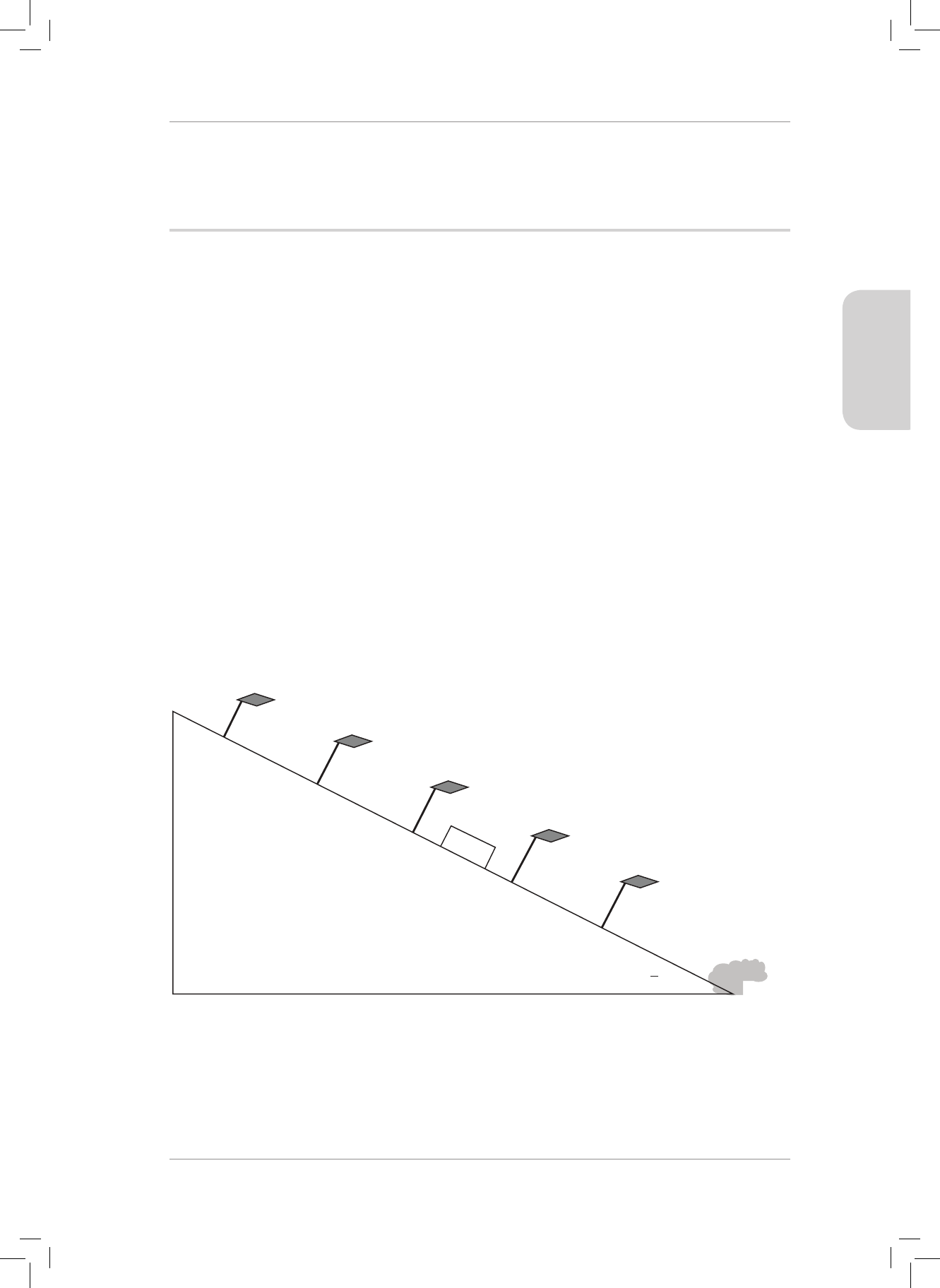
MEASURING ACCELERATION
Term 3 57
EXPERIMENT
Formal Experiment
TECHNICAL INSTRUCTIONS
AIM: TO MEASURE THE ACCELERATION OF A BLOCK SLIDING ON AN
INCLINED PLANE.
INVESTIGATIVE QUESTION:
How is the acceleration of a block sliding on an inclined plane aected by the sliding
surface of the block?
APPARATUS:
Smooth track (about 2 m long if possible)
Chalkboard duster
Prestik or double-sided sellotape
A pile of books (or bricks or other means) to raise the track to various angles of inclination.
Stopwatch
2 m tape measure
5 toothpicks
Coloured paper or material to attach to the toothpicks (to make little ags)
So cloth
Board duster
Flag 1
Flag 2
Flag 3
Flag 4
Flag 5
Cloth
0
is equipment is quite tricky to set up.
e learners may require assistance with it.
Gr10_Term3_ResourcePack.indb 57 2019/05/31 12:28:43 PM

RESOURCE PACK
58 Grade 10 Physical Sciences
METHOD:
Setting up the apparatus
1. Set up the track by raising one end of it with a pile of books. Make sure that the track is
stable and it rests rmly on the items that support it.
2. Place the board duster at the top of the track with the smooth (wooden) surface in
contact with the track.
3. Fold the so cloth and place it at the end of the track to act as a stopper for the board
duster when it reaches the bottom of the track.
4. Carry out a practice run, timing the motion of the duster for the entire length of the
track. If the time is less than 4 s, lower the track slightly so that the board duster runs a
little slower on the track.
5. Now turn the board duster over with its rough (felt) surface in contact with the track.
Carry out a practice run timing its motion down the track. If it seems to move at
constant velocity raise the track slightly to make the board duster accelerate.
6. Place the board duster at the top of the track and make a pencil mark on the track at the
front of the duster to mark this position. Place a highly visible marker at this position
on the track e.g. a toothpick with a piece of coloured paper attached to it as a little ag.
7. Make 4 more pencil marks on the track at 40 cm intervals. Place little ags at each of
these marks alongside the track.
8. It is important that the duster does not move too fast on its way down the track else
you will struggle to time it accurately. Adjust the height of the track until you can
comfortably time its run for each section, and then record the results.
Taking measurements:
1. e rst time you will record the total time from start (Flag 1) to nish (Flag 5).
2. e second time you will time from three-quarters of the way down (Flag 2 to Flag 5).
3. en the third time you will stop timing from half way down the track (Flag 3 to Flag 5).
4. Repeat these measurements (Steps 1 to 3) three times to improve the reliability of your
results.
5. When you have completed recording the times for the duster with its rough (felt)
surface down, turn the duster over so it now rests its smooth (wooden) suface.
6. Repeat the measurements (from step 1 to 4) with the track at the same inclined angle,
but this time the smooth (wooden) surface of the board duster is in contact with the
track surface.
Gr10_Term3_ResourcePack.indb 58 2019/05/31 12:28:43 PM

MEASURING ACCELERATION
Term 3 59
EXPERIMENT
NAME:
GRADE:
Formal Experiment
MEASURING ACCELERATION
56 MARKS
AIM: TO MEASURE THE ACCELERATION OF A BLOCK SLIDING ON AN
INCLINED PLANE.
Investigative question:
How is the acceleration of a block sliding on an inclined plane aected by the sliding
surface of the block?
Apparatus:
Smooth track (about 2 m long if possible)
Chalkboard duster
Prestik or double-sided sellotape
A pile of books (or bricks or other means) to raise the track to various angles of inclination.
Stopwatch
2 m tape measure
5 toothpicks
Coloured paper or material to attach to the toothpicks (to make little ags)
So cloth
Gr10_Term3_ResourcePack.indb 59 2019/05/31 12:28:43 PM
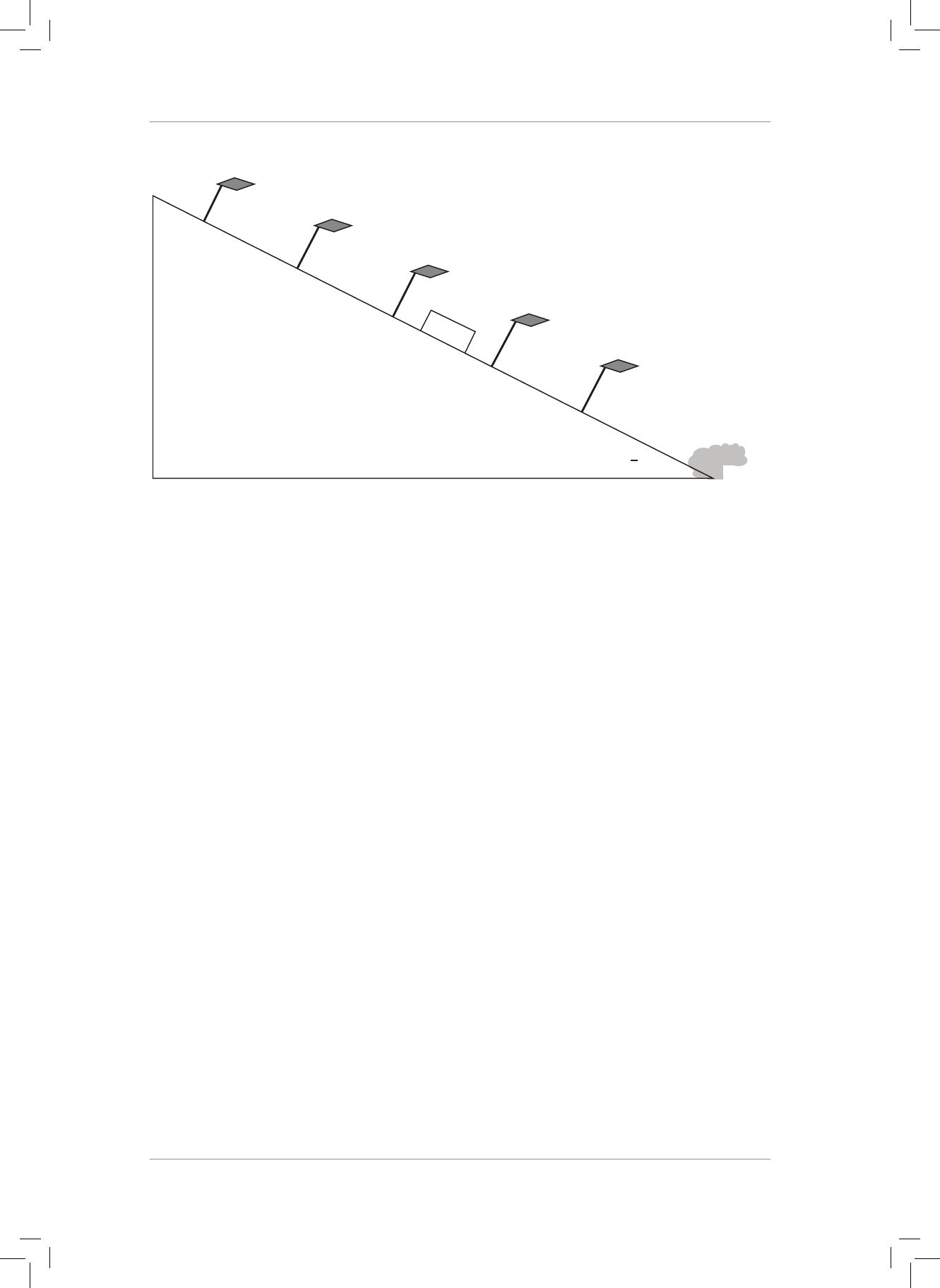
RESOURCE PACK
60 Grade 10 Physical Sciences
Board duster
Flag 1
Flag 2
Flag 3
Flag 4
Flag 5
Cloth
0
METHOD:
Setting up the apparatus
1. Set up the track by raising one end of it with a pile of books or boxes. Make sure that the
track is stable and it rests rmly on the items that support it.
2. Place the board duster at the top of the track with the smooth (wooden) surface in
contact with the track.
3. Carry out a practice run, timing the motion of the duster for the entire length of the
track. If the time is less than 2 s, lower the track slightly so that the duster runs a little
slower on the track.
4. Now turn the duster over with its rough (felt) surface in contact with the track. Carry
out a practice run timing its motion down the track. If the duster seems to move at
constant velocity raise the track slightly to make the duster accelerate.
5. Place the duster at the top of the track and make a pencil mark on the track at the front
of the duster so that it always starts exactly at this position. Place a highly visible marker
at this position on the track e.g. a toothpick with a piece of coloured paper attached to it
as a little ag.
6. Make 4 more pencil marks on the track at 40 cm intervals. Place little ags at each of
these marks alongside the track.
7. It is important that the duster does not move too fast on its way down the track else
you will struggle to time it accurately. Adjust the height of the track until you can
comfortably time its run for each section, and then record the results.
NB In the video we used the time recorded by the movie camera to time the run of the
duster down the track.
Gr10_Term3_ResourcePack.indb 60 2019/05/31 12:28:43 PM

MEASURING ACCELERATION
Term 3 61
EXPERIMENT
Taking measurements:
1. e rst time you will record the total time from start (Flag 1) to nish (Flag 5).
2. e second time you will time from three-quarters of the way down (Flag 2 to Flag 5).
3. en the third time you will time from half way down the track (Flag 3 to Flag 5).
4. Repeat these measurements (Steps 1 to 3) three times to improve the reliability of your
results.
5. When you have completed recording the times for the duster with its rough side down,
turn the duster over so it now rests on its smooth (wooden) surface.
6. Repeat the measurements (from step 1 to 4) with the track at the same inclined angle,
but this time the smooth (wooden) surface of the board duster is in contact with the
track surface.
RESULTS:
Theory
e board duster accelerates uniformly down the track. We measure the distance travelled
and the time taken. e duster starts from an initial velocity of zero.
xvtt
at
xat
2
1
2
1
i
2
2
DDD
DD
=++
=
We plot a graph of ∆x against (∆t)
2
to determine the acceleration.
Gr10_Term3_ResourcePack.indb 61 2019/05/31 12:28:44 PM

RESOURCE PACK
62 Grade 10 Physical Sciences
Questions
1. Fill in a title for this table.
Watch the video and record the readings.
Table of results: _________________________________________________ (1)
Surface of
board duster
Calculations
Time (s)
(160 cm)
Time (s)
(120 cm)
Time (s)
(80 cm)
Smooth
(wooden
side)
Average Time (∆t)
(Time)
2
= (∆t)
2
Rough
(felt side)
Average Time (∆t)
(Time)
2
= (∆t)
2
(20)
2. On the same piece of graph paper, plot a graph of Distance against the Square of Time.
Place the square of time (∆t
2
) on the x-axis, and distance on the y-axis. Draw the best t
line for each graph, and label the graphs as Rough and Smooth. (11)
3. Describe the shape of the graphs. (2)
Gr10_Term3_ResourcePack.indb 62 2019/05/31 12:28:44 PM
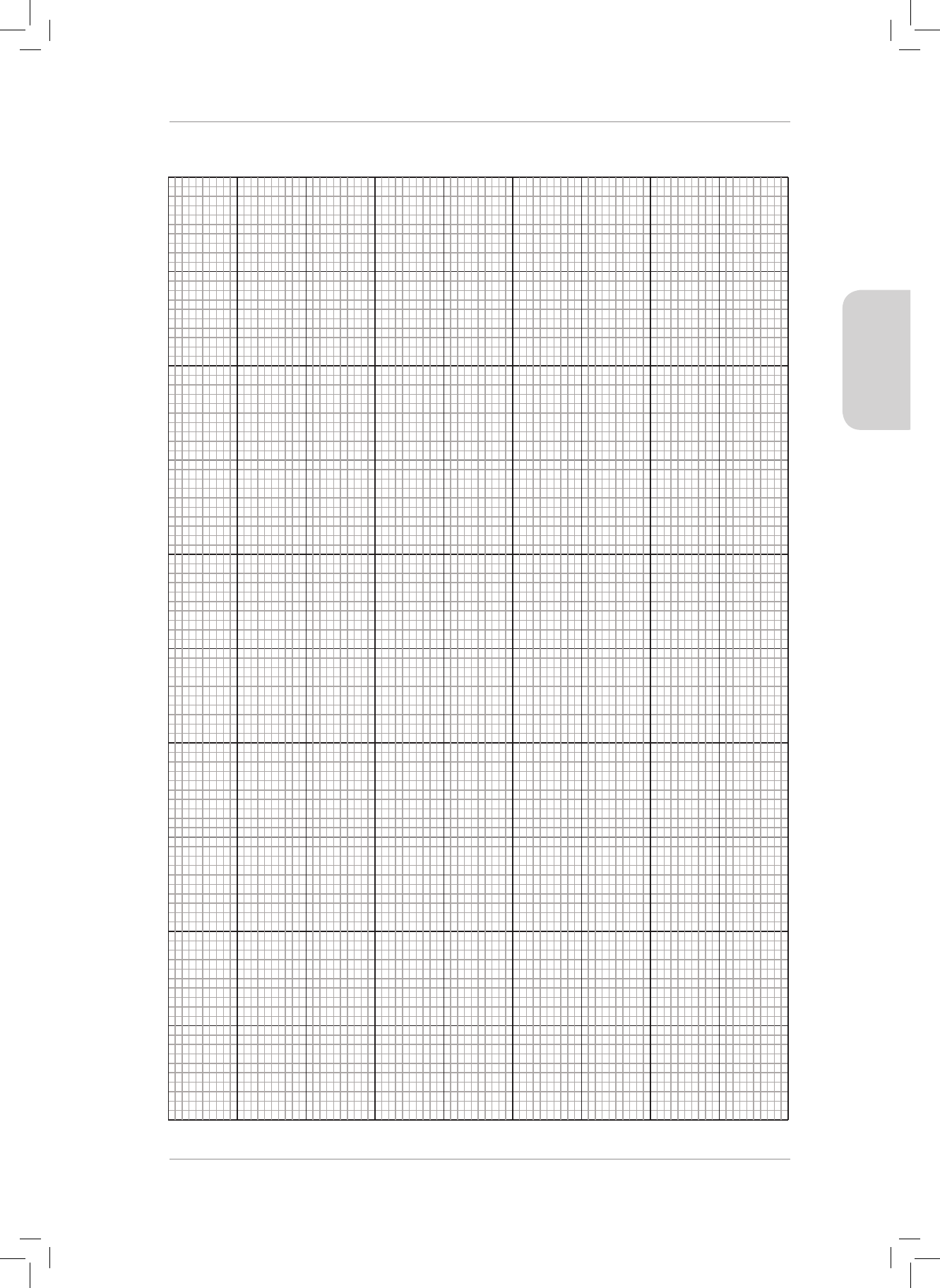
MEASURING ACCELERATION
Term 3 63
EXPERIMENT
Gr10_Term3_ResourcePack.indb 63 2019/05/31 12:28:44 PM

RESOURCE PACK
64 Grade 10 Physical Sciences
4. Describe (in words) the relationship between the distance and time
2
as the duster
accelerated down the slope,
a. with its rough surface in contact with the track. (2)
b. with its smooth surface in contact with the track. (2)
5. Calculate the gradient of the distance - time
2
graph
a. with its rough surface in contact with the track. (4)
b. with its smooth surface in contact with the track. (4)
6. What quantity does the gradient of the distance – time
2
graph represent? Briey justify
your answer. (4)
Gr10_Term3_ResourcePack.indb 64 2019/05/31 12:28:44 PM

MEASURING ACCELERATION
Term 3 65
EXPERIMENT
7. Calculate and compare the acceleration of the duster when it slides on its two dierent
surfaces (rough and smooth). (2)
8. Explain why the duster accelerates at dierent rates when dierent surfaces are in
contact with the track. (2)
Conclusion (2)
Gr10_Term3_ResourcePack.indb 65 2019/05/31 12:28:44 PM

RESOURCE PACK
66 Grade 10 Physical Sciences
MARKING GUIDELINES
56 MARKS
AIM: TO MEASURE THE ACCELERATION OF A BLOCK SLIDING ON AN
INCLINED PLANE.
Investigative question:
How is the acceleration of a block sliding on an inclined plane aected by the sliding
surface of the block?
Theory
e board duster accelerates uniformly down the track. We measure the distance travelled
and the time taken. e duster starts from an initial velocity of zero.
We plot a graph of Distance (∆x) against the Square of time (∆t
2
) against to determine the
acceleration.
QUESTIONS
1. Table of results: Time taken for board duster to accelerate down track (1)
SURFACE
OF BOARD
DUSTER
CALCULATIONS
TIME (S)
(160 CM)
TIME (S)
(120 CM)
TIME (S)
(80 CM)
Smooth
2,33
2,45
2,42
2,01
2,04
2,09
1,69
1,69
1,69
Average Time (∆t) s 2,40 2,05 1,69
(Time)
2
= (∆t)
2
s
2
5,76 4,20 2,86
Rough
2,84
2,79
2,80
2,40
2,42
2,36
2,03
2,00
1,99
Average Time (∆t) s
2,81 2,39 2,01
(Time)
2
= (∆t)
2
s
2
7,90 5,71 4,04
(20)
2. On the same piece of graph paper, plot a graph of Distance against the Square of Time.
Place the square of time (∆t
2
) on the x-axis, and distance on the y-axis. Draw the best t
line for each graph, and label the graphs as Rough and Smooth.
Gr10_Term3_ResourcePack.indb 66 2019/05/31 12:28:44 PM
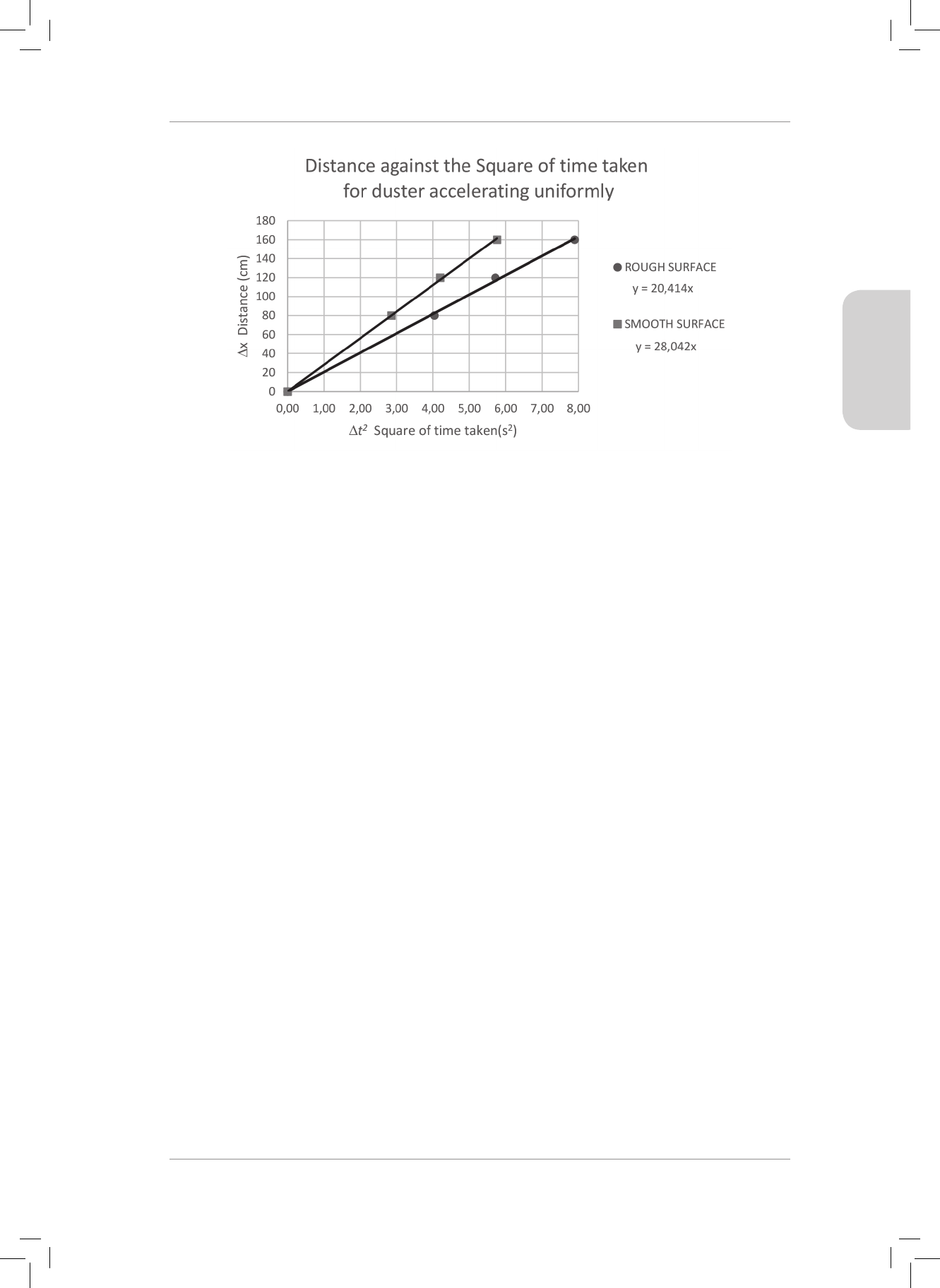
MEASURING ACCELERATION
Term 3 67
EXPERIMENT
Marking the graph: (11)
Appropriate title (heading) e.g. Time2 vs Distance graphs for duster sliding on the track.
Correct choice of axes: Distance on x-axis.
Appropriate scale on x-axis with label and SI units.
Appropriate scale on y-axis with label and SI units.
Points plotted correctly (rough).
Points plotted correctly (smooth).
Rough and smooth graphs labelled (correctly).
Best t straight-line graphs drawn with a ruler.
Graphs extended back to cut the y-axis (Must be the same straight-line as the graph).
[ NB: It is unnecessary to write the equation on the graph. It appears in the legend on this
graph just for the teacher's information.]
3. Describe the shape of the graphs.
Straight-line graph passing through the origin. (2)
Gr10_Term3_ResourcePack.indb 67 2019/05/31 12:28:44 PM

RESOURCE PACK
68 Grade 10 Physical Sciences
4. Describe (in words) the relationship between the square of time and distance as the
board duster accelerated down the slope
a. with its rough surface in contact with the track.
e square of time taken is directly proportional to the distance (displacement).
(2)
b. with its smooth cardboard surface in contact with the track.
e square of time taken is directly proportional to the distance (displacement).
(2)
NB. If written the other way around award half marks each time. e independent
variable is the distance travelled.
5. Calculate the gradient of the graph.
a. with its rough surface in contact with the track. (4)
method: gradient =
x
y
D
D
appropriate coordinates taken from the graph
accurate calculation (0,4 cms
-2
= 0,20 ms
-2
)
b. with its smooth surface in contact with the track. (4)
method: gradient =
x
y
D
D
appropriate coordinates taken from the graph
accurate calculation (28,8 cms
-2
= 0,28 ms
-2
)
6. What quantity does the gradient of the time
2
-distance graph represent? Briey justify
your answer.
ymx
=
xa
t
2
1
2
DD
=
ma
2
1
=
(4)
7. Calculate and compare the acceleration of the board duster when it slides on its two
dierent surfaces (rough and smooth).
e acceleration of the duster when it slides on its smooth surface is 0,56 ms
2
which
is greater than 0,40 ms
2
when it slides on its rough surface. (2)
8. Explain why the board duster accelerates at dierent rates when dierent surfaces are in
contact with the track.
e duster experiences greater friction with the rough surface in contact with the
track. (2)
Conclusion
e smoother the surface, the greater the acceleration of the duster on the inclined
plane. (2)
Gr10_Term3_ResourcePack.indb 68 2019/05/31 12:28:45 PM

ASSESSMENTS
Gr10_Term3_ResourcePack.indb 69 2019/05/31 12:28:45 PM

RESOURCE PACK
70 Grade 10 Physical Sciences
QUESTIONS
MULTIPLE CHOICE
1. e name of the process that takes place when ions become surrounded by water
molecules in aqueous solution is called:
A dissolving.
B hydration.
C precipitation.
D ion exchange. (2)
2. Consider the following statements:
I e electrical conductivity of a solution depends on the concentration of
the ions in the solution.
II e electrical conductivity of a solution depends on the extent of
ionisation in the solution.
III A solution only conducts electricity when there is no ionisation in the solution.
Which statement(s) is/are correct?
A I and II only
B II and III only
C I and III only
D III only (2)
3. Which of the following anions forms a white precipitate with barium chloride
solution?
A Cl
−
(aq)
B Cl
−
(aq) and SO
4
2−
(aq)
C SO
4
2−
(aq) and CO
3
2−
(aq)
D I
−
(aq) and CO
3
2−
(aq) (2)
4. What type of reaction is represented by the following equation?
$
() () () () ()BaCO sHCaqBaC aq CO gHOlll2
3222
+++
A Ionisation
B Precipitation
C Redox
D Gas forming (2)
Gr10_Term3_ResourcePack.indb 70 2019/05/31 12:28:48 PM

Term 3 71
TOPIC 17: REACTIONS TO AQUEOUS SOLUTION
ASSESSMENTS
5. Which one of the following is not an ion exchange reaction?
A Precipitation reaction
B Redox reaction
C Acid base reaction
D Gas forming reaction (2)
6. A colourless solution is tested for the presence of an anion and the following
observations are made:
I A white precipitate forms when barium chloride solution is added to it.
II e precipitate dissolves when a few drops of dilute nitric acid are
added to it.
e anions contained in the original solution could be:
A sulfate anions.
B chloride anions.
C bromide anions.
D carbonate anions. (2)
LONG QUESTIONS
7. 7.1 What is meant by the term dipole? (2)
7.2 What is meant by the term dissolving? (2)
7.3 Explain the meaning of the term dissociation. (2)
7.4 Explain, in detail, how potassium chloride crystals dissolve in water. (4)
8. 8.1 Explain why some ionic substances do not dissolve in water. (3)
8.2 Write down balanced reaction equations for each of the following
substances dissolving in water. (Remember to include phase symbols).
I
()ANOl
33
(3)
II
PbCl
4
(3)
9. 9.1 What is meant by the term electrolyte? (2)
9.2 Why is the brightness of a light bulb used to indicate the extent of
conductivity of an electrolyte solution? (3)
9.3 List two factors that have an eect on how brightly a light bulb glows when
testing an electrolyte solution. (2)
10. 10.1 Explain how the two factors that you mentioned in the previous question
have the eect you described. (4)
10.2 Describe, in detail, how a solution of sodium bromide is able to conduct
electricity. (4)
11. You are provided with three colourless solutions, A, B and C, which contain
sodium chloride, sodium bromide and sodium iodide respectively. Describe a
way in which you can distinguish which solution contains which substance. (4)
Gr10_Term3_ResourcePack.indb 71 2019/05/31 12:28:51 PM

RESOURCE PACK
72 Grade 10 Physical Sciences
12. Write down balanced net ionic equations for each of the following reactions and
then state what type of reaction takes place.
12.1 Magnesium carbonate reacts with sulfuric acid (5)
12.2 Barium chloride solution reacts with potassium sulfate solution (4)
12.3 Potassium hydroxide solution reacts with nitric acid (4)
Gr10_Term3_ResourcePack.indb 72 2019/05/31 12:28:51 PM

Term 3 73
TOPIC 17: REACTIONS TO AQUEOUS SOLUTION
ASSESSMENTS
MARKING GUIDELINES
MULTIPLE CHOICE
1. B
{
{
e statement given is the denition of hydration. [CL 2] (2)
2. A
{
{
Statement III is not correct because liquids will conduct electricity
only when there are ions present in the solution. [CL 2] (2)
3. C
{
{
Cl
-
ions and
I
-
ions only form precipitates with silver nitrate
solution not with barium chloride solution. [CL 3] (2)
4. D
{
{
One of the products in the equation given is a gas, so this
represents a gas forming reaction. [CL 3] (2)
5. B
{
{
A redox reaction does not involve ion exchange. It involves the
transfer of electrons. [CL 2] (2)
6. D
{
{
Sulfate ions also form a white precipitate with barium chloride
solution but the precipitate does not dissolve in nitric acid. [CL 3] (2)
LONG QUESTIONS
7. 7.1 A dipole is a molecule which has one end that is partially charged with
respect to the opposite end.
{
{
[CL 1] (2)
7.2 Dissolving is the process by which solid crystals break up into their
individual molecules or ions in water.
{
{
[CL 1] (2)
7.3 Dissociation is the separation of positive and negative ions from each other
when they go into solution.
{
{
[CL 1] (2)
7.4 In potassium chloride, the potassium ions are positive and the chloride
ions are negative. e positive ends of the water molecules are attracted to
the chloride ions
{
and the negative ends are attracted to the potassium
ions.
{
A lot of water molecules surround each ion,
{
and they attract the
ions suciently to make them leave the lattice and go into solution.
{
[CL 3] (4)
8. 8.1 In some ionic compounds, the attractive forces between the positive and
negative ions are so strong,
{
that the water molecules can’t attract them
strongly enough
{
to make them go into solution.
{
[CL 3] (3)
8.2 I
$
()() () ()ANOs AaqNOaqll3
33
3
3
{{{
+
+-
{
[CL 2] (3)
II
$
() () ()PbCs Pb aq Caqll4
4
4
{{
{
+
+-
{
[CL 2] (3)
9. 9.1 An electrolyte is a solution that conducts electricity because it contains
ions.
{
{
[CL 1] (2)
9.2 e brightness of a light bulb in a circuit such as this depends on the
current passing through it.
{
e more ions that reach the electrodes per
unit time, the greater the current.
{
So, the current and the brightness
indicate the extent of ionisation.
{
[CL 4]
(3)
Gr10_Term3_ResourcePack.indb 73 2019/05/31 12:29:01 PM

RESOURCE PACK
74 Grade 10 Physical Sciences
9.3 Two factors are:
• e concentration of the ions in the solution.
{
• e extent of ionisation of the substance in solution.
{
[CL 2] (2)
10. 10.1 e higher the concentration of the ions in solution, the greater the
number of ions reaching the electrodes per unit time
{
and the greater the
current.
{
e higher the extent of solution of the substance the greater the number
of ions in the solution
{
and the greater the number of ions reaching the
electrodes per unit time.
{
[CL 4] (4)
10.2 A solution of sodium bromide contains positive sodium ions and negative
bromide ions.
{
e positive ions are attracted to the negative electrode
{
and the negative ions are attracted to the positive electrode.
{
e
movement of ions makes up a current in the solution.
{
[CL 4] (4)
11. Add a few drops of silver nitrate solution to each of the test tubes.
{
e one that
produces a white precipitate contains the sodium chloride solution.
{
e one
that produces a light yellow precipitate is the sodium bromide solution.
{
e
one that produces a yellow precipitate is the sodium iodide solution.
{
[CL 2] (4)
12. 12.1 CO
3
2−
(aq)
{
+ 2H
+
(aq)
{
→ CO
2
(g)
{
+ H
2
O(l)
{
gas forming reaction
{
[CL 3] (5)
12.2 Ba
2+
(aq)
{
+ SO
4
2−
(aq)
{
→ BaSO
4
(s)
{
precipitation reaction
{
[CL 3] (4)
12.3 OH
−
(aq)
{
+ H
+
(aq)
{
→ H
2
O(l)
{
acid base reaction
{
[CL 3] (4)
Gr10_Term3_ResourcePack.indb 74 2019/05/31 12:29:03 PM

Term 3 75
TOPIC 18: QUANTITATIVE ASPECTS OF CHEMICAL CHANGE
ASSESSMENTS
Chemical Change
QUESTIONS
MULTIPLE CHOICE
1. Which one of the following does NOT consist of approximately 1 mole of atoms?
A 19 g of uorine atoms
B 23 g of sodium
C 71 g of chlorine gas
D
,6022 10
23
#
atoms of helium (2)
2. Which of the following statements is/are true?
I One mole of any element or compound will always contain the same
number of elementary particles.
II e Avogadro constant is the number of atoms only in one mole.
III e relative atomic mass of any element, expressed in grams,
contains one mole of atoms of that element.
A I and III
B II and III
C II only
D I only (2)
3. e number of moles of oxygen gas in
,dm672
3
at STP is ...
A 3,00.
B 0,30.
C 0,13.
D 0,15. (2)
4. 1 mole is the number of atoms in ...
A 6 g of carbon.
B 12 g of magnesium.
C 40 g of calcium.
D 10 g of neon. (2)
5.
,dm11 2
3
of a certain gas, at STP, has a mass of 20 g. e gas could be:
A
SO
2
B
Ne
C
Ar
D
CH
4
(2)
Gr10_Term3_ResourcePack.indb 75 2019/05/31 12:29:15 PM

RESOURCE PACK
76 Grade 10 Physical Sciences
6. Which one of the following contains
,6022 10
23
#
molecules?
A 10 g of potassium
B 1 g of hydrogen gas
C 4 g of helium gas
D 28 g of nitrogen gas (2)
LONG QUESTIONS
7. Calculate:
7.1 the number of moles of molecules in 6,3 g of
HNO
3
. (3)
7.2 the mass of
,dm11 2
3
of
CO
2
at STP. (4)
8. Which one of the following contains the greater number of moles of oxygen atoms?
a. 21 g of
HNO
3
or
b. 21 g of
CO
2
Show all calculations used to arrive at your answer. (7)
9. 9.1 A calcium mineral consists of 29,40% calcium, 23,50% sulfur and 47,10%
oxygen by mass. Determine the empirical formula of the mineral. (5)
9.2 Calculate the percentage composition by mass of calcium hydrogen
carbonate,
()Ca HCO
32
. (5)
10. A sample of a certain compound contains 0,3 g of carbon, 0,05 g of hydrogen and
0,95g of uorine. e compound has a molar mass of
.
gmol104
1
-
.
Determine:
10.1 the empirical formula of the compound. (5)
10.2 the molecular formula of the compound. (2)
11. e reaction between magnesium and dilute hydrochloric acid is represented by
the balanced reaction equation below:
$
() () () ()Mg sHCaqMgC aq Hgll2
22
++
Calculate:
11.1 the mass of magnesium chloride produced when 1,5 g of magnesium
reacts completely with dilute hydrochloric acid. (5)
11.2 the volume of hydrogen gas produced, at STP, when 17,75 g of
hydrochloric acid reacts completely with magnesium. (5)
12. e reaction equation represents the reaction that occurs when methane gas
burns in air:
$
() () () ()CH gOgCOg HOg22
42 22
++
12.1 Calculate the mass of oxygen that reacted with methane to produce 3mol
of water molecules. (3)
12.2 Calculate the mass of carbon dioxide produced when 3,2 g of methane
burn completely in air. (5)
Gr10_Term3_ResourcePack.indb 76 2019/05/31 12:29:33 PM

Term 3 77
TOPIC 18: QUANTITATIVE ASPECTS OF CHEMICAL CHANGE
ASSESSMENTS
MARKING GUIDELINES
MULTIPLE CHOICE
1. C
{
{
71 g of chlorine contains 1 mole of molecules of chlorine, not
atoms. Chlorine occurs in nature as diatomic molecules of
Cl
2
.
[CL3] (2)
2. D
{
{
Statement II is incorrect because the Avogadro constant is the
number of elementary particles, which are not necessarily atoms.
Statement III is incorrect because some elements consist of
diatomic molecules. [CL 2] (2)
3. B
{
{
m
n
V
V
=
,
,
672
22 4
=
= 0,3 mol [CL 2] (2)
4. C
{
{
e other options are all 0,5 mol. Remember that [CL 2] (2)
n
M
m
=
5. C
{
{
,dm11 2
3
corresponds to 0,5 mol. is means that the molar mass
of the gas must be
.
gmol40
1
-
. e only gas of those given that has
this molar mass is Ar. [CL 4] (2)
6. D
{
{
e only two substances that are made up of molecules are B and
D.
,6022 10
23
#
molecules is 1 mole. e molar mass of hydrogen
(
H
2
) is
.
.gmol2
1
-
[CL 3] (2)
LONG QUESTIONS
7. 7.1.
() ()HNOM 114316
3
#
=+ +
n
M
m
=
.
gmol63
1
=
-
,
63
63
{
{
=
= 0,1 mol
{
[CL 2] (3)
7.2 First determine the number of moles of gas.
n
V
V
m
=
,
,
11 2
22 4
{=
=0,5 mol
{
Now determine the mass:
mnM
#
=
,05 44#=
{
= 22 g
{
[CL 3] (4)
Gr10_Term3_ResourcePack.indb 77 2019/05/31 12:30:00 PM

RESOURCE PACK
78 Grade 10 Physical Sciences
8. First calculate the number of moles of molecules of each:
a.
n
M
m
=
21
63
=
{
= 0,33 mol
{
b.
n
M
m
=
21
44
=
{
= 0,48 mol
{
Now calculate the number of moles of oxygen atoms in each:
a. In
HNO
3
, there are 3 mol of oxygen atoms per mole of molecules
`
no.of moles of
,,Oatoms mol0333099#==
of O atoms.
{
b. In
CO
2
, there are 2 mol of oxygen atoms per mole of molecules
`
no.of moles of
,,Oatoms mol0482096#==
of O atoms.
{
So, 21 g of
HNO
3
contains more moles of oxygen atoms.
{
[CL 4] (7)
9. 9.1 Assuming we have a 100 g sample of the mineral, then
,
,m
oln
M
m
40
29 4
074
Ca
{
== =
,
,m
oln
M
m
32
23 5
073
S
{
== =
,
,n
M
m
16
47 1
294
O
{
== =
Ratio of
:; ,:,:,Ca SO 074073 294=
(divide through by 0,73)
Whole number ratio
::114=
{
Empirical formula is
CaSO
4
{
[CL 2] (5)
9.2 First determine the molar mass:
[( )] ()Ca HCOM 40 21 12 316
32
#
=+ ++
.
gmol162
1
=
-
{
%,
%Ca
162
40
100 24 70#
==
{
%,
%H
162
2
100 123#
==
{
%,
%C
162
24
100 14 81#
==
{
%,
%O
162
96
59 25100#
==
{
[CL 2] (5)
10. 10.1 Determine the number of moles of each element:
,
,n
M
m
12
03
0 025
C
== =
{
,
,n
M
m
1
005
005
H
==
=
{
,
,n
M
m
19
095
005
F
==
=
{
Ratio of
:: ,:,:,CHF 0025 005005=
(divide through by 0,025)
Whole number ratio
::122=
{
Empirical formula
CH F
22
=
{
[CL 3] (5)
Gr10_Term3_ResourcePack.indb 78 2019/05/31 12:30:21 PM

Term 3 79
TOPIC 19: VECTORS
ASSESSMENTS
10.2 First determine the molar mass of the empirical formula:
(F)()( )CHM 12 21 219
22
##
=+ +
.
gmol52
1
=
-
{
e molar mass of the compound is
.
gmol104
1
-
e molar mass of the compound is 2 times the molar mass of the
empirical formula, so the molecular formula will be
CHF
244
.
{
[CL 4] (2)
11. 11.1 First calculate the number of moles of magnesium:
n
M
m
=
,15
24
=
{
= 0,0625 mol
{
1 mol Mg produces 1 mol
MgCl
2
0,0625 mol Mg produces 0,0625 mol
MgCl
2
M(MgC
2
) = 24 + (2 × 35,5) = 95 gmol
−1
{
m = nM
= 0,0625 × 95
{
= 5,94 g
{
[CL 2] (5)
11.2 Calculate the number of moles of
HCl
n
M
m
=
,
,
17 75
36 5
=
{
=0,49 mol
{
2 mol
HCl
produces 1 mol
H
2
.
0,49 mol
HCl
produces 0,25 mol
H
2
.
{
VnV
m
#
=
,,025224#=
{
,dm56
3
=
{
[CL 2] (5)
12. 12.1 1 mole of methane produces 2 moles of water
1,5 moles of methane produces 3 moles of water
{
mnM
#
=
,15 16#=
{
= 24 g
{
[CL 2] (3)
12.2 Calculate the number of moles of methane:
n
M
m
=
,32
16
=
{
=0,2 mol
{
1 mol
CH
4
produces 1 mol
CO
2
.
0,2 mol
CH
4
produces 0,2 mol
CO
2
.
{
mnM
#
=
,02 44#=
{
= 8,8 g
{
[CL 2] (5)
Gr10_Term3_ResourcePack.indb 79 2019/05/31 12:30:40 PM

RESOURCE PACK
80 Grade 10 Physical Sciences
QUESTIONS
MULTIPLE CHOICE
1. Which of the following quantities is not a vector quantity?
A distance
B force
C velocity
D acceleration
(2)
2. Which of the following pairs of quantities has one scalar and one vector quantity?
A distance and speed
B displacement and velocity
C acceleration and time
D force and acceleration
(2)
3. A father drove his children to school which is located 15 km east from their
home. He then drove from the school to his workplace which is 10 km east of the
school. Aer work the man drove 15 km west to the shop, and nally he drove
back home.
Which of the following statements is TRUE?
A e total distance the man travelled from home to his workplace is 30 km.
B e magnitude of the displacement from his home to the shop is 25 km.
C e magnitude of the displacement from the school from the shop is 5 km.
D e magnitude of the displacement for the whole trip is 40 km.
(2)
4. An athlete jogs along the following route in the early morning. She runs 2 km
east then 6 km north. en she jogs for 5 km west and 6 km south. At this stage
she stops and takes a short rest. What is the magnitude of her displacement from
her home at this point?
A 1 km
B 3 km
C 7 km
D 19 km (2)
5. Which statement best describes a property of the resultant of the two forces?
A e resultant is always in the same direction as the two forces.
B e resultant produces the same eect as the two forces acting together.
C e resultant keeps the object in equilibrium (at rest).
D e resultant is in the same direction as the equilibrant. (2)
Gr10_Term3_ResourcePack.indb 80 2019/05/31 12:30:40 PM

Term 3 81
TOPIC 19: VECTORS
ASSESSMENTS
7N
9N
5N
A
I Neo walks 800 m in a straight line on a bearing of 210º.
II Daniel walks 50 m due north then turns aroun and walks 150 m
due south.
III Unathi walks four times round a circular athletics track with a
circumference of 440 m and stops when he gets back to his
starting position again.
*6. ree forces keep a body at point A
in equilibrium. If the force of 5 N is
suddenly removed, the magnitude of the
resultant force exerted on the body at A
will be…
A 2 N
B 5 N
C 7 N
D 9 N
(2)
7. Two displacement vectors of magnitudes 20 cm and 80 cm are added. Which one
of the following is the ONLY possible choice for the magnitude of the resultant?
A 0 cm
B 28 cm
C 82 cm
D 114 cm (2)
LONG QUESTIONS
8. Read and use the facts contained in the following statements to answer the
questions that follow.
8.1 Clearly distinguish between distance and displacement. (3)
8.2 Write down the distance walked by Neo. (2)
8.3 Write down the magnitude of the displacement of Unathi. (2)
8.4 Calculate Daniel’s displacement. (3)
Gr10_Term3_ResourcePack.indb 81 2019/05/31 12:30:40 PM

RESOURCE PACK
82 Grade 10 Physical Sciences
9. Lindiwe walks to school every morning as shown in the diagram.
school
grounds
school
gate
Railway lines Bridge
Lindiwe’s home
Lindiwe’s route
to school
Scale:
on the diagram
represents 22 m.
N
9.1 Find the distance that Lindiwe walks every morning from home to the
school gates. (2)
9.2 What is her displacement at the school gate? (2)
9.3 What is her displacement when she gets home? (1)
10. ree forces, as descibed below, are simultaneously applied to an object.
a) 37 N to the right
b) 20 N to the right
c) 35 N to the le
10.1 Dene the resultant force. (2)
10.2 Determine the resultant force acting on the object, by using a vector
diagram or by calculation. Show your method clearly.
(4)
11. A car is driven around a racetrack at a constant speed. e track has the
dimensions shown in the diagram below. e straight stretch is 2 km long, in an
easterly direction. e semi-circular curve is 1 km long. e car travels clockwise
around the track (from A to B to C to D and back to A again).
AB
CD
2 km
1 km
637 m
N
11.1 What is the distance travelled in one complete lap of the track? (2)
11.2 What is the displacement of the car aer one complete lap? (2)
11.3 Find the magnitude of the car’s displacement at point C. (2)
11.4 What distance has the car covered when it reaches point C? (2)
Gr10_Term3_ResourcePack.indb 82 2019/05/31 12:30:41 PM

Term 3 83
TOPIC 19: VECTORS
ASSESSMENTS
MARKING GUIDELINES
MULTIPLE CHOICE
1. A
{
{
Distance is the length of the path travelled. It requires only
magnitude (and does not require direction). [CL 2] (2)
2. C
{
{
Acceleration is a vector quantity. Time is a scalar. [CL2] (2)
3. C
{
{
e school is 15 km east of the home, and his workplace is a
further 10 km east. He returns to his home by travelling west for 15
km to the shop, then going home.
erefore the shop is 10 km east of his home. e school is 15 km
east of his home, therefore the school is 5 km from the shop. [CL 3] (2)
4. B
{
{
Taking her displacements in the east-west directions:
2 km east + 5 km west = 3 km west.
Taking her displacement in the north-south directions:
6 km north + 6 km south = 0 km
Her overall displacement is therefore 3 km west. [CL 4] (2)
5. B
{
{
is statement is a denition of the resultant force. [CL 2] (2)
6. B
{
{
e resultant of all three forces is zero. Removing one force leaves
the other two with a resultant that acts in the opposite direction to
the force that is removed and is of the same magnitude as the force
which is removed. [CL 4] (2)
7. C
{
{
e minimum resultant is 80 cm – 20 cm = 60 cm therefore
options A and B are invalid. e maximum resultant is 80 cm + 20
cm = 100 cm therefore option D is invalid. [CL 3] (2)
LONG QUESTIONS
8. 8.1 Distance is the total length of the path travelled.
{
Displacement is the change in position.
{
{
[CL1]
(3)
8.2 800 m
{
{
[CL1]
(2)
8.3 0 m
{
{
(He returns to his original position) [CL2] (2)
8.4 Displacement
()50 150=+ +-
{
(method)
100=-
(accuracy)
msouth100 { {
=
(SI units; direction) [CL2] (3)
Gr10_Term3_ResourcePack.indb 83 2019/05/31 12:30:44 PM
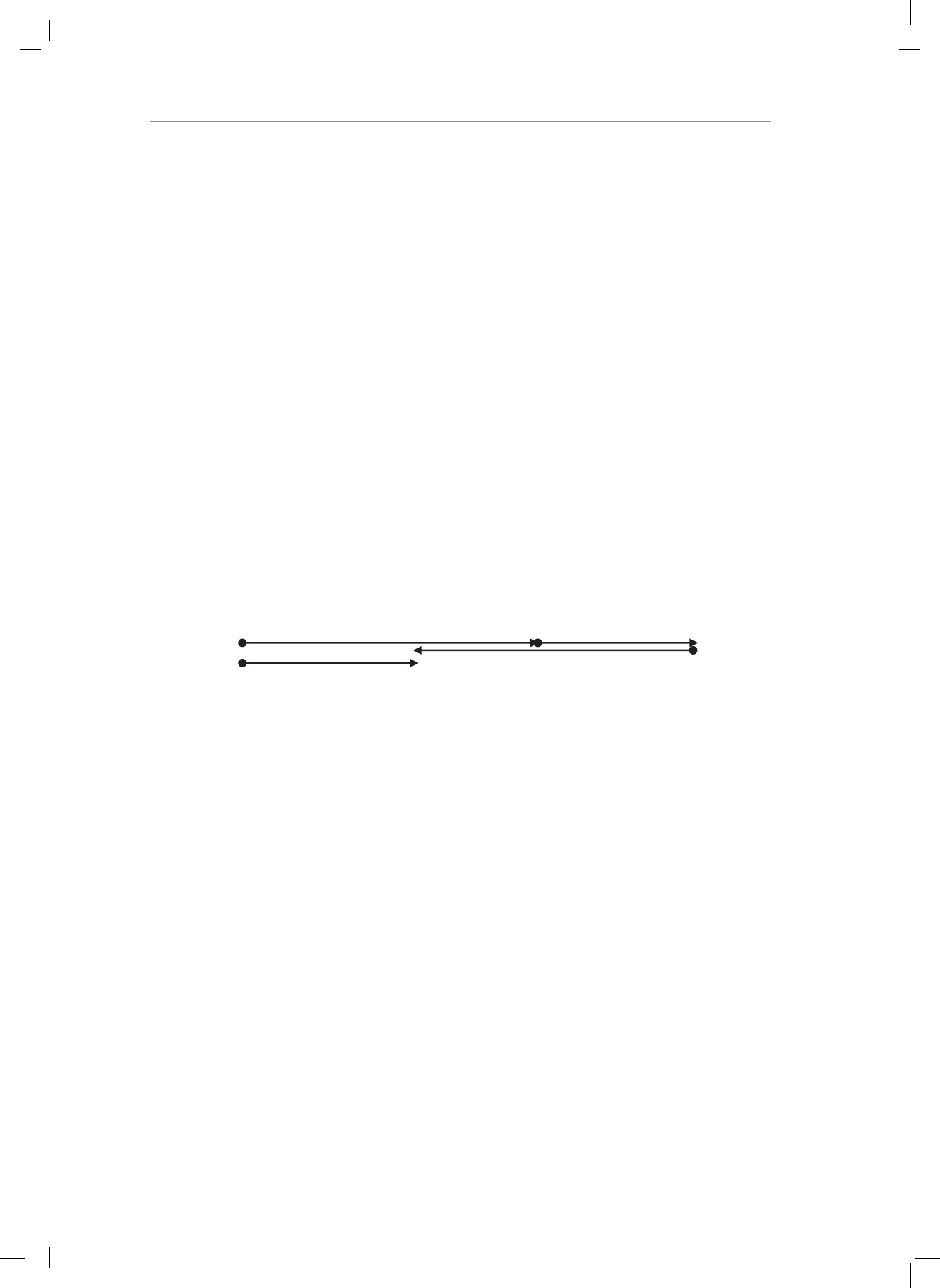
RESOURCE PACK
84 Grade 10 Physical Sciences
9. 9.1 Measurement of the scale length = 6 mm
erefore 6 mm represents 22 m.
Distance = (32 + 42 + 33 + 5 + 2) × 22
= 2 508 m (2,508 km) [CL 2] (3)
9.2 Measured distance from home to school = 54 mm
Displacement = 54 × 22 = 1 188 m south [CL 2] (2)
9.3 0 m (ere is no change in position because she has come home again.)
[CL 3] (1)
10 10.1 e resultant force is the single force which produces the same eect as all
the other forces acting together.
{
{
[CL1] (2)
10.2 ALTERNATIVE 1.
Choose ‘to the right” as the positive direction. (Choosing EITHER
direction as positive)
Resultant force = +37 + (+20) + (-35) = +22 N (Appropriate choice
of signs)
Resultant force = 22 N to the right (Accuracy; SI units;
direction) [CL 3] (6)
ALTERNATIVE 2.
Scale: 1 cm: 5 N
PAGE 84 QUESTION 11 (ORIGINALLY 5)
PAGE 86 QUESTION 9.2
ALTERNATIVE 1.
Choose ‘to the right” as the positive direction. ✓ (Choosing EITHER direction as positive)
Resultant force = +37✓ + (+20)✓ + (-35) ✓ = +22 N (Appropriate choice of signs)
Resultant force = 22 N ✓ to the right ✓ (Accuracy; SI units; direction)
[CL 3] (6)
ALTERNATIVE 2.
Scale: 1 cm: 5 N ✓
[CL 3] (6)
7,4 cm (37 N)
✓
4,0 cm (20 N)
✓
7,0 cm (35 N)✓
Resultant force: 4,4 cm i.e. 22 N ✓right✓
[CL3] (6)
11.1 Distance =
2 121+++
{
(method)
= 6 km
{
(accuracy; SI units) [CL2] (2)
11.2 0 m
{
{
[CL3]
(2)
11.3 637 m
{
South (S)
{
(accuracy; Si units) (direction) [CL3] (2)
11.4 Distance
211=++
{
(method)
= 5 km
{
(accuracy; SI units) [CL2] (2)
Gr10_Term3_ResourcePack.indb 84 2019/05/31 12:30:47 PM

Term 3 85
TOPIC 19: VECTORS
ASSESSMENTS
QUESTIONS
MULTIPLE CHOICE
1. A car accelerates from 10 ms
−1
to 30 ms
−1
in 2 s. What is the magnitude of the
car’s acceleration (in ms
−2
)?
A 0,5
B 0,1
C 10
D 20 (2)
2. Andile drives from town A to town B and back to town A in 2 hours. e
distance between town A and town B is 60 km. What is the magnitude of the
average velocity (in kmh
−1
) for the entire trip?
A 0
B 30
C 60
D 120 (2)
3. An object moves in the positive x-direction with positive velocity and a positive
constant acceleration a. Aer 3 s, its acceleration changes to a constant value
of −a. Which row of the table below is CORRECT concerning the velocity and
displacement of the object immediately aer this sudden change in acceleration
takes place?
Velocity Displacement
A Decreases and remains positive Increases
B Decreases and becomes negative Increases
C Increases and remains positive Decreases
D Increases and becomes negative Decreases
(2)
4. A truck driver is in a rush to deliver the load. She travels 45 km at an average
speed of 60 kmh
−1
. She returns along the same route at an average speed of
30kmh
−1
. What is her average speed (kmh
−1
) for the trip?
A 24
B 40
C 45
D 48 (2)
Gr10_Term3_ResourcePack.indb 85 2019/05/31 12:30:47 PM

RESOURCE PACK
86 Grade 10 Physical Sciences
5. e instantaneous velocity of an object is always equal to …
A the magnitude of the average speed of the object.
B the total displacement divided by the total time taken.
C a very small displacement of the object divided by time taken.
D the displacement of the object divided by the time taken over a very small
interval of time. (2)
LONG QUESTIONS
6. ere is no atmosphere on the Moon. Astronauts carried out experiments on
the lunar surface in the early 1970’s. In one such experiment when a feather was
dropped from rest, it fell 20,75 m in 5 s.
6.1 Calculate the average speed of the feather. (3)
6.2 Determine the acceleration of the feather using the fact that its average
speed is equal to its instantaneous speed at exactly halfway through the
time (that is, at 2,5 s). (4)
6.3 Would the feather fall at a faster or slower rate if it fell through a vacuum
on earth? (1)
7. A stone falls from rest from the top of a 15 m high cli. It is in the air for 1,75 s.
7.1 Calculate its average velocity. (4)
7.2 Its average velocity is equal to its instantaneous velocity at halfway through
the time (that is, at 0,875 s). Determine the magnitude of its velocity just
before it hits the ground. (3)
7.3 Dene acceleration. (2)
7.4 Calculate the magnitude of the stone’s acceleration. (3)
8. A professional cyclist is able to reach a speed of 100 kmh
−1
by starting from rest
and pedalling at out for a distance of 3 km along a straight track. Assume that
the rate of change of the cyclist’s speed is uniform.
8.1 Show that 100 kmh
−1
is equivalent to 27,78 ms
−1
. (2)
8.2 Calculate the average speed of the cyclist. (2)
8.3 Calculate how long (in minutes) it takes the cyclist to reach this top speed. (4)
9. A tractor accelerates uniformly from rest to 4 ms
−1
in 20 s. It then travels at a
steady speed for 440 m, and nally comes to rest 10 s later, having travelled a total
of 500 m.
9.1 Dene uniform acceleration. (3)
9.2 Calculate the magnitude of the acceleration of the tractor during the rst
20 s. (3)
9.3 Calculate the magnitude of the average velocity of the tractor for the entire
journey. (5)
9.4 Calculate the magnitude of the acceleration of the tractor during the last
10 s. (3)
Gr10_Term3_ResourcePack.indb 86 2019/05/31 12:30:47 PM
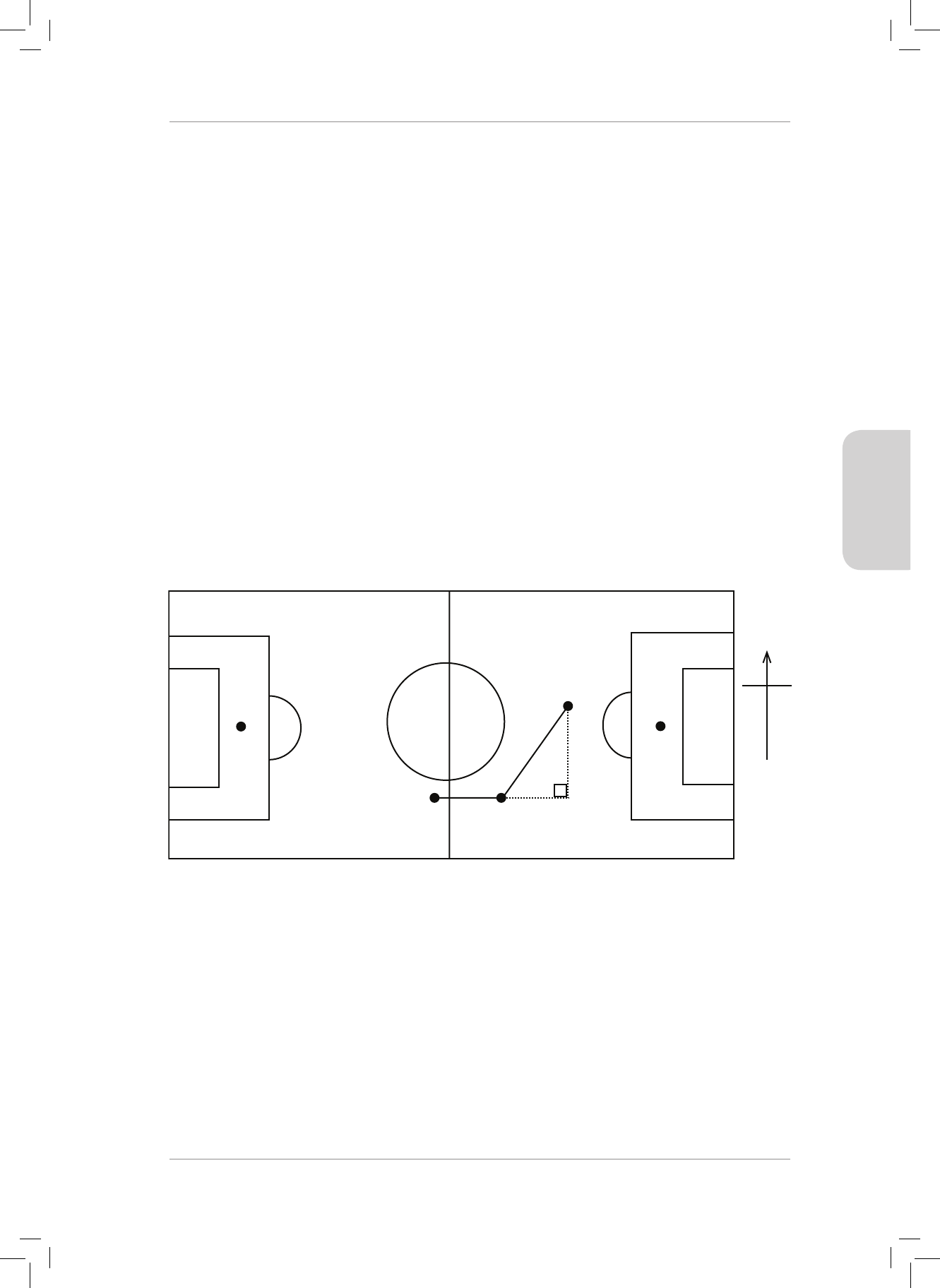
Term 3 87
TOPIC 20: ONE-DIMENSIONAL MOTION; AVERAGE SPEED, VELOCITY AND ACCELERATION
ASSESSMENTS
10. A boy throws a ball into the air from an initial height of 1,20 m. e ball travels
upwards to a maximum height of 0,60 m above his hand, then he allows it to fall
to the ground and catches it at the top of its bounce of 0,90 m.
10.1 Draw a labelled diagram of the ball’s position from its initial position A, to
its nal position D, taking the ground as the reference point. (Maximum
height occurs at position B and the bounce occurs at position D.) (4)
10.2 e ball takes 1,14 s to fall to the ground from the time it leaves the boy’s
hand. During this time, calculate:
10.2.1 the distance travelled by the ball. (3)
10.2.2 the average speed of the ball. (3)
10.2.3 the displacement of the ball. (3)
10.2.4 the magnitude of the average velocity of the ball. (3)
10.3 Explain why the magnitude of the resultant displacement of the ball when
the boy catches it at the top of its bounce is less than the total distance
travelled by the ball. (3)
*11. In a soccer match, a player runs 20 m due East in 10 s from position A to position
B (as shown in the diagram below). He then breaks through the opposition’s
defence and is able to run to position C (on a bearing of 034°) in another 10 s.
Position C is 20 m East of B and 30 m North of B.
A
B
C
30 m
20 m 20 m
N
36 m
56°
11.1 What is the dierence between distance and displacement? Illustrate your
answer with an example of each, referring to positions A, B and C, from
the situation above. (4)
11.2 Calculate the magnitude of the player’s average velocity ...
11.2.1 from A to B. (3)
11.2.2 from B to C. (3)
11.3 Draw an accurate labelled scale diagram to determine the magnitude of
the player’s resultant change in position from A to C. (5)
11.4 Calculate the player’s average speed from A to C. (3)
11.5 Calculate magnitude of the player’s average velocity from A to C. (3)
Gr10_Term3_ResourcePack.indb 87 2019/05/31 12:30:47 PM

RESOURCE PACK
88 Grade 10 Physical Sciences
MARKING GUIDELINES
MULTIPLE CHOICE
1. C
{
{
.
msa
t
v
2
30 10
10
2
D
D
==
-
=
-
[CL 2] (2)
2. A
{
{
.
average velocity
totaltime
totaldisplacement
km h
2
0
0
1
==
=
-
[CL 2] (2)
3. A
{
{
e car was moving forward at a particular velocity. When its
acceleration changes to a negative value, the driver has put her foot
on the brake. e car is slowing down. So its velocity decreases.
But it is still moving forward so its displacement increases (at a
decreasing amount). [CL 4] (2)
4. B
{
{
e car moves at 60 kmh
−1
for 45 km. It takes
,h
45
075
60
=
to
cover this distance.
On the return trip the car travels at 30 kmh
−1
. It covers the same
distance of 45 km.
It takes
,h
45
15
30
= to cover this distance.
e total distance covered it
km45 45 90+=
.
e total time taken
,,,h07515225=+=
.
ce
25
tan
.
Theaverage speed
totaldis
km h
90
40
1
===
-
,
totaltime
2
[CL 3] (2)
5. D
{
{
is is the denition of instantaneous velocity. [CL 1] (2)
LONG QUESTIONS
6. 6.1 Average speed
cetan
time
=
dis
{
(method)
,20 75
5
=
{
(substitutions)
.
,ms415
1
=
-
{
(accuracy; SI units) [CL2] (3)
6.2
a
t
v
D
D
=
{
(method)
,
,
415
25
=
{
(substitutions)
.
,ms166
2
=
-
{
downwards
{
(accuracy; SI units) (direction) [CL3] (4)
6.3 Faster (on earth)
{
[CL2] (1)
7. 7.1 Average velocity
cetan
time
=
dis
{
(method)
,
15
175
=
{
(substitutions)
.
,ms857
1
=
-
(accuracy; SI units)
downwards
{
(direction) [CL3] (4)
Gr10_Term3_ResourcePack.indb 88 2019/05/31 12:30:59 PM

Term 3 89
TOPIC 20: ONE-DIMENSIONAL MOTION; AVERAGE SPEED, VELOCITY AND ACCELERATION
ASSESSMENTS
7.2 Average velocity
vv
2
if
=
+
{
(method)
,
v
2
0
857
f
+
=
{
(substitutions)
.
,msv 17 14
f
1
=
-
{
(accuracy; SI units) [CL3] (3)
7.3 Acceleration is the rate of change of velocity.
{
{
[CL1] (2)
7.4
a
t
vv
fi
D
=
-
{
(method)
,
,
17 14 0
175
=
-
{
(substitutions)
.
,ms979
2
=
-
{
(accuracy; SI units) [CL2] (3)
8. 8.1
.
.
,km
hm
s100 100
60 60
1
27 78
11
#
#
{
==
--
000{
(method) [CL1] (2)
8.2
2
+
a
vv
fi
=
{
(method)
,0
2
28 78
=
-
(substitutions)
.
,ms13 85
1
=
-
{
(accuracy; SI units) [CL2] (2)
8.3 Average speed
cetan
time
=
dis
Time
cetan
average speed
=
dis
{
(method)
,13 85
3 000{
=
{
(conversion of km to m)
(substitutions)
,s21661=
,216 61
60
=
= 3,61 minutes (accuracy; SI units) [CL3] (4)
9. 9.1 e rate of change of velocity
{
{
is constant.
{
[CL1] (3)
9.2
2
+
a
vv
fi
=
{
(method)
40
20
=
-
(substitutions)
.
,ms02
2
=
-
(accuracy; SI units) [CL2] (3)
9.3 Average velocity
cetan
time
=
dis
{
(method)
Time
cetan
average velocity
=
dis
440
4
=
{
(substitutions)
s110=
Totaltimes20 110 10 140=+ +=
{
(accuracy)
.
,Average velocity ms
140
500
357
1
{
{
==
-
(accuracy; SI units) [CL4] (5)
Gr10_Term3_ResourcePack.indb 89 2019/05/31 12:31:18 PM

RESOURCE PACK
90 Grade 10 Physical Sciences
9.4
2
-
a
vv
fi
=
{
(method)
04
10
=
-
(substitutions)
.
,ms04
2
=
-
-
(accuracy; SI units) OR
.
,ms04
2
=
-
(accuracy; SI units) [CL3] (3)
10. 10.1
A
B
C
D
1,80 m
1,20 m
0,90 m
0,00 m
[CL3] (4)
10.2 10.2.1
,, ,m06 18 24{{+=
{
[CL3] (3)
10.2.2 average speed
cetan
time
=
dis
{
(method)
,
,
24
114
=
{
(substitutions)
.
,ms211
1
=
-
{
(accuracy; SI units) [CL2] (3)
10.2.3
,m120
{
{
down (accuracy; SI units) (direction) [CL2] (3)
10.2.4
cetan
average velocity
time
{=
dis
(method)
,
,
120
144
=
{
(substitutions)
.
,ms083
1
=
-
{
(accuracy; SI units) [CL3] (3)
10.3 e magnitude of the resultant displacement of the ball is equal to its nal
position minus its initial position.
,,x 090120D
=
-
,030=-
,mdownward030
=
{
e total distance travelled
,,,06 18 09=++
,m33=
{
e total distance is equal to its path length, whereas the resultant
displacement is its change in position.
{
[CL3] (3)
Gr10_Term3_ResourcePack.indb 90 2019/05/31 12:31:31 PM
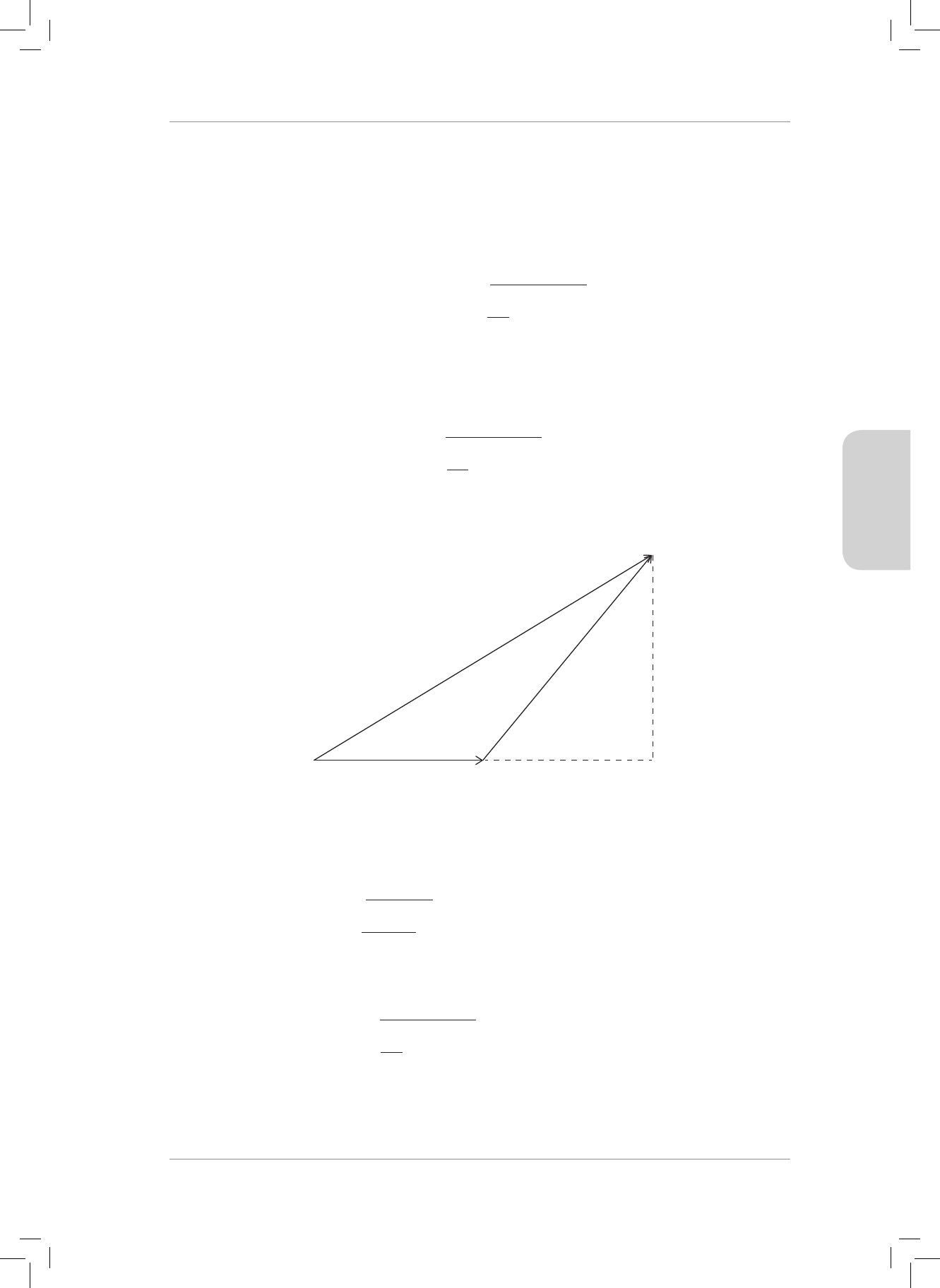
Term 3 91
TOPIC 20: ONE-DIMENSIONAL MOTION; AVERAGE SPEED, VELOCITY AND ACCELERATION
ASSESSMENTS
*11. 11.1 Distance is path length
{
e.g. when the player moved from A to B to C, the
distance is equal to the length of AB + the length of AC.
{
Displacement is the change in position
{
e.g. when the player moves from
A to B passing through C his displacement is the length of AC and the
direction is in the direction from A to C.
{
[CL2] (4)
11.2 11.2.1 Average velocity (A to B)
displacement
time
=
{
(method)
20
10
=
{
(substitutions)
.
ms2
1
=
-
{
(accuracy; SI units)
[CL3] (3)
11.2.2 Displacement from B to C = 36 m
{
(accuracy)
Average velocity (B to C)
displacement
time
= (method)
10
36
=
(substitutions)
.
,ms36
1
=
-
{
(accuracy; SI units)
[CL3] (5)
11.3
AB
C
Scale: 1 cm = 4 m
{
(appropriate scale)
Correct lengths and labels
{
{
{
Displacement = 46 m
{
(allow 45 m – 48 m error in measurement)
[CL4] (5)
11.4 Average speed
cetan
time
=
dis
{
(method)
20
20 36
=
+
{
(substitutions)
.
,ms28
1
=
-
{
(accuracy; SI units)
[CL3] (3)
11.5 Average velocity
displacement
time
=
{
(method)
20
46
=
{
(substitutions; c.o.e.)
.
,ms23
1
=
-
(accuracy; SI units)
[CL3] (3)
Gr10_Term3_ResourcePack.indb 91 2019/05/31 12:31:40 PM

RESOURCE PACK
92 Grade 10 Physical Sciences
QUESTIONS
MULTIPLE CHOICE
1. Which ONE of the following statements is TRUE of a body that accelerates at a
constant rate?
A e rate of change of velocity with time remains constant.
B e velocity of the body increases by increasing amounts in equal time
intervals.
C e position changes by the same amount in equal time intervals.
D e rate of change of position with time remains constant. (2)
2. Joseph leans on the railing of a tall building. His cell phone drops out of his hand
and falls to the ground. Ignoring any eects of air resistance, which ONE of
the following combinations of velocity and acceleration correctly describes the
motion of the cell phone?
Velocity Acceleration
A Increases Increases
B Decreases Increases
C Remains constant Remains constant
D Increases Remains constant
(2)
3. Which quantity does the area under a velocity – time graph represent?
A distance
B displacement
C acceleration
D position (2)
4. Which quantity does the gradient of a velocity – time graph represent?
A distance
B displacement
C acceleration
D position (2)
Gr10_Term3_ResourcePack.indb 92 2019/05/31 12:31:40 PM

Term 3 93
TOPIC 21: GRAPHS AND EQUATIONS OF MOTION
ASSESSMENTS
5. Which graph correctly shows the variation of position versus time for an object
moving with constant velocity towards you?
A
∆x ∆x ∆x ∆x
(m)
0
0
t (s)
(m)
0
0
t (s)
(m)
0
0
t (s)
(m)
0
0
t (s)
BCD
(2)
6. Which of the following statements is/are TRUE about a vehicle travelling at a
constant velocity?
I It travels in a straight line.
II It travels at the same speed as the magnitude of its velocity.
III Its displacement increases by the same amount in each time interval.
A I only
B I and II only
C II and III only
D All the statements are true. (2)
7. Which of the following statements is TRUE when a body moves in a straight line
from rest with uniform acceleration?
I Its velocity increases by equal amounts in equal time intervals.
II It travels equal distances in equal time intervals.
III e distance travelled is directly proportional to the square of the
time taken.
A I only
B III only
C I and II only
D I and III only (2)
Gr10_Term3_ResourcePack.indb 93 2019/05/31 12:31:40 PM
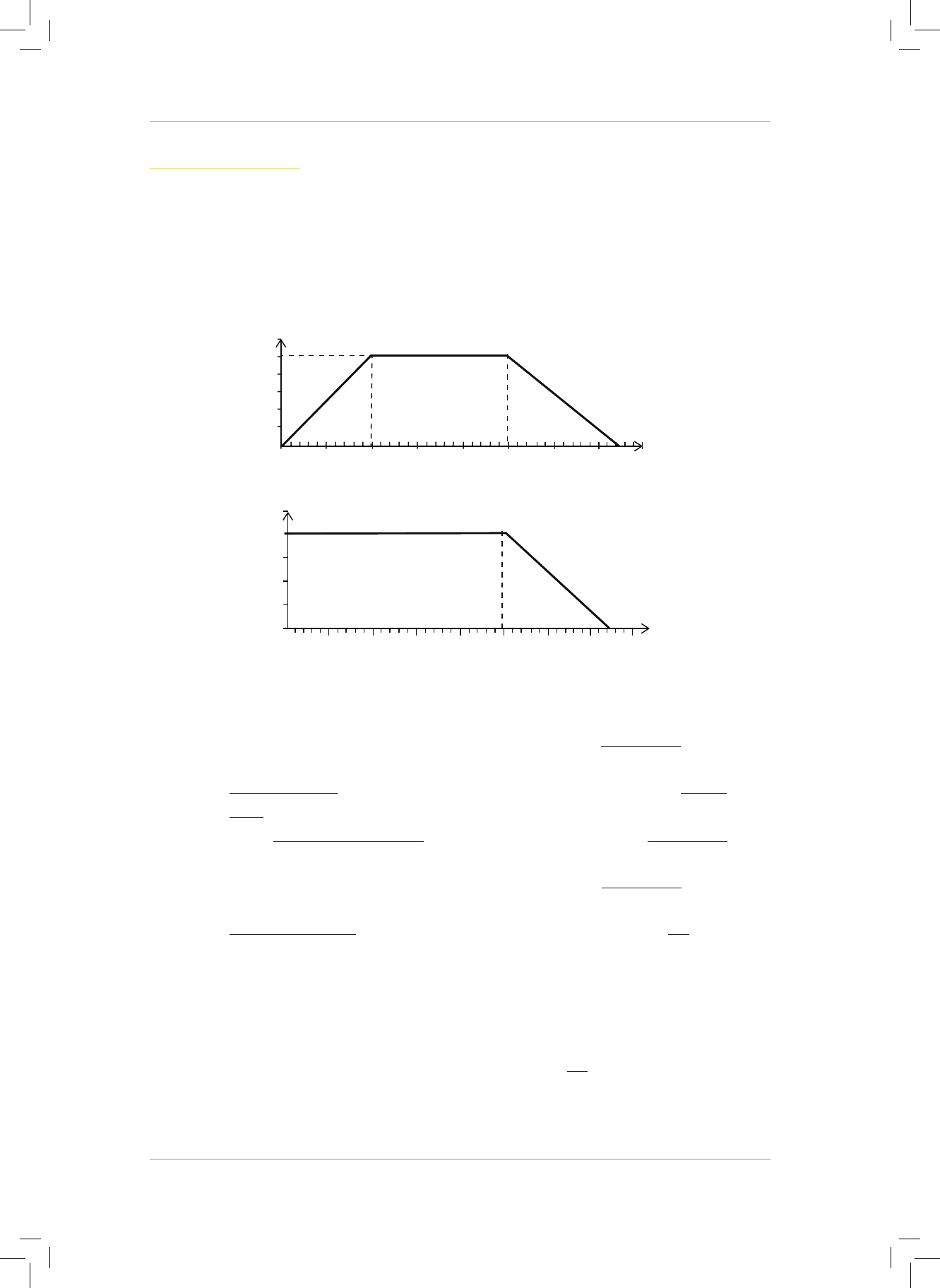
RESOURCE PACK
94 Grade 10 Physical Sciences
LONG QUESTIONS
8. A car goes through a speed trap while it is travelling along a straight horizontal
road. At the exact instant that the car passes the speed trap, a trac ocer sitting
on her motorcycle at the side of the road sets o from rest to catch up with the
car. When she catches up with the car, the ocer orders the driver to stop and the
driver immediately slows down and stops the car.
v (m
.
s
-1
)
A
BC
60
50
40
30
20
10
0
0510 15 20 25 30
35
40
D
t (s)
Motor cycle
Car
AB
C
v (m
.
s
-1
)
50
40
30
20
10
0
D
0510 15 20 25 30 40
t (s)
35
e graphs above show the motion of the motor cycle and the car from the
moment when the car passes through the speed trap.
8.1 Describe the motion (no displacements needed) of the motor cycle from A
to D. (3)
8.2 Using the graph, calculate the magnitude of the acceleration of the motor
cycle from A to B. (3)
8.3 Using an equation of motion, calculate the acceleration of the motor cycle
from C to D. (4)
8.4 Draw an acceleration-time graph for the motion of the motor cycle from A
to D. (5)
8.5 Use the car’s graph to determine how far from the speed trap the car
stopped. (4)
8.6 e speed limit on the road is 120 kmh
−1
. By how much was the car
exceeding the speed limit? (3)
8.7 e ne for exceeding the speed limit is R25,00 per kmh
−1
over the limit.
How much did the trac ocer ne the driver of the car? (2)
8.8 Draw a position-time graph for the motion of the car from A to D. (4)
Gr10_Term3_ResourcePack.indb 94 2019/05/31 12:31:41 PM
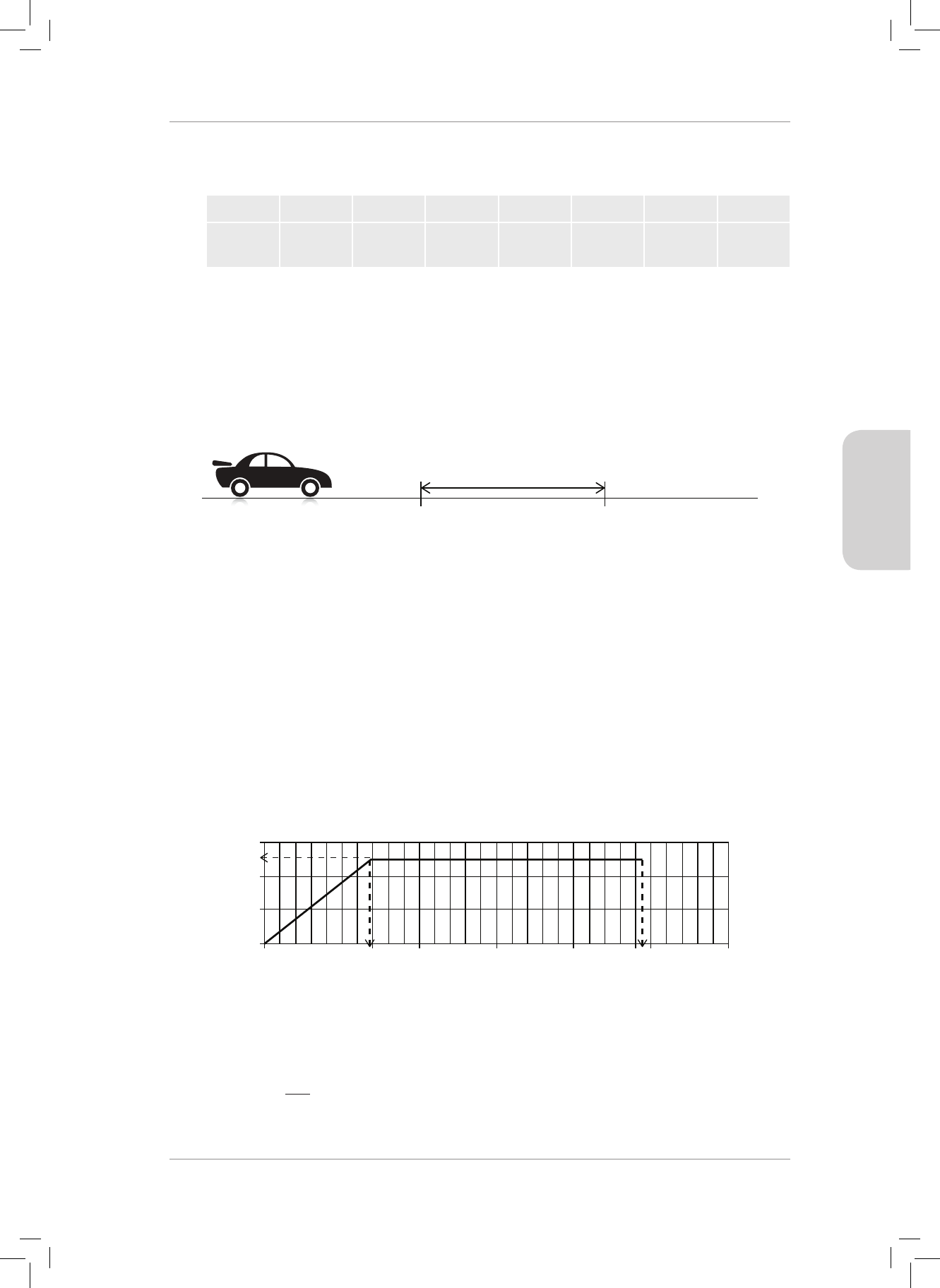
Term 3 95
TOPIC 21: GRAPHS AND EQUATIONS OF MOTION
ASSESSMENTS
9. e speed of a car between two sets of trac lights changes is shown in the table
below.
Time (s) 0 20 40 60 80 100 120
Speed
(m·s
−1
)
0,0 2,5 5,0 7,5 10,0 5,0 0,0
9.1 On a piece of graph paper, plot a speed-time graph of the car’s motion. (6)
9.2 Determine the acceleration of the car over the rst 40 s. (4)
9.3 Determine the acceleration of the car over the last 20 s. (4)
9.4 How far (in m) did the car travel during these 2 minutes? (4)
10. In a test drive on a dry road, the driver was instructed to travel at 30 ms
−1
and
to apply the brakes to stop the car when he passed a roadside marker X. e car
stopped 75 m beyond X. e point where the car stopped was labelled Y.
XY
75 m
10.1 What was the average speed of the car between X and Y? (3)
10.2 How long (in s) did it take for the car to stop? (3)
10.3 Calculate the car’s acceleration. (4)
10.4 is test was done on a dry road surface. How would magnitude of the
acceleration dier on a wet road? (1)
10.5 Why would the magnitude of the acceleration dier? Explain briey. (3)
11. e 100 metres, or 100-metre dash, is a sprint race in track and eld
competitions. e reigning 100 m Olympic champion is oen named “the fastest
man/woman in the world”. On 16 August 2009, Usain Bolt (Jamaica), set a new
world record for the men's 100 m in Berlin. He completed the race in 9,58s.
[Source: Wikipedia (08 October 2011)]
e following velocity-time graph is a simplied representation of Usain’s motion
over the duration of the race:
Velocity (m/s)
15
10
5
0
02
2,74
468
9,58
10 12
Time (s)
13
11.1 Determine Usain Bolt’s acceleration over the rst 2,74 s. (4)
11.2 Use the graph to determine how far he ran during the rst 2,74 s. (4)
11.3 Use an equation of motion to conrm your answer in 11.2. (4)
11.4 Give two reasons why we can use equations of motion to calculate values
in this question. (2)
Gr10_Term3_ResourcePack.indb 95 2019/05/31 12:31:41 PM
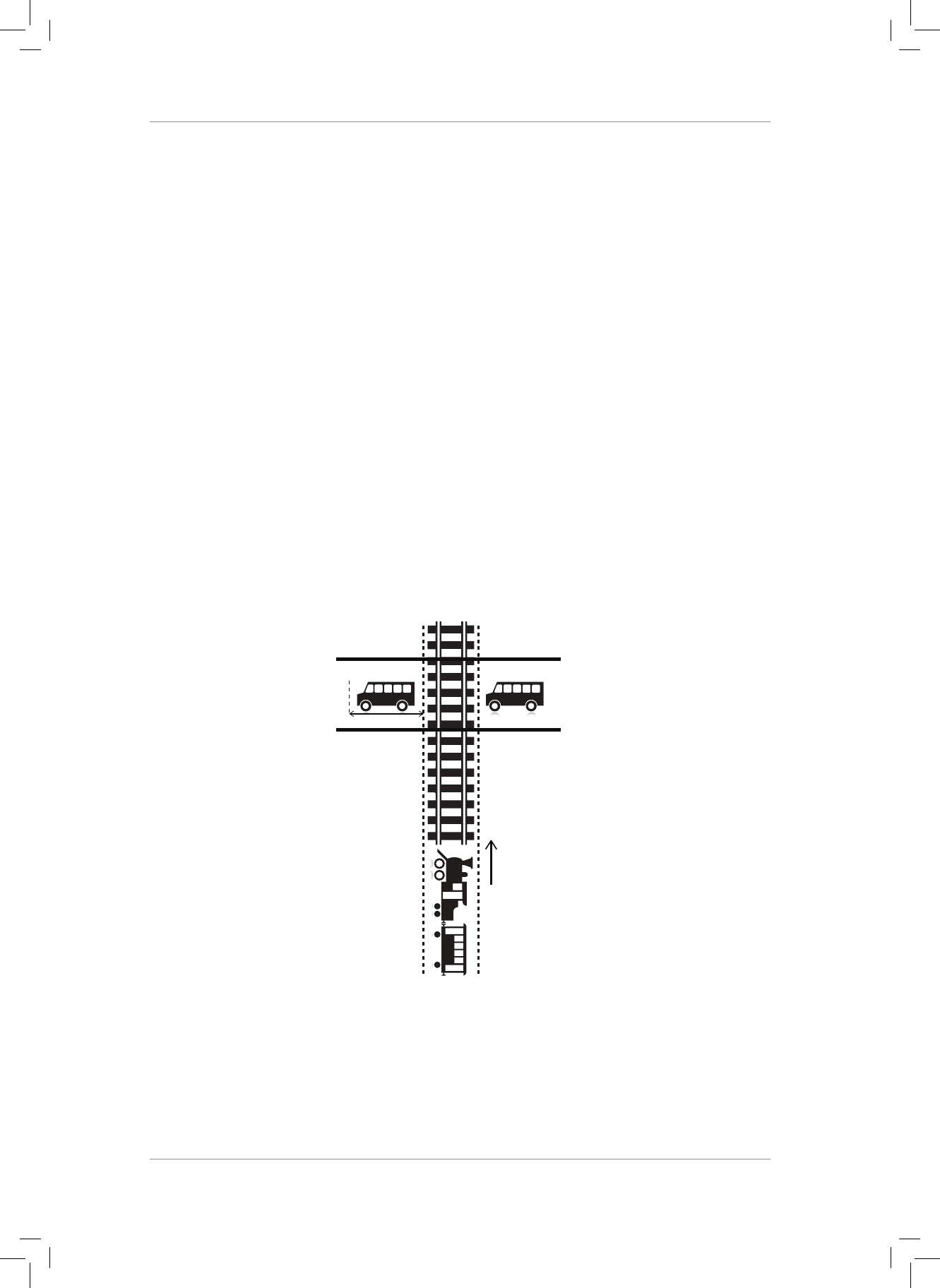
RESOURCE PACK
96 Grade 10 Physical Sciences
12. A car accelerates uniformly at 3,5 ms
−1
from a speed of 10 ms
−1
for 5 s along a
straight horizontal road.
12.1 Dene uniform acceleration. (3)
12.2 Calculate the velocity of the car at 5 s. (4)
12.3 Calculate how far the car travelled in 5 s. (4)
13. e driver of a car travelling at 30 ms
−1
along a straight road brakes suddenly to
a stop to avoid hitting a cow that is standing in the road. It takes him 3 s from the
time he sees the cow to the time when he applies the brakes. ese 3 s are called
the “reaction time”. He slows down at a rate of 4 ms
−2
.
13.1 What distance does the car cover during the 3 s of reaction time? (3)
13.2 What distance does the car cover during the time when the brakes are
applied? (4)
13.3 Draw a neat velocity – time graph of the car’s motion from the time the
driver rst saw the cow to the time that the car was brought to a stop. If
necessary calculate any relevant values which you need to draw this graph. (7)
14. A train travels at a constant velocity of 22 ms
−1
along a straight railway track
towards a level crossing. A mini bus, which is 4,5 m long, is stationary at the level
crossing. e mini bus driver decides to cross the track. e mini bus is capable
of accelerating at 2 ms
−2
and the width of the track is 2,5 m.
Train
22 m
.
s
-1
Final position
of mini bus
Original position
of mini bus
4.5 m
14.1 Calculate the shortest time it takes the mini bus to cross the railway track. (4)
14.2 How far away must the train be if the mini bus is to cross the track in
front of the train without colliding with it? Assume the train maintains a
constant velocity. (4)
Gr10_Term3_ResourcePack.indb 96 2019/05/31 12:31:42 PM

Term 3 97
TOPIC 21: GRAPHS AND EQUATIONS OF MOTION
ASSESSMENTS
MARKING GUIDELINES
MULTIPLE CHOICE
1. A
{
{
Acceleration is the rate of change of velocity. When acceleration is
constant, the rate of change of velocity is constant. [CL 2] (2)
2. D
{
{
e velocity increases. Acceleration is constant (acceleration due to
gravity remains constant). [CL 3] (2)
3. B
{
{
e area under a speed – time graph represents distance; the area
under a velocity – time graph represents displacement. [CL 3] (2)
4. C
{
{
Acceleration is represented by the gradient of a velocity – time
graph because
a
t
v
D
D
=
[CL 2] (2)
5. B
{
{
When the object approaches you it starts o far away from you
(at a greater position). Its position decreases until when it is at
position = 0 m, it is beside you. e only possible choices are B
and D. But the object moves towards you with a constant velocity,
therefore the graph will be a straight-line graph (since the gradient
(velocity) remains constant). [CL 3] (2)
6. D
{
{
When the velocity is constant, the magnitude of the velocity is
constant, and the direction is constant. e magnitude of the
velocity is equal to the speed because the distance has the same
magnitude as the displacement. [CL 2] (2)
7. D
{
{
At constant acceleration, the velocity increases by the same
constant amount in each second. Since the object accelerates from
rest, its initial velocity is 0 ms
−1
.
xv
ta
t
2
1
i
2
DD D+
=
xa
t
2
1
2
DD
=
erefore, displacement is directly proportional to the square of
time. [CL 3] (2)
LONG QUESTIONS
8. 8.1 A to B: Constant (uniform) acceleration (from rest to 50 ms
−1
)
{
B to C: Constant (uniform) velocity (of 50 ms
−1
)
{
C to D: Constant (negative) acceleration (from 50 ms
−1
to rest)
{
OR slowing down at a constant rate
OR constant deceleration. [CL2] (3)
Gr10_Term3_ResourcePack.indb 97 2019/05/31 12:31:49 PM
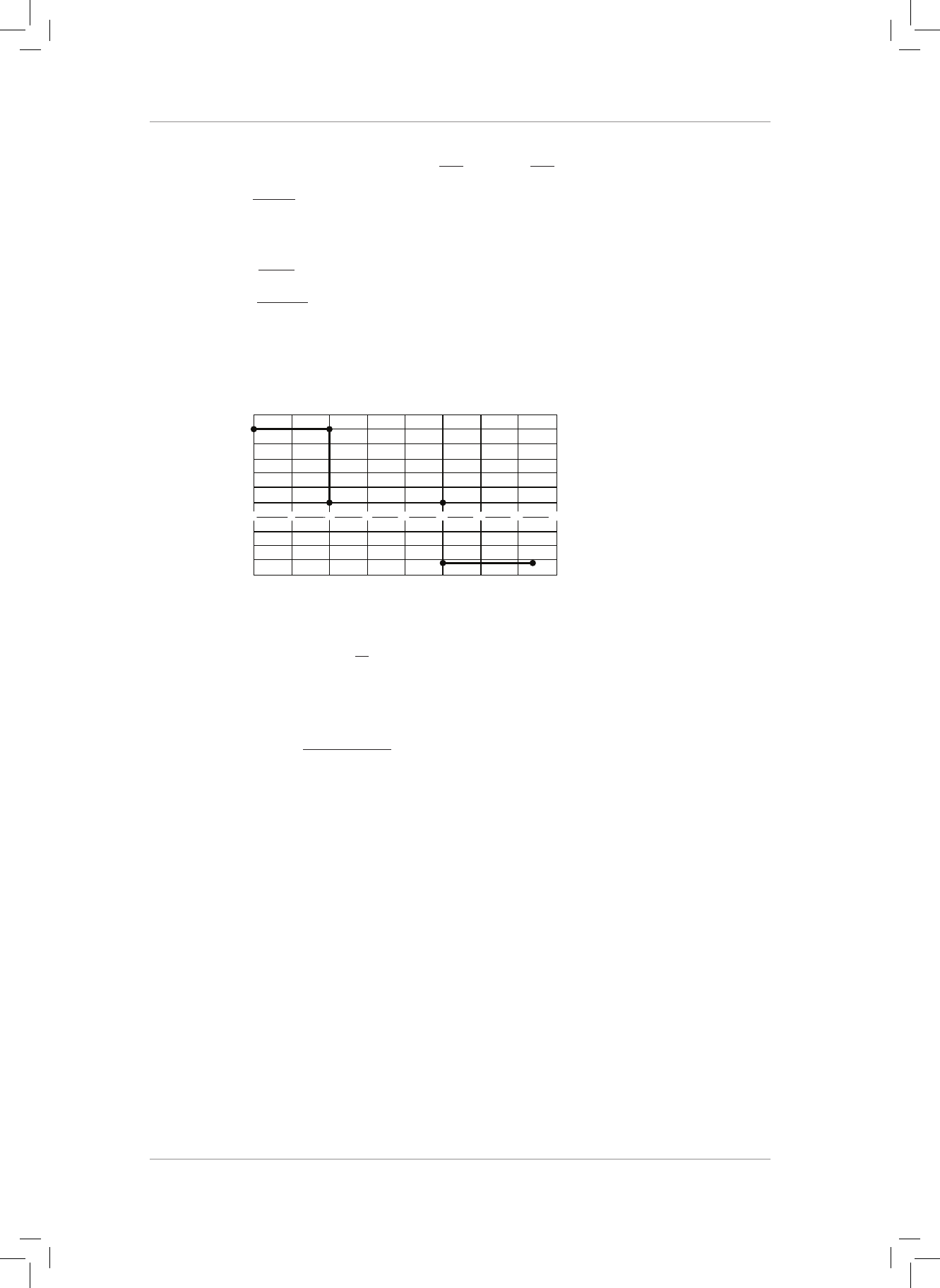
RESOURCE PACK
98 Grade 10 Physical Sciences
Acceleration (m
.
s
-2
)
Time (s)
Time (s)
6
5
4
3
2
1
0
-1
-2
-3
-4
-5
0510 15 20 25 30 35 40
6
5
4
3
2
1
0
-1
-2
-3
-4
-5
0510 15 20 25 30 35 40
8.2 a = gradient of the graph OR
x
y
D
D
OR
t
v
{
D
D
(method)
50 0
10 0
{=
-
-
(substitutions)
.
ms5
2
{
=
-
(accuracy; SI units) [CL2] (3)
8.3
a
t
vv
fi
{
D
=
-
(method)
37 25
050
{=
-
-
(substitutions)
.
,ms417
2
{
=
-
-
(accuracy; SI units)
.
,ms417
2
=
-
backwards (in the opposite direction)
{
(direction) [CL3] (4)
8.4
{
y-axis
{
x-axis
{
0-10 s
{
10 – 25 s
{
25 – 37 s
[CL3] (5)
8.5
tgraph {
-
area under vx
D
=
(method)
()()25 40 37 25 50
2
1
##{{
=+-
(substitutions)
m1300 {
=
(accuracy; SI units)
[CL3](4)
8.6
.
ms50
1
50 60 60
1
##
{
=
-
000
(method)
.
km h180
1
{
=
-
(accuracy)
Car exceeds speed limit by
.km h180 120 60
1
{-=
-
(accuracy; SI units)
[CL2](3)
8.7
.Fine R60 25 00# {=
(method; c.o.e.)
R1500 {
=
(accuracy; units)
[CL2] (2)
Gr10_Term3_ResourcePack.indb 98 2019/05/31 12:32:02 PM
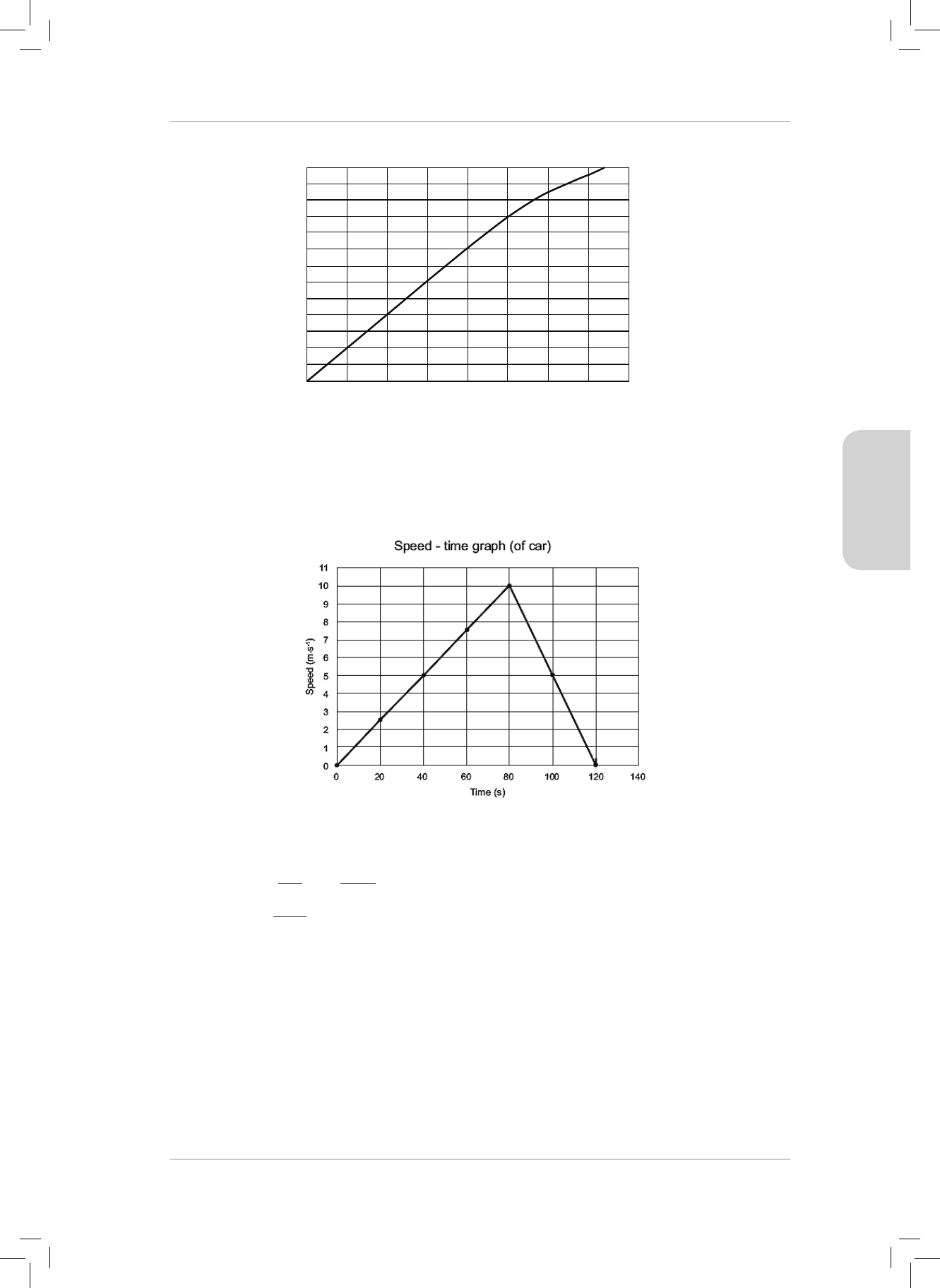
Term 3 99
TOPIC 21: GRAPHS AND EQUATIONS OF MOTION
ASSESSMENTS
8.8
Displacement (m)
1300
1200
1100
1000
900
800
700
600
500
400
300
200
100
0
0510 15 20 25 30 35 40
Time (s)
{
Vertical axis: shows 0, 1 000 and 1 300 (c.o.e.)
{
Horizontal axis: shows 0, 25, and 37
{
Straight line from 0 to 25 s
{
Parabola curving down (as shown) [CL4] (4)
9. 9.1
PAGE 99 PLEASE REPLACE THE GRAPH
{
Title
{
{
Axes titles and scales
{
Points plotted accurately
{
{
Two straight lines [CL2] (6)
9.2
ORa
t
v
t
vv
fi
{
D
D
D
=
-
(method)
40
50
{=
-
(substitutions)
.
,(,)ms0 125 013
2
{
=
-
(accuracy; SI units)
forward
{
(direction) [CL2] (4)
Gr10_Term3_ResourcePack.indb 99 2019/05/31 12:32:06 PM

RESOURCE PACK
100 Grade 10 Physical Sciences
9.3
ORa
t
v
t
vv
fi
D
D
D
=
-
20
510
{
{
=
-
(substitutions)
25 {,0=-
(accuracy)
{
.
,ms backward025
2
-
(SI units; direction) [CL3] (4)
9.4 Distance = area under speed – time graph
{
(method)
80 10 20 10
2
1
2
1
## ##
{{=+
(substitutions)
= 500 m
{
(accuracy; SI units) [CL2] (4)
10. 10.1 Average speed
()vv
2
1
fi
{
=
+
(method)
()
30 0
2
1
{
=+
(substitutions)
.
ms15
1
{
=
-
(accuracy; SI units) [CL3] (3)
10.2
cetan
Average speed
time
{=
dis
(method)
time
15
75
{=
(substitutions)
Time s
15
75
5 {==
(accuracy; SI units) [CL2] (3)
10.3
vv ax2
fi
22
{D
=
+
(method)
() ()a030275
2
{
=
+
(substitutions)
.
msa
275
900
6
2
#
{
=
-
=
-
-
(accuracy; SI units)
.
ms backward6
2
{
-
(direction) [CL2] (4)
10.4 It would decrease.
{
[CL3] (1)
10.5 e road would be slippery.
{
e time taken to stop the car would increase.
{
Since
a
t
v
D
D
=
{
, (and the time has increased,) the magnitude of the
acceleration decreases. [CL4] (3)
11. 11.1
ORa
t
v
t
vv
fi
{
D
D
D
=
-
(method)
,274
13 0
{=
-
(substitutions)
.
,ms474
2
{
=
-
(accuracy; SI units)
forward
{
(direction) [CL2] (4)
Gr10_Term3_ResourcePack.indb 100 2019/05/31 12:32:21 PM

Term 3 101
TOPIC 21: GRAPHS AND EQUATIONS OF MOTION
ASSESSMENTS
11.2 Distance = area under v-t graph
{
(method)
(,)13 274
2
1
#
{{
=
(substitutions)
,m17 81 {
=
(accuracy; SI units) [CL2] (4)
11.3 ALTERNATIVE 1
() ()
,,
mxvvt
2
1
2
1
013274 17 81
if
##
{{{
{
DD
=
+
=
+
=
(method) (substitutions) (accuracy; SI units)
ALTERNATIVE 2
(, )(,)
,m
xvtat
2
1
0
2
1
474274 17 79
i
22
{{{
{
DD D
=
+
=
+
=
(method) (substitutions) (accuracy; SI units)
ALTERNATIVE 3
vv ax2
fi
22
{D
=
+
(method)
() (, ) x13 02474
2
{ {
D
=
+
(substitutions)
,mx 17 83 {
D
=
(accuracy; SI units)
e slight dierences in the values of these answers are due to round up
errors. ese dierences can be ignored. [CL2] (4)
11.4 e acceleration is uniform (constant).
{
e motion takes place along a straight line.
{
[CL3] (2)
12. 12.1 Uniform acceleration is the constant
{
rate of change of velocity.
{
{
[CL1] (3)
12.2
vvat
fi
{D
=
+
(method)
,10 35 5# {=+
(substitutions)
.
,msforwards27 5
1
{
{
=
-
(accuracy; SI units) (direction)
[CL2]
(4)
12.3
xvtat
2
1
i
2
{
DD D
=
+
(method)
()(, ())10 53510
2
1
2
##{{
=+
(substitutions)
= 225 m
{
(accuracy; SI units) [CL2] (4)
13. 13.1
ce average speed time
#
=tanDis
{
(method)
30 3#=
{
(substitutions)
m90=
{
(accuracy; SI units) [CL2] (3)
13.2
vv ax2
fi
22
D
=
+
{
(method)
() ()x03024
2
{
D
=
+
-
{
(substitutions)
,mx 112 5D
=
{
(accuracy; SI units) [CL2] (4)
Gr10_Term3_ResourcePack.indb 101 2019/05/31 12:32:36 PM
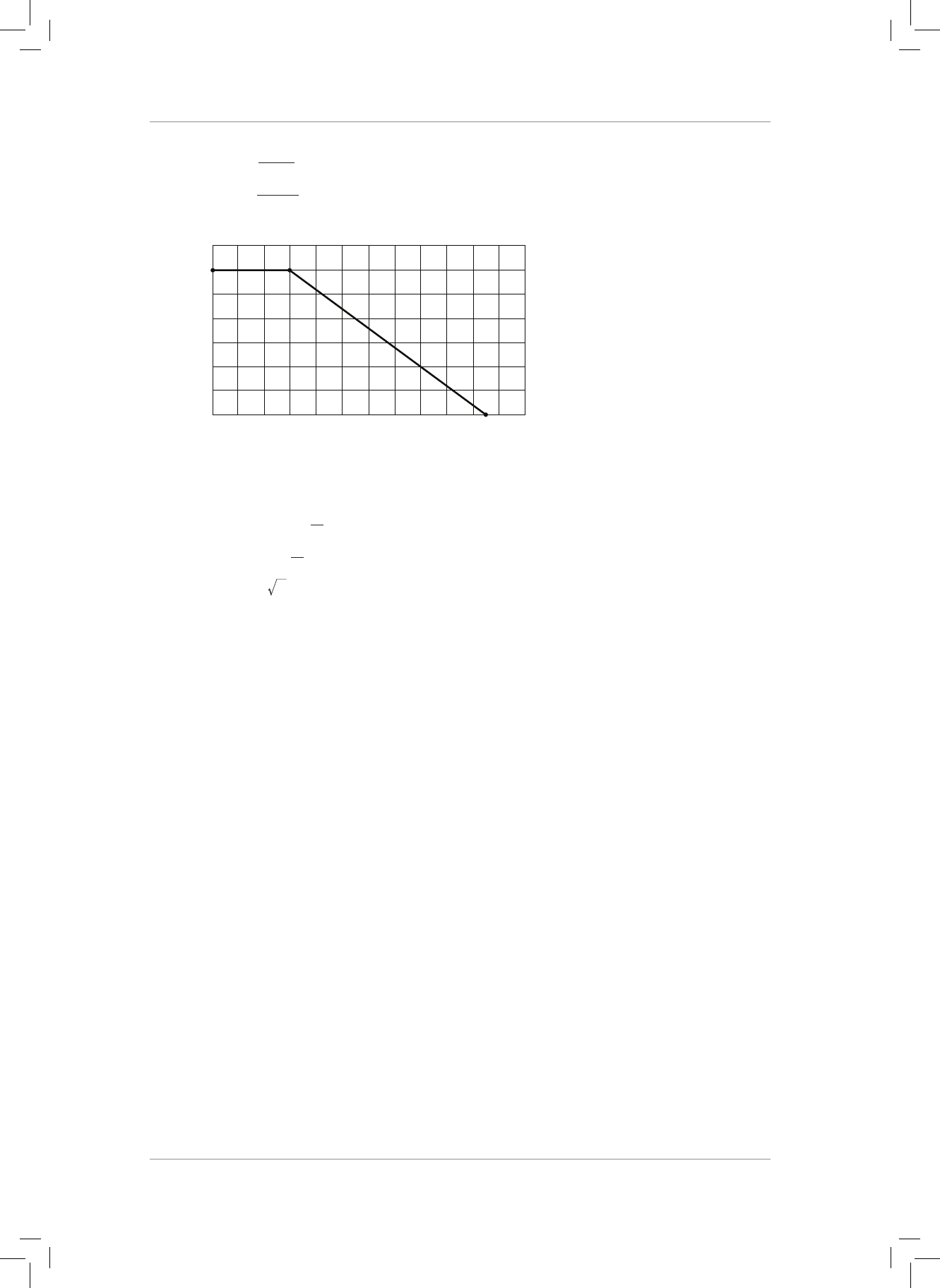
RESOURCE PACK
102 Grade 10 Physical Sciences
Velocity (m
.
s
-1
)
35
30
25
20
15
10
5
0
01 23 45678910 11 12
Time (s)
13.3
a
t
vv
fi
D
=
-
{
(method)
4
030
=
-
-
{
(substitutions)
,s75=
{
(accuracy; SI units)
{
y-axis: labels and scale
{
x-axis: labels and scale
(including 10,5 s)
{
0 – 3 s
{
3 – 10,5 s
[CL3] (7)
14. 14.1 e mini bus must move a minimum distance of
,,mm25 45 7+=
{
xv
ta
t
2
1
i
2
DD D+
=
{
(method)
() t70
2
1
2
2
D
=
+
{
(substitutions)
t 7
D
=
,s265=
{
(accuracy; SI units) [CL3] (4)
14.2
ce average speed time#=tanDis
{
(method)
,22 265#=
{
(substitutions)
,m58 3=
{
(accuracy; SI units)
At least 58,3 m (more than 58,3 m)
{
(interpretation of answer) [CL3] (4)
Gr10_Term3_ResourcePack.indb 102 2019/05/31 12:32:45 PM
